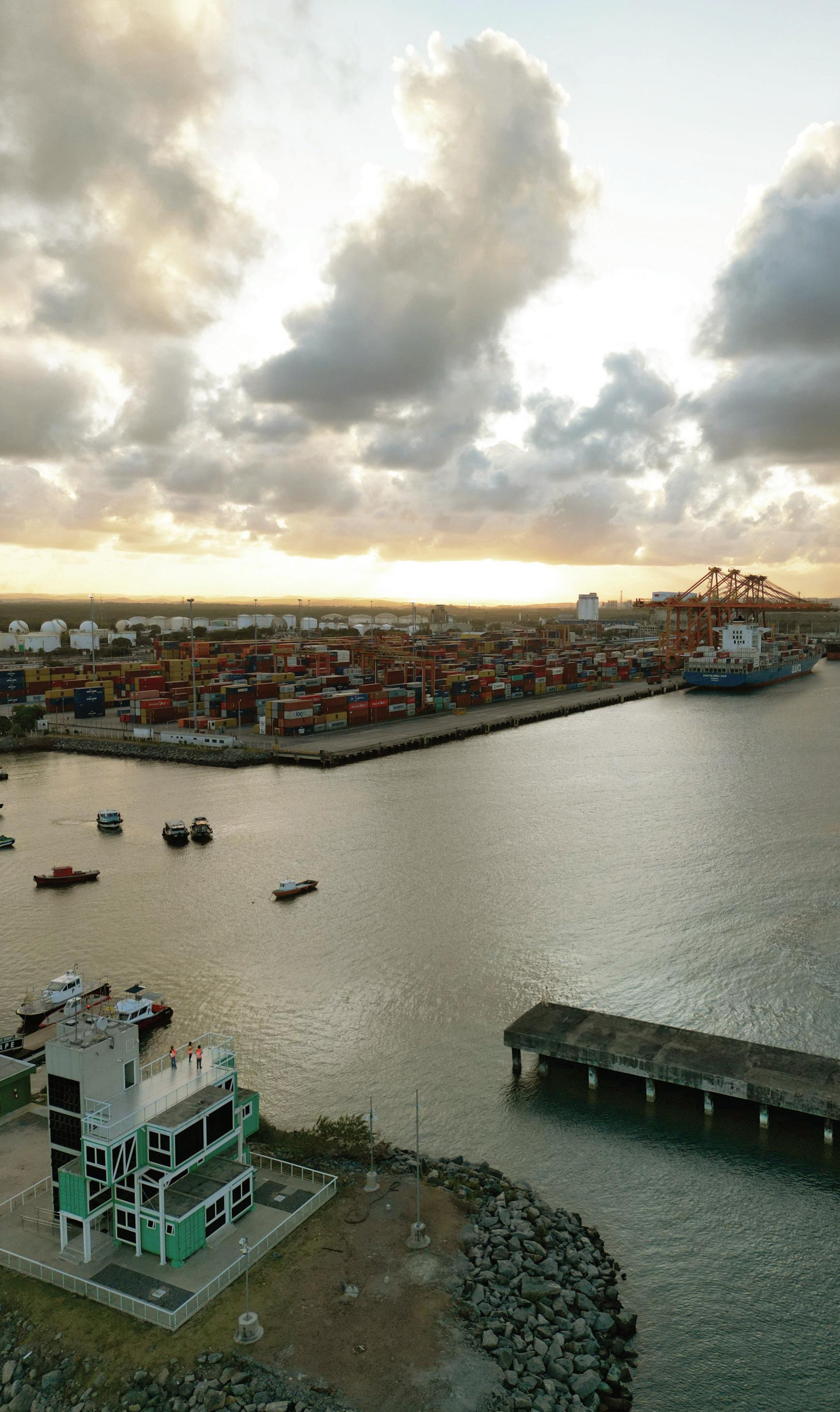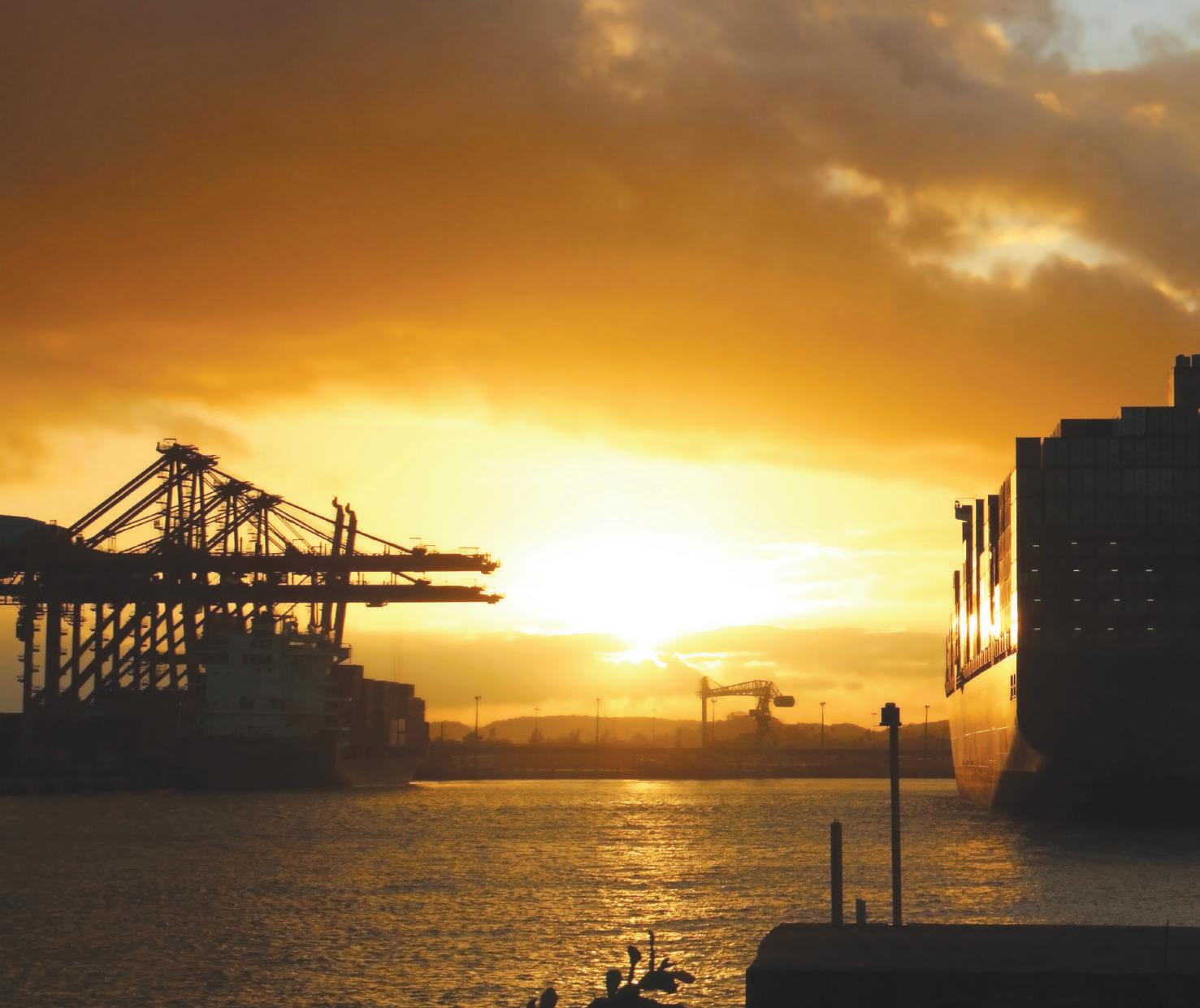





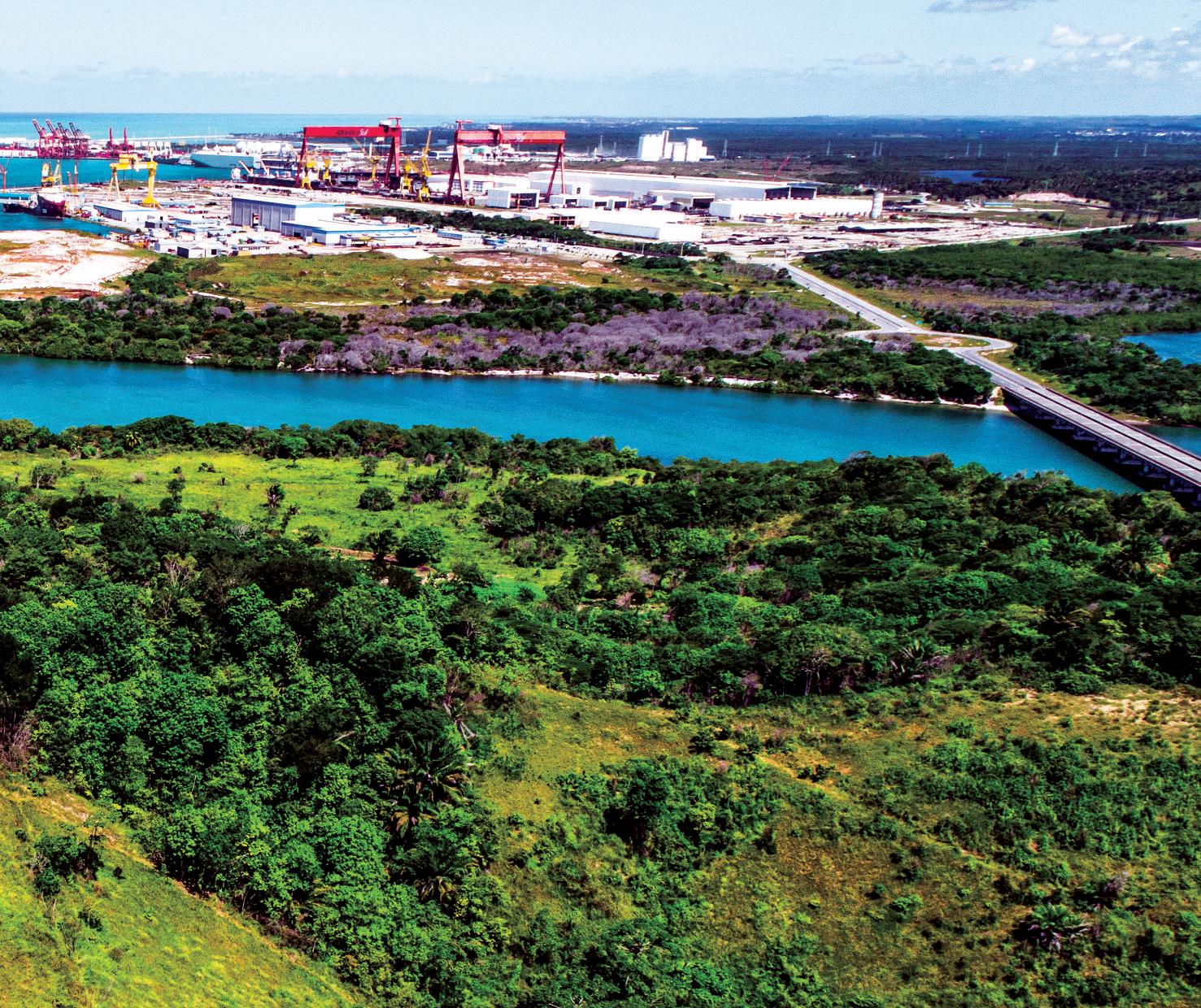
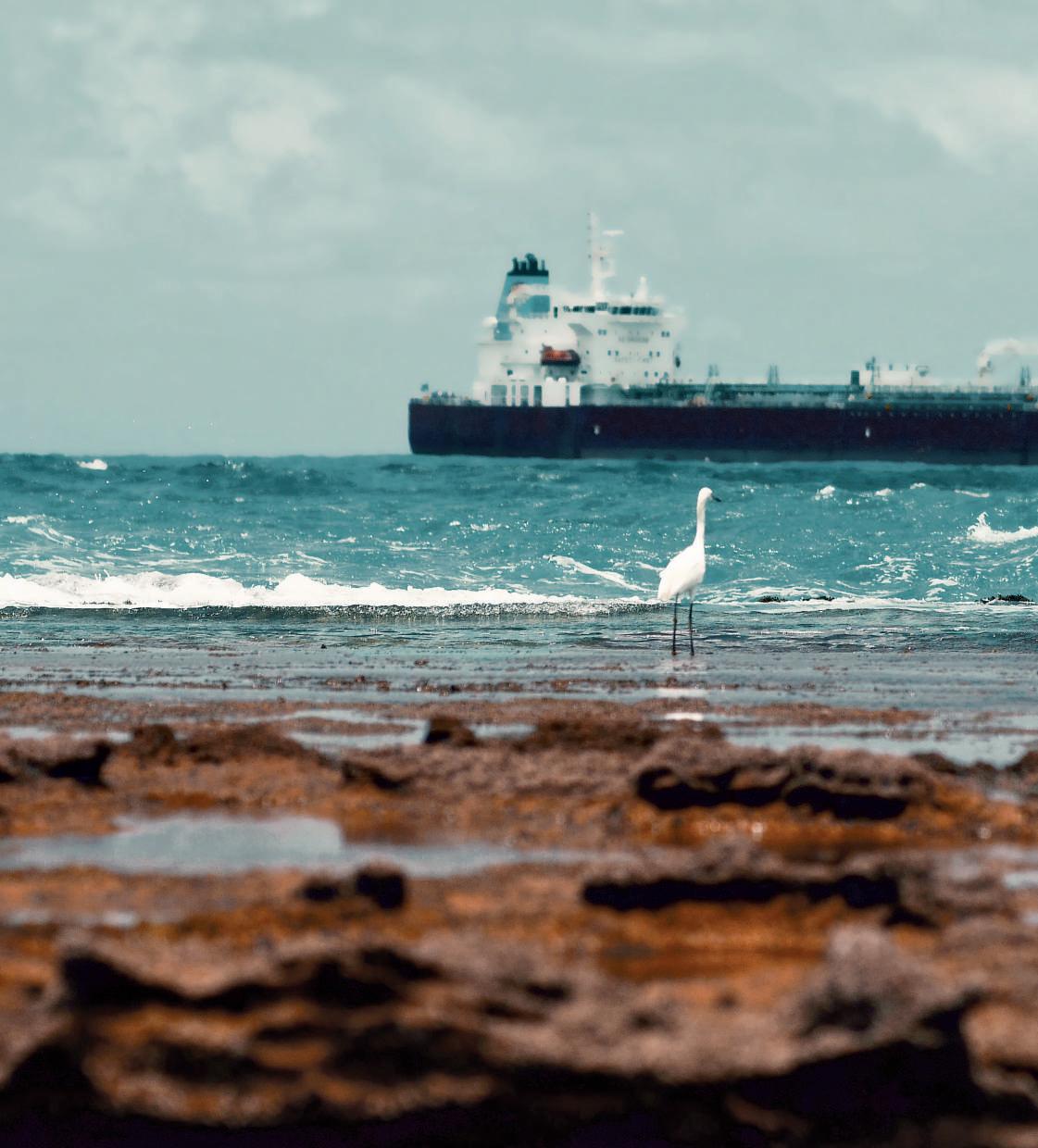
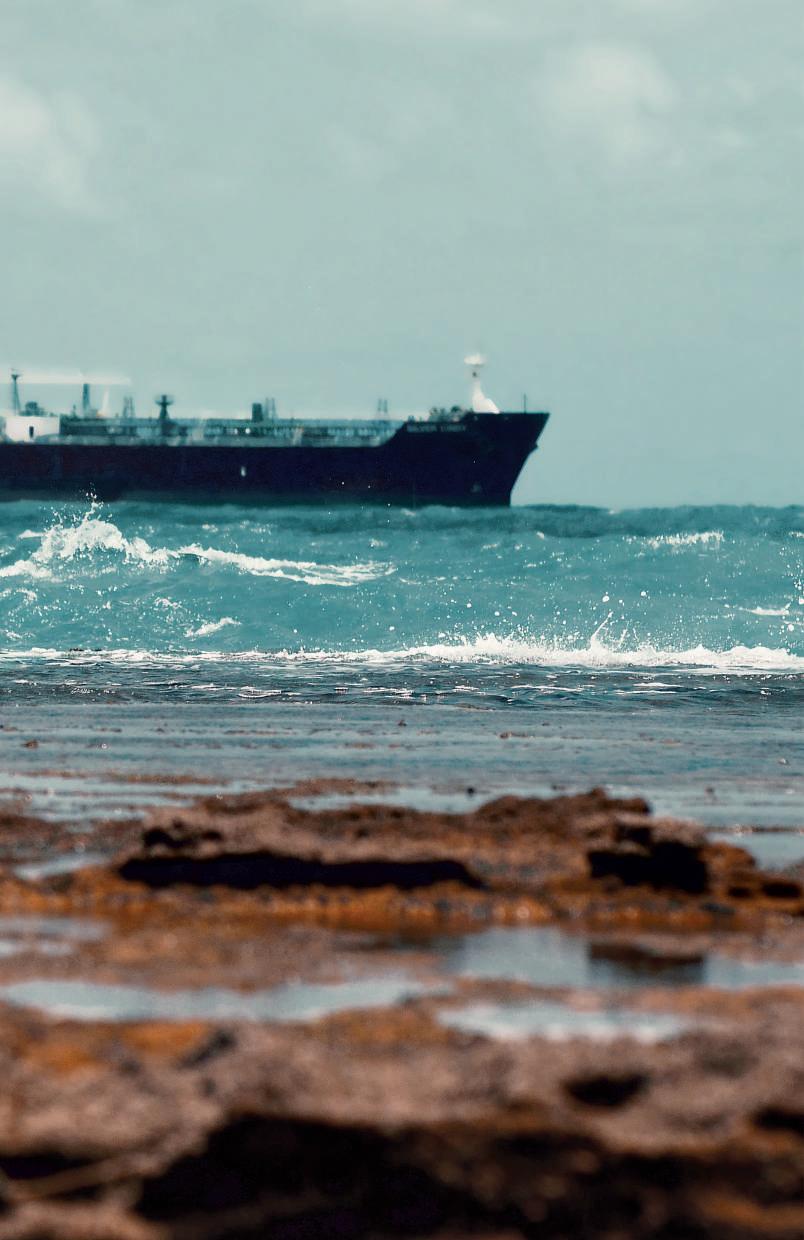
Ahistória do desenvolvimento econômico de Pernambuco, sobretudo nas últimas décadas, confunde-se com a história do Porto de Suape. Definido como hub logístico regional e nacional, território de elevada capacidade industrial ou terra de oportunidades, emprego e renda, é fato que o Complexo Industrial Portuário Governador Eraldo Gueiros chega aos 45 anos como um valioso ativo de Pernambuco e do Brasil. Escrever sobre o porto é exaltar cada etapa dessa construção, que chega a este aniversário apontando para um futuro próximo mais sustentável e promissor. Como primeira governadora do Estado de Pernambuco, exalto cada etapa dessa trajetória pujante e cheia de frutos, reiterando que este Poder Executivo nunca deixou de enxergá-lo como equipamento indutor de desenvolvimento, fato que possibilitou – sem descontinuidade – o seu crescimento e a reafirmação, ano a ano, do seu potencial. Desenvolver Suape é, antes de tudo, política de Estado.
O planejamento estratégico de Pernambuco passa pelo porto e, a contar dele, o futuro é logo ali. A localização privilegiada, os investimentos já captados e o nosso diálogo incessante com os demais entes da federação, sobretudo com o governo federal, possibilitam afirmar que
a retomada da liderança de Pernambuco no Nordeste – e a assunção do nosso estado como referência nacional –passam por enxergar o porto como centralidade para a administração.
O trabalho tem sido esse desde o primeiro dia, e já existem vitórias: é emblemática e muito significativa para Pernambuco a garantia da construção do ramal pernambucano da Ferrovia Transnordestina, que multiplicará exponencialmente as oportunidades do porto como hub.
O anúncio de obras como as de expansão da Refinaria Abreu e Lima, da Petrobras, a garantia das condições para atracação de navios de maior porte e a viabilização da conexão logística com os polos industriais da Zona da Mata Norte são elementos relevantes nesse contexto, que também se juntam aos nossos esforços para conectá-lo às oportunidades do mercado de Hidrogênio Verde.
Pernambuco tem orgulho de ter Suape. Como governadora, saúdo este momento com a garantia de que a nossa missão é fazê-lo cada vez mais o início e o fim de rotas e conexões de Pernambuco com o Brasil e o mundo.









The history of the economic development of Pernambuco, especially in the last few decades, is inextricably linked to that of the port at Suape. The Governor Eraldo Gueiros Port and Industrial Complex is a regional and national logistics hub and an area with an enormous capacity for the installation of industry and all the employment and income generation opportunities this brings. The Complex is currently celebrating forty-five years of existence as a valuable asset for Pernambuco and for Brazil. Every stage in its construction over this period deserves our admiration, and this has ensured that, as the port passes this milestone, its future promises even greater sustainability and further success.
As the first woman to be elected governor of the State Pernambuco, I am proud of every step in this extraordinarily productive process and would like to take this opportunity to reaffirm that my government will always see Suape as a facility that drives development and makes it possible to achieve continual growth and renewed potential year after year. The development of Suape remains a top priority for the State.
Strategic planning in Pernambuco requires the existence of this port. This is where the future lies. The prime location, the investment already made, and ongoing negotiations with
other governments in Brazil, especially the Federal Government, are all helping to ensure that Pernambuco is once again a regional leader in the Northeast and is becoming a national point of reference and that the port is a top priority for any administration.
So it has been since the beginning, and many achievements have been accomplished since then. The most important and symbolic for the State of Pernambuco is the construction of the Pernambuco Branch of the Transnordestina Railroad, which will vastly increase opportunities for the port as a hub. The announcement of public works such the expansion of Petrobras’s Abreu e Lima Refinery, the prospect of making the port accessible to the very largest ships, and the feasibility of creating a logistical connection with the industrial hubs located north of Recife are all important components of this ongoing endeavor to connect the port to opportunities related to the Green Hydrogen market.
Pernambuco is extremely proud of its industrial port complex. As governor, I welcome this anniversary as an opportunity to consolidate our mission to ensure that all routes connecting Pernambuco to other parts of Brazil and to the rest of the world begin and end at Suape.

OPorto de Suape é a melhor expressão da opção do povo pernambucano por tomar para si as rédeas do próprio destino. Foi na decisão de construir Suape e na disciplina de alocar seus escassos recursos, independentemente do apoio da União, que Pernambuco manifestou ao Brasil seu projeto de Estado e seu compromisso de construir o futuro.
Tão relevante para a economia e para a vida de pernambucanos e brasileiros, o Complexo Industrial Portuário de Suape precisa ter sua história conhecida e reconhecida e sua estratégia futura construída a partir dos ideais de grandeza que permearam a sua fundação.
Pernambuco, que historicamente exerceu protagonismo econômico global a partir do porto urbano que deu origem à sua capital, encontrava-se num momento de inflexão na segunda metade do século 20 e corria o risco de ficar excluído de novos ciclos de industrialização e de desenvolvimento econômico.
A história que o leitor conhecerá nas páginas a seguir revela a coragem e o pioneirismo de uma geração de
pernambucanos que anteviu um futuro em que a preservação ambiental e cultural seriam ativos tão relevantes quanto a profundidade do porto e a dimensão dos seus cais e píeres.
Planejadores, agentes políticos e diversos atores sociais que deixaram de lado diferenças pontuais para pensar um complexo que integraria indústrias e porto com áreas de proteção do meio ambiente e conservação do patrimônio histórico.
Passados 45 anos, os desafios vencidos no passado e aqueles que antevimos para o futuro materializam-se de forma a requerer novamente do povo de Pernambuco liderança e coragem para traçar, a partir de Suape, uma nova rota para melhorar a vida da população.
Leia o livro, conheça a história e apaixone-se pelo que podemos construir a partir do exemplo de Suape.
Secretário de Desenvolvimento Econômico de Pernambuco


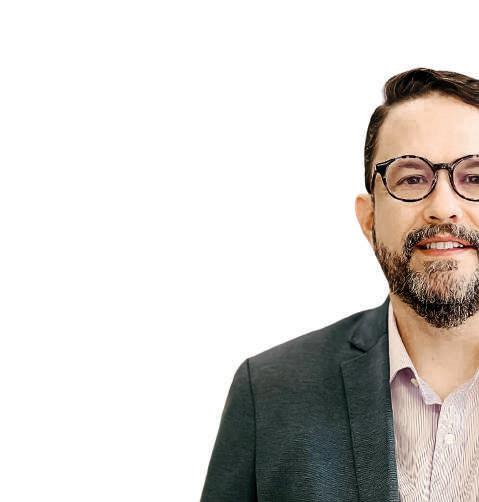

Suape Port provides irrefutable living proof of the people of Pernambuco’s willingness to take control of their own destiny. In deciding to create Suape and having the discipline required to do so using scarce resources, with or without Federal Government support, Pernambuco has shown Brazil the scale of its ambitions and its commitment to building a better future.
The history of the Suape Port and Industrial Complex is so important for the economy and for the lives of the people of Pernambuco and of Brazil as a whole that its story cries out to be told and people need to know that its strategy for the future is built on the same ambitious aspirations on which it was originally founded.
Pernambuco, through the port that grew up around its capital city of Recife, has historically played a leading role in the global economy. In the second half of the 20th century, however, it found itself at a turning point and at risk of being excluded from the new cycles of industrialization and economic development that were underway.
The history that the reader will learn about in the following pages reveals the courage and pioneering spirit of a generation of citizens of Pernambuco who imagined a future in which preservation of the environment and of culture would be considered assets as important as the depth of the port and the size of its quays and piers.
Planners, politicians, and various other stakeholders put their differences aside to imagine a complex that would combine ports and industry with protection of the natural environment and the conservation of national and local heritage.
Forty-five years later, the challenges of the past have been met and those that we foresee for the future require once again that the people of Pernambuco employ their courage and capacity for leadership to ensure that Suape carves out a new path towards a better life for all.
Read this book, learn about this history, and become passionate about the potential we have to build the future, if we take Suape as our example.

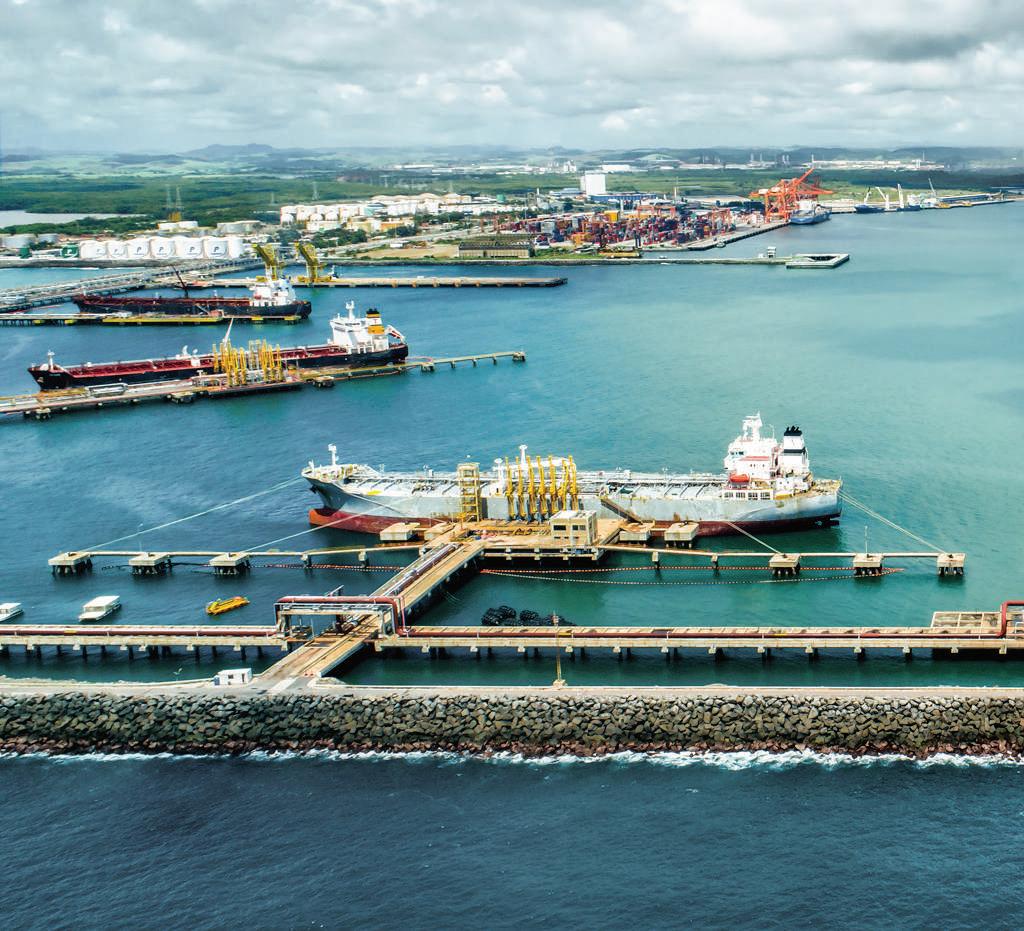
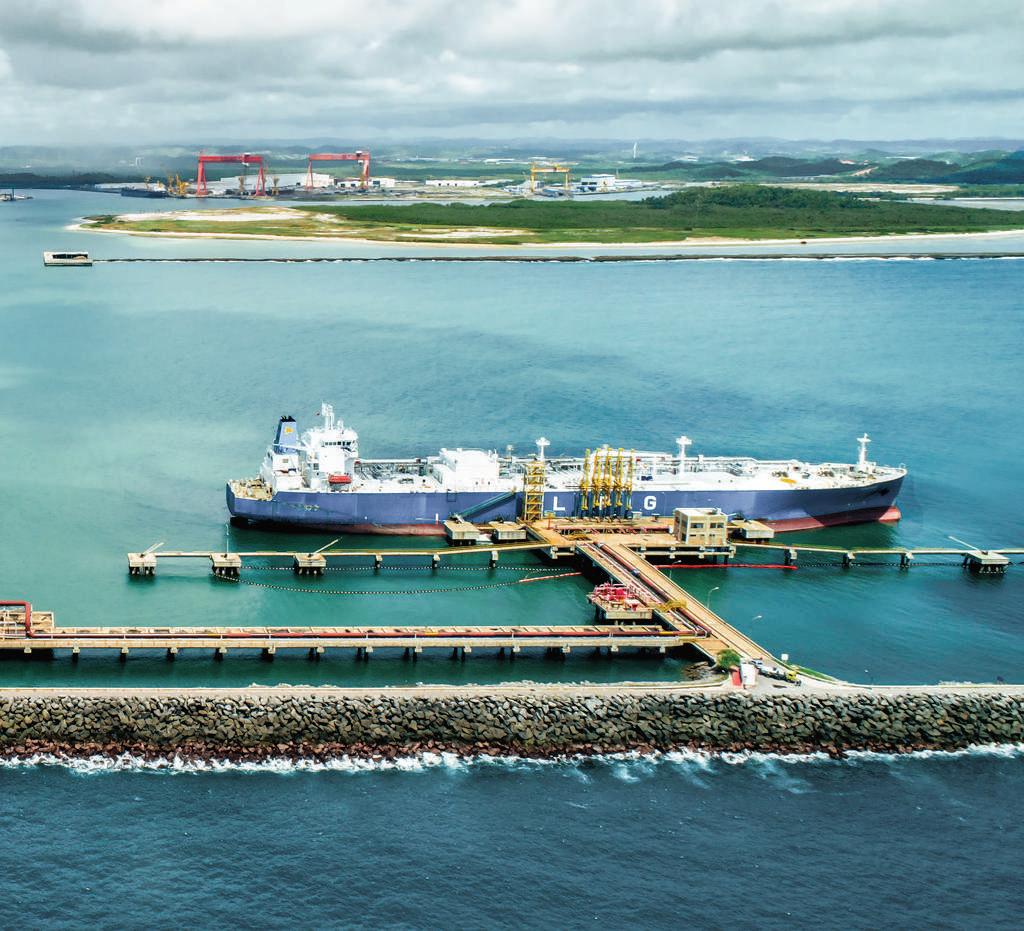
Acesse o QR Code para ver conteúdo extra
16-55 56-117
Como tudo começou
How it all began
Suape surgiu como um projeto estruturador. Foi aclamado por muitos, contestado por outros. Vingou com o entusiasmo de visionários, como o jornalista e empresário Anchieta Hélcias. Com o porto-indústria, nasce também a transformação econômica do estado.
Suape begins as a structural project. It is acclaimed by many, questioned by some. It triumphs through the efforts of passionate visionaries, such as the journalist and businessman Anchieta Hélcias. The birth of the industrial port also marks the beginning of the economic transformation of the State of Pernambuco.
capítulo 2
Rota de desenvolvimento
The road to development
Com 83 empresas e investimentos privados que somam R$ 74,5 bilhões, Suape chega robusto à maioridade. Recebe navios que são verdadeiros gigantes do mar, investidores e se prepara para ficar ainda mais competitivo, sempre fazendo história.
With 83 companies installed and private investment of R$ 74,5 billions, Suape comes of age in fine fettle. It receives truly gigantic ocean-going ships and major investors and prepares to become even more competitive and to accomplish even more historical achievements.
capítulo 3
Sustentabilidade e inovação
Looking to the future 118-165 166-205
Rumo ao futuro
Innovation and sustainability capítulo 4
Suape conecta-se ao mundo por uma gestão moderna, focada na sustentabilidade, na inovação, na responsabilidade social e na transparência. Iniciativas como o TecHub Hidrogênio Verde inserem Pernambuco na rota das boas práticas.
Suape is connected to the world by modern management focused on innovation, sustainability, transparency, and social responsibility. Initiatives such as the Green Hydrogen TecHub have brought Pernambuco in line with international good practices.
Pensar em Suape no futuro é pensar grande. Projetos não faltam, como o novo Terminal de Contêineres, a ampliação da Refinaria Abreu Lima e o trecho Salgueiro-Suape da nova ferrovia. O cenário é transformador.
Thinking about Suape’s future means thinking big. There is no shortage of projects and these include a new Container Terminal, expansion of the Abreu e Lima Refinery, and creation of the SalgueiroSuape stretch of the new railroad. Suape continues to drive change.

Como tudo começou

How it all began
Na língua tupi, Suape significa “caminho sinuoso”. Foi batizado assim pelos indígenas por causa do vai e vem que o hoje Rio Massangana faz antes de desembocar no mar. Incerto no nome, mas certeiro na vocação para ser porta de entrada e saída de mercadorias. Protegido pelo quebra-mar dos arrecifes, o porto sempre despertou interesse dos navegantes. Inicialmente foram os portugueses que desembarcaram na região. Os holandeses também espicharam os olhos para o local, que foi até ponto de recebimento de munições durante a Insurreição Pernambucana, no século 17. Nada mais natural que a área, distante pouco mais de 40 quilômetros do Recife, fosse cogitada para abrigar um complexo portuário e industrial.
Na década de 1960, foram iniciados os estudos para viabilizar o projeto desse porto-indústria. Seria imprescindível não apenas atender a demanda já existente na região, abastecida pelo Porto do Recife, mas gerar uma nova demanda de exportações e importações de produtos, além de atrair indústrias estratégicas em um mundo que estava ficando cada vez mais globalizado. Ainda no início da década de 1970, o martelo foi batido pelo governo estadual. O local do empreendimento seria mesmo Suape, com suas águas profundas, com até 17 metros de calado, e uma área imensa para a implantação do parque industrial.
Em 1973, começou a ser elaborado o Plano Diretor. O modelo de integração entre porto e indústria seria semelhante aos de Marseille-Fos, na França, e Kashima, no Japão. O documento ficaria pronto dois anos depois. Mas a pedra fun-
damental foi lançada em 1974 pelo então governador Eraldo Gueiros. Ele também pediu ao governo federal a inclusão de Suape no II Programa Nacional de Desenvolvimento (PND), que tinha foco na geração de energia, na produção de insumos básicos – como o petróleo, o alumínio e o aço – e de bens de capital.
Passaram-se dois anos até que, em 1976, foi criado um grupo interministerial com o objetivo de examinar a viabilidade técnica, econômica e financeira do projeto. Os estudos terminaram no ano seguinte. A partir daí, começaram as desapropriações das terras – cerca de 13,5 mil hectares. Também foram iniciadas as obras de infraestrutura portuária, sistema viário interno, abastecimento de água, energia elétrica e telecomunicações. Naquele lugar onde só havia pedra, poeira e expectativas, começava a nascer o Complexo Industrial Portuário de Suape.
Em 1978, Suape ganhou sua certidão de nascimento. No dia 7 de novembro, por meio da Lei Estadual nº 7.763, foi criada a empresa SUAPE – Complexo Industrial Portuário, que tinha como finalidade administrar a implantação do distrito industrial, o desenvolvimento das obras e a exploração das atividades portuárias. Foram mais cinco anos até que o porto começasse a operar efetivamente. Em 8 de novembro de 1983, a Petrobras, que tinha instalado quatro tanques de 5 mil m³ para o armazenamento de combustíveis, atracou o navio Araxá no recém-inaugurado Píer de Granéis Líquidos (PGL-1).
Aquela operação para levar o álcool produzido em Pernambuco para fora do estado foi a primeira de muitas. Hoje,

para além dos combustíveis, reina a diversidade de cargas, a sustentabilidade e a inovação tecnológica. Suape tem operação de contêineres em navios gigantes. Conta com refinaria de petróleo, estaleiros, hub de veículos, fábricas que produ-
zem de medicamentos a motocicletas, de bebidas e comidas a pás para turbinas eólicas. Está ganhando até projetos para a produção de Hidrogênio Verde. O que não falta é assunto para, pelo menos, mais 45 anos de história.
In the Tupi language, Suape means “winding path”. The area was called this by the indigenous people because of the winding course that what is now known as the Rio Massangana before it meets the sea. Uncertain by name, but reliable by nature, this area now serves as a port for the entrance and exit of goods. Protected by a breakwater of reefs, the port has always aroused the interest of navigators. First the Portuguese arrived in the region. The Dutch also had their eye on a site through which munitions could be shipped during the 17thcentury Pernambuco Insurrection. Nothing could be more natural than that this area, not much more than 40 kilometers from the city of Recife, should be considered for the location of an industrial port complex.
In the 1960s, preliminary feasibility studies were undertaken for the installation of an industrial port. The site would be required not only to meet existing demand in the region, served by the Port of Recife, but also to generate new demand for exports and imports. It would also, clearly, need to attract strategic industries in an increasingly global world. By the early 1970s, the State Government had done the deal. The location for the undertaking would indeed be Suape, with its waters of up to 17 meters in depth and a vast area available for installation of an industrial complex.
In 1973, work began on the Master Plan. The model for combining a port and industrial complex came from Marseille-Fos, in France, and Kashima, in Japan. Two years later, the document had already been drawn up and the cornerstone was laid in 1974 by Eraldo Gueiros, the State Governor of the time. Gueiros also asked the Federal Government for Suape to be included in the 2nd National Development Program (NDP), focusing on power generation, and
the production of basic raw materials—such as oil, aluminum and steel—and physical assets.
Two years later, in 1976, an inter-ministerial group was set up to examine the technical, economic, and financial viability of the project. Studies were completed in the following year, and it was then that the acquisition of around 13,500 hectares of land began. Work also began on port infrastructure, an internal road system, and the supply of water, electrical power, and telecommunications. Where there had once only been stone, dust and dreams, the Suape Port Complex had begun to take shape.
Suape’s official date of birth is 7 November 1978, as declared in State Law nº 7,763, which created the SUAPE – Industrial Port Complex corporation, charged with overseeing the installation of the industrial park, conducting building work, and running the port. It would take five more years before the port actually began operation. On 8 November 1983, Petrobras, which had installed four 5,000 m³ tanks to store fuel, moored the Araxá at the recently opened Bulk Liquids Pier (PGL-1).
This operation involving the shipment of alcohol produced in Pernambuco to other States in Brazil was the first of many. Nowadays, in addition to fuel, a wide range of cargo is transported, and the port is a byword for sustainability and innovative technology. Suape can also accommodate huge container ships. It has an oil refinery, shipyards, a vehicles hub, factories producing goods ranging from motorcycles to pharmaceuticals, from food and beverages to wind turbine blades. It is even preparing to host Green Hydrogen projects. There will certainly be a lot to talk about for at least the next 45 years.

“Suape teve começo e meio.
Mas jamais terá fim”
Anchieta Hélcias Jornalista e empresário
Suape ainda não passava de um sonho, na década de 1960, mas já dividia opiniões. Gerava discussões acaloradas. Ficava a milhas e milhas de distância de ser uma unanimidade. Mesmo assim, conquistava o apoio de uma “força-tarefa” integrada por entusiastas da ideia do porto-indústria.
O jornalista e empresário Anchieta Hélcias fazia parte desse restrito grupo de articuladores do projeto. Na coluna Nordeste Dia a Dia, que assinava no Jornal do Commercio, do Recife, foi, de pronto, um defensor da construção de um novo porto no Nordeste. No final de 1970, viajou até o Rio de Janeiro como enviado especial do periódico para fazer uma entrevista exclusiva com Eraldo Gueiros, que assumiria o governo de Pernambuco no ano seguinte, por meio de eleições indiretas.
O país vivia o regime militar, depois do golpe de 1964, e as eleições diretas estavam proibidas para os cargos majoritários. No meio da conversa, Hélcias passou de entrevistador a entrevistado. Eraldo Gueiros queria saber: “O que é Suape?”.
Munido de informações repassadas pelo almirante Paulo Moreira da Silva, cientista da Marinha que tinha estudos sobre a costa brasileira, o jornalista detalhou as condições favoráveis e a viabilidade do projeto como uma virada de chave para o desenvolvimento de Pernambuco e do Nordeste. Depois, em um novo encontro, o próprio almirante apresentou os detalhes técnicos a Gueiros. O resultado é que
Anchieta Hélcias voltou para casa no avião do governador, a convite dele, carregando na bagagem um “furo” de reportagem. Eraldo Gueiros deu ao jovem jornalista, então com 25 anos, uma informação histórica: “Vou fazer Suape”.
A reportagem de duas páginas com a informação privilegiada, reservada para uma edição de domingo no Jornal do Commercio, acabou não sendo publicada com exclusividade. Tão logo desembarcou no Recife, Eraldo Gueiros foi questionado por outros jornalistas sobre o que faria de diferente pelo desenvolvimento de Pernambuco. Ele acabou soltando o que seria o grande “furo” de reportagem de Hélcias. Anunciou que faria Suape. Naturalmente, a notícia ganhou as páginas de todos os jornais no dia seguinte. O “furo” do jovem jornalista durou pouco. Mas o compromisso do governador foi para valer.
Anchieta Hélcias não é do tipo que centra as atenções no passado, mas deu um longo depoimento sobre a saga do Complexo Industrial Portuário para o livro Suape, muito mais que um porto, assinado pelo jornalista Carlos Garcia e pelo economista Josué Mussalém, ambos já falecidos. Na publicação, de 2011, ele conta histórias como a da primeira entrevista com Gueiros e outras passagens marcantes. Voltou a revisitar a memória daqueles tempos especialmente para colaborar com o conteúdo do livro Suape 45 Anos.
Hélcias teve um papel estratégico na consolidação de Suape, assim como Ayrton Cardoso - um jovem empresário
naquela época. Juntamente com o engenheiro químico Romeu Boto, ele importou a ideia de porto-indústria da cidade de Antuérpia, na Bélgica, no continente europeu. Além deles, o grupo de entusiastas contava com Júlio Araújo, Ivan Romagueira e o almirante Paulo Moreira da Silva. O relatório do almirante, denominado Um novo porto para o Nordeste, foi decisivo para consolidar o projeto. O estudo, encomendado pelo governo Gueiros, foi concluído em 1972 e referendou as condições ideais para a implantação do empreendimento. Convidado por Eraldo Gueiros para fazer parte da gestão, Anchieta Hélcias saiu da condição de articulador voluntário de uma ideia para a de realizador. Recebeu a tarefa do governador de viabilizar o projeto. Dez dias após a posse de Gueiros, ele assumiu a recém-criada Diretoria de Promoção e Investimentos da Companhia de Desenvolvimento Industrial de Pernambuco (Diper), atual Agência de Desenvolvimento de Pernambuco (Adepe). Posteriormente, Hélcias passou ao cargo de presidente. Dali em diante, e pelos oito anos seguintes, continuou firme na missão de tirar Suape do papel.
No governo seguinte, de José Francisco de Moura Cavalcanti, Suape não perdeu o status de prioridade. Pelo contrário. Foi tratado como um projeto transversal, envolvendo o esforço de várias secretarias. Anchieta Hélcias permaneceu na gestão e integrou o time do secretariado, comandando a pasta de Indústria e Comércio. Na primeira reunião com
Moura Cavalcanti, sugeriu a criação do Grupo Executivo de Suape, o que foi acatado. O projeto do porto-indústria ganhava vida própria.
Cada secretaria cuidava de sua área do ponto de vista operacional. Caberia a Hélcias um outro papel. Ele não queria dirigir gente. Queria dirigir ideias. E, para isso, estava empenhado em ir buscar o que havia de melhor e os profissionais mais experientes. Trouxe de volta de Brasília, por exemplo, o geólogo Luiz Siqueira, que já havia presidido a Diper.
Todo esse movimento, de acordo com Hélcias, não ocorreu de forma aleatória. Suape teve influência direta na sucessão de Eraldo Gueiros. O governador não queria correr o risco de ver o porto-indústria perder importância na gestão seguinte. Ou pior: ver o projeto ser engavetado. Levando em conta, portanto, o compromisso dos pretensos candidatos de consolidar o empreendimento, Gueiros indicou ao então presidente da República, Ernesto Geisel, dois nomes. O concorrente de Moura Cavalcanti foi Marco Maciel, que teria sido preterido porque o presidente o considerou ainda muito jovem para tão importante cargo.
O vice-governador de Moura Cavalcanti, Paulo Gustavo Cunha, também foi escolhido porque tinha Suape na sua linha de prioridades. No governo Nilo Coelho, no período de 1967 a 1971, Paulo ocupou a Secretaria de Indústria e Comércio, permanecendo no cargo também na gestão Eraldo Gueiros.
- Quando o presidente Geisel ligou confirmando para Gueiros o nome de Moura Cavalcanti para governador, eu estava com ele. Fomos eu e Gilberto Gueiros, filho de Eraldo,
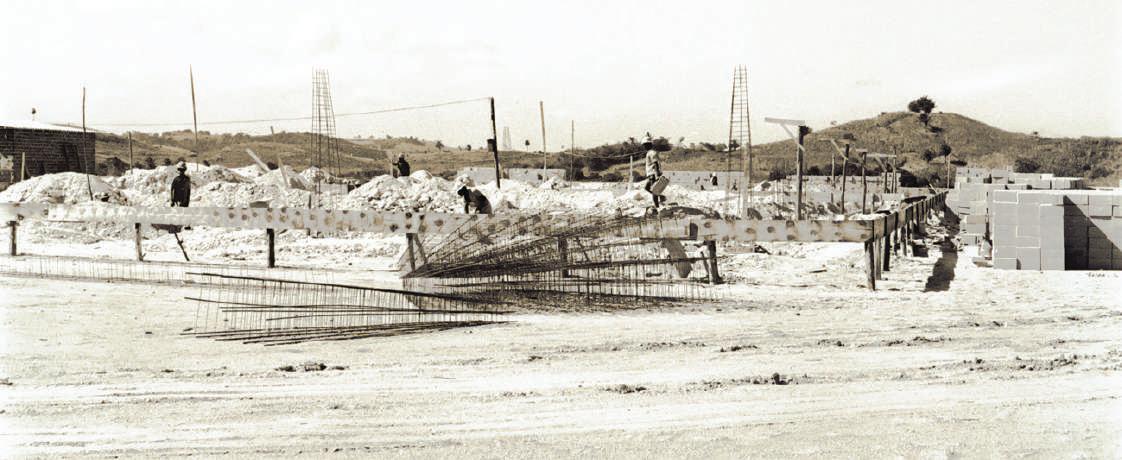
levar a notícia a Moura, que tinha que estar no dia seguinte em Brasília. Fui com ele.
Outra figura importante da história de Suape, naquele momento, foi Júlio Araújo, chefe de gabinete de Hélcias, posteriormente de Gueiros e presidente da Diper na gestão Moura Cavalcanti.
Ao fazer uma retrospectiva do período pré-Suape, Anchieta Hélcias é pragmático quando é questionado sobre a dimensão do complexo.
- Aqueles oito anos iniciais foram fundamentais para consolidar Suape. Depois de Eraldo e Moura, vieram Marco Maciel, Roberto Magalhães e, nas gestões seguintes, todos os governadores, sem exceção, deram sua contribuição. Todos trabalharam. Valeu a pena!
Hélcias também tem outra convicção.
- Suape é uma vitória da comunicação. Sem comunicação, não haveria Suape.
Depois que fixou residência em Brasília, há mais de 40 anos, Anchieta Hélcias revela que esteve apenas duas ou três
vezes em Suape, embora visite Pernambuco anualmente. Uma das vezes foi em um sobrevoo, em 2008, a convite do então governador Eduardo Campos. O complexo já era um mundo, repleto de projetos estruturadores, inclusive a execução das obras da sonhada refinaria de petróleo.
Outra visita, a convite da Rede Globo, aconteceu quatro anos depois, para uma entrevista especial comandada pela jornalista Mônica Silveira. Nas duas ocasiões, Anchieta Hélcias ficou encantado com a dimensão do porto-indústria que ele e os visionários sempre acreditaram que poderia ser feito para mudar a economia pernambucana e da região.
Ao olhar para o futuro, na perspectiva de empresário e consultor, ele enxerga que um dos novos projetos de Suape - o TecHub Hidrogênio Verde, que coloca o complexo na rota da descarbonização - é importantíssimo. É ele que deve projetar, com protagonismo, Suape nos mercados nacional e mundial das energias renováveis.
Alguém tem dúvida de que a previsão de Hélcias não vai virar realidade?
“Suape had a beginning and a middle. But it will never have an end”
Anchieta Hélcias Journalist and entrepreneur
In the 1960s, Suape was still no more than a dream, though opinions on the matter were already divided. Heated discussions ensued. Unanimity was far from being achieved. Even so, the proposal gained the support of a “task-force” of individuals enthusiastic about the idea of an industrial port complex.
Journalist and business-owner Anchieta Hélcias was one of the small group trying to get the project off the ground. In his Northeast Day to Day column in Recife’s Jornal do Commercio newspaper he vigorously defended the idea of building a new port in the Northeast. At the end of 1970, he was sent to Rio de Janeiro by the newspaper as a special envoy to conduct an exclusive interview with Eraldo Gueiros, who was due to take over as Governor of Pernambuco the following year, following indirect elections.
Since the coup of 1964, the country had been living under a military dictatorship, and no direct elections were allowed for the most important government positions. In the middle of the interview, the tables were turned and Hélcias was the one answering the questions. Eraldo Gueiros asked, “What is Suape?”
Equipped with information provided by Admiral Paulo Moreira da Silva, a Navy scientist who had studied the Brazilian coast, the journalist provided a detailed account of the advantages of this site and the feasibility of a project that would mark a turning point in the development of the State of Pernambuco and the whole Northeast region.
In a subsequent meeting, the Admiral himself provided Gueiros with the technical details. Anchieta Hélcias returned home as a guest of honor on the Governor’s plane, with a major “scoop” for his
newspaper in his back pocket. The journalist was only 25 years old when Eraldo Gueiros confided in him the historic announcement: “I will make Suape happen.”
The two-page exclusive report was planned for the Sunday edition of Jornal de Commercio but ended up not being so exclusive. As soon as Eraldo Gueiros got off the plane in Recife, he was quizzed by other journalists about what he was going to do differently to help boost development in Pernambuco. He ended up telling them and depriving Hélcias of his “scoop”. He announced that he would build Suape. This news naturally made it onto the front pages of all the local newspapers the next day. The young journalist’s “scoop” hadn’t lasted long. But the Governor would remain good to his word.
Anchieta Hélcias is not the kind of person who dwells on the past, but he provided a long memoir on the Suape Industrial Port Complex saga for Suape, much more than a port, a book-length publication written by the journalist Carlos Garcia and the economist Josué Mussalém, both of whom have now, sadly, passed away. In this 2011 publication, Hélcias tells the story of his first interview with Gueiros and other landmark events. He has once again agreed to relive those times to help us write Suape 45 Years.
Hélcias played a key role in the consolidation of Suape, as did Ayrton Cardoso – who was a young businessman at the time. Together with the chemical engineer Romeu Boto, he got the idea of an industrial port from Antwerp. The group of supporters also included Júlio Araújo, Ivan Romagueira and Admiral Paulo Moreira da Silva. The Admiral’s report, called A New Port for the Northeast, played a decisive role in getting the project off the ground. The study, com-
missioned by the Gueiros administration, was concluded in 1972 and reported ideal conditions for installation of the undertaking.
Invited by Eraldo Gueiros to join the team, Anchieta Hélcias turned from volunteer promoting the port to one of those tasked by the Governor with bringing the project to fruition. Ten days after Gueiros’s inauguration, Hélcias took on the recently created post of Director of Promotion and Investment of the Pernambuco Industrial Development Company (Diper), which is now called the Pernambuco Development Agency (Adepe). Later on, Hélcias was made its president. For eight long years from that moment on, he remained firm in his commitment to the mission of getting Suape off the drawing board.
In the succeeding administration of José Francisco de Moura Cavalcanti, Suape did not cease to be accorded priority. On the contrary, it was treated as a cross-cutting project, involving various departments. Anchieta Hélcias remained part of the management team and joined the governor’s cabinet, as secretary responsible for the Trade and Industry portfolio. In the first meeting with Moura Cavalcanti, it was suggested that a Suape Executive Group be created, and this was duly done. The industrial port project had finally gotten off the ground.
The head of each department dealt with their own area from an operational point of view. Hélcias played a different role. He did not want to manage people. He wanted to manage ideas. And, for this reason, he set about seeking out the best technical experts. From Brasília, for example, he brought the geologist Luiz Siqueira, who had already headed up Diper.
None of this, according to Hélcias, happened by chance. Suape had a direct influence on the appointment of Eraldo Gueiros’s successor. The governor did not want to run the risk of seeing the industrial port dwindle in importance in the succeeding administration. Worse still: he did not want to see the project shelved. It was, therefore, with their commitment to consolidating the undertaking in mind, that Gueiros put forward the names of two candidates to then President of the Republic, Ernesto Geisel. Moura Cavalcanti faced off against Marco Maciel, who was eventually passed over, it is said, because the President considered him still too young for such an important post.
Moura Cavalcanti’s Deputy Governor, Paulo Gustavo Cunha, was also chosen because Suape numbered among his priorities. In the Nilo Coelho administration, between 1967 and 1971, Paulo had held the post of Trade and Industry Secretary, and had remained in this post under Eraldo Gueiros.
- I was with him when President Geisel rang to tell Gueiros that Moura Cavalcanti had been picked for Governor. Gilberto Gueiros, Eraldo’s son, and I relayed the news to Moura, who had to be in Brasília the next day. I went with him.
Another important figure in the history of Suape at that time was Júlio Araújo, Hélcias’s and later Gueiros’s Chief of Staff, and President of Diper under the Moura Cavalcanti administration.
Looking back on the pre-Suape period, Anchieta Hélcias provides a straightforward account of the development of the project.
- The first eight years were fundamental in laying the groundwork for Suape. After Eraldo and Moura, came Marco Maciel and Roberto Magalhães, and all subsequent State governors of Pernambuco, wi-

thout one single exception, played their part. They all did their bit!
Hélcias is also convinced of something else.
- Suape was achieved by communication. Without communication, it would not have been possible.
Anchieta Hélcias reveals that, after moving to Brasília, where he has now been a permanent resident for over 40 years, he has only visited Suape two or three times, although he comes back to Pernambuco every year. On one of these occasions, in 2008, he flew over the site at the invitation of Governor Eduardo Campos. The complex already looked very different, with many structural projects, including the much dreamt of oil refinery.
Another visit, arranged by the Rede Globo TV station, occurred
four years later and involved a specially commissioned interview with the journalist Mônica Silveira. On both occasions, Anchieta Hélcias was impressed by the scale of the industrial port such as he and other visionaries had always believed could turn around the economy of Pernambuco and of the region as a whole.
Looking forward, from the perspective of a businessman and consultant, he foresees that one of Suape’s new projects – the Green Hydrogen TecHub, which will set the complex on the road towards decarbonization – will be especially important, helping to actively promote Suape on the national and international renewable energy market. Can anyone be in any doubt that Hélcias’s prediction will not come true?
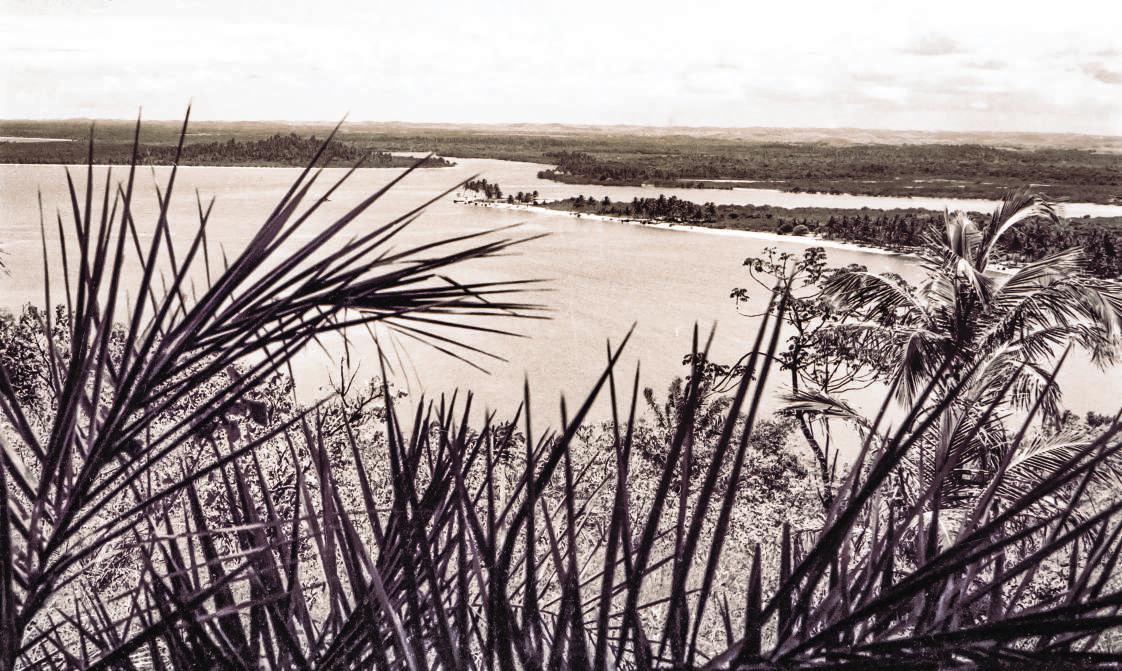
Estudos do padre francês Louis-Joseph Lebret, considerado um dos criadores do movimento Economia e Humanismo, são apontados como vitais para o surgimento de Suape. Em 1954, ele esteve em Pernambuco a convite do Governo do Estado. Entre outras recomendações, reforçou a necessidade de transferir o Porto do Recife para um local com mais retroárea e com acesso por ferrovias e rodovias
Studies by the French priest Louis-Joseph Lebret, considered one of the founders of the Humanist Economics movement, strongly influenced the development of Suape. In 1954, Lebret visited Pernambuco at the invitation of the State government. Among other recommendations, he stressed the need to transfer the Port of Recife to a location with a larger surrounding area and access to major rail and road routes



A imagem, de 1978, é um registro da visita de técnicos da Petrobras ao Porto de Suape
A top priority
This picture, from 1978, shows Petrobras technical staff visiting the Port of Suape

Estes registros, de 1979, mostram a visita de uma missão francesa ao ainda incipiente Porto de Suape

These photos, from 1979, show a French mission visiting the Port of Suape in its early days
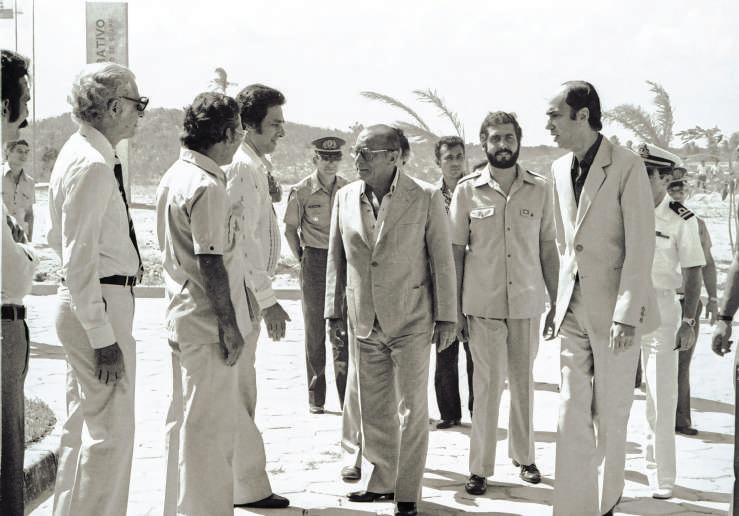
O presidente João Baptista Figueiredo, último do regime militar, desembarca em Suape, em 1980. O país enfrentava uma crise econômica
President João Baptista Figueiredo, the last president of the military régime, arrives in Suape, in 1980. Brazil is going through a major economic crisis

Nesta imagem, de 1980, um grupo de jornalistas percorre a área reservada ao porto-indústria, quando ainda não havia quase nada
This photo, from 1980, shows a group of journalists visiting the area set aside for the industrial port at a time when it was almost completely empty
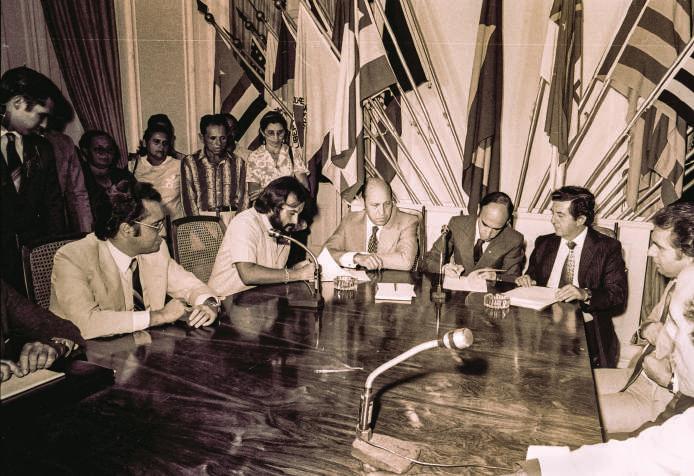
O governo Marco Maciel (1979-1982) cria a Secretaria Executiva para Assuntos de Suape, comandada pelo geólogo Luiz
Siqueira. Na imagem, a assinatura do primeiro empréstimo, no valor de US$ 50 milhões. Com o dinheiro, foram deflagradas obras como o molhe, o píer de atracação e a linha ferroviária

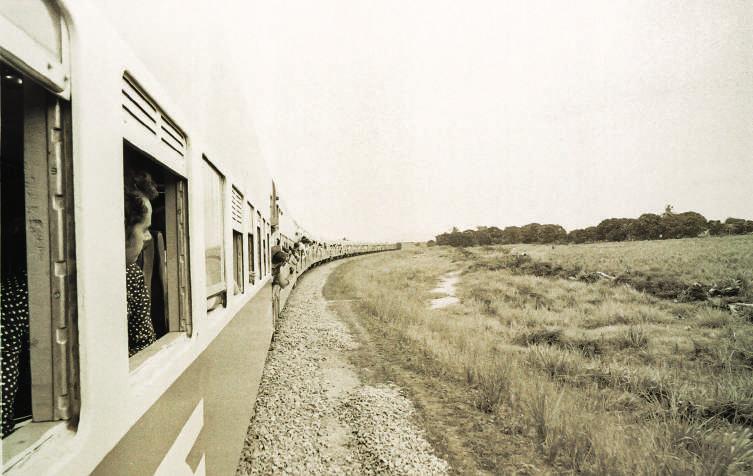
During Marco Maciel’s term of office as State Governor (1979-1982), the Executive Secretary for Matters relating to Suape was created, headed up by the geologist Luiz Siqueira. The photo shows the governor signing the contract for the first loan of US$ 50 million. The money was used to start work on the breakwater, berthing pier, and railroad

A gestão do governador Roberto Magalhães (1983-1986) deflagrou várias obras em Suape, todas com o dinheiro azul e branco. Foi assim denominado porque saia, exclusivamente, dos cofres estaduais
Roberto Magalhães’s term of office as State Governor (1983-1986) saw various works get under way in Suape, all funded by blue and white money. This term was used to describe funding that came exclusively from State coffers
“Quem descobriu o Brasil?” Depende. Se a pergunta for feita no município do Cabo de Santo Agostinho, provavelmente a resposta não será aquela com a qual estamos acostumados. Sai Pedro Álvares Cabral, entra Vicente Yáñez Pinzón. Longe de ser invencionice, há estudos que apontam que o navegador espanhol chegou à costa pernambucana no dia 26 de janeiro de 1500, quase três meses antes de o português Cabral avistar as terras da Bahia.
Depois de sair de Palos, no sul da Espanha, passar pelo Arquipélago de Cabo Verde, na África, e enfrentar fortes tempestades no Oceano Atlântico, Vicente Pinzón e sua frota chegaram a um local descrito como dono de uma beleza indizível. Resolveu batizá-lo de Santa Maria da Consolación.
As naus do capitão ficaram ancoradas em um porto abrigado e de fácil acesso a pequenas embarcações. O tal porto seria justamente a enseada de Suape.
O espanhol não ficou muito tempo por aqui. Ele sabia que não poderia reclamar o território para a coroa espanhola por causa do Tratado de Tordesilhas, que dividia o mundo entre espanhóis e portugueses. Como aquele pedaço de terra era português, Pinzón levantou âncora e rumou para o oeste. Mas deixou seu nome marcado para sempre na história do Cabo, que comemora em todo 26 de janeiro o Dia Municipal da Nacionalidade Hispânico-Brasileira. E ai de quem disser o contrário.
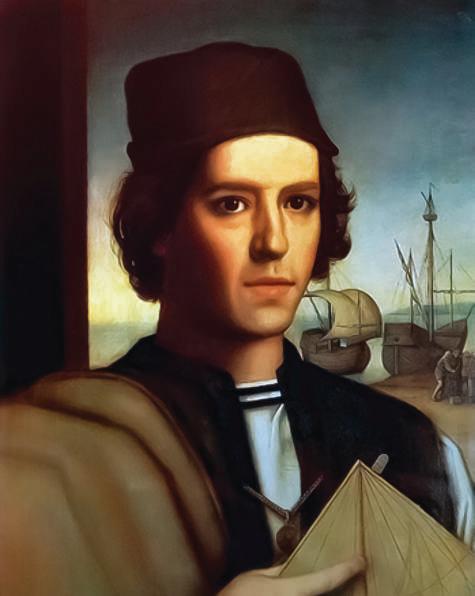
“Who discovered Brazil?” It depends. If you ask the question in the municipality of Cabo de Santo Agostinho, you will probably not get the answer you expect. Not Pedro Álvares Cabral, but Vicente Yáñez Pinzón. This is not just something made up. Some studies show that the Spanish navigator arrived on the coast of Pernambuco on 26 January 1500, almost three months earlier than the Portuguese sailor Cabral yelled, “Land Ahoy!” off the coast of Bahia.
After setting out from Palos, in Southern Spain, Vicente Pinzón and his fleet sailed through the Cape Verde archipelago off the coast of Africa and encountered powerful storms on the Atlantic Ocean before arriving at a location described as being of indescribable beauty. He decided to give it the name of Santa Maria da Consolación. The captain’s ships remained at anchor in a sheltered port easy for small boats to access. This must have been Suape.
The Spaniard did not stay long. He knew that he could not claim the territory for the Spanish Crown because of the Treaty of Tordesillas, which divided the world between the Spanish and the Portuguese. As this piece of land was Portuguese territory, Pinzón weighed anchor and set off westward. But he left his name in the history of the city of Cabo, which, every 26th of January, Celebrates Municipal Hispano-Brazilian Nationality Day. And woe betide anyone who says otherwise.
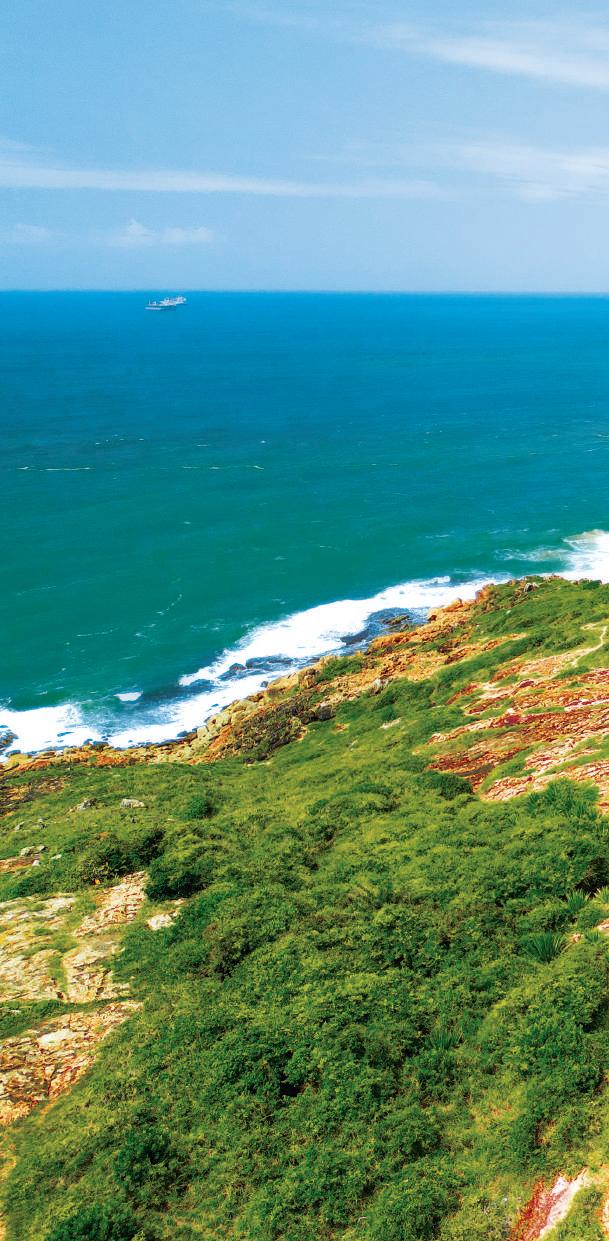
A história de Suape deixou de lado ideologias, divergências políticas e atravessou incólume vários governos. O primeiro a abraçar o projeto, Eraldo Gueiros, na foto em destaque, teve seu nome incorporado ao do complexo. O porto-indústria fez a transição do regime militar para o democrático e capitalizou ações de outros 14 governadores: Moura Cavalcanti, Marco Maciel, José Muniz Ramos, Roberto Magalhães, Gustavo Krause, Miguel Arraes, Carlos Wilson Campos, Joaquim Francisco, Jarbas Vasconcelos, Mendonça Filho, Eduardo Campos, João Lyra, Paulo Câmara e Raquel Lyra.
Nessas mais de quatro décadas, graças aos esforços de todos os envolvidos, Suape cresceu e se desenvolveu, consolidando-se como âncora do desenvolvimento de Pernambuco e do Nordeste.
The history of Suape has avoided ideology and political differences and been unaffected by changes of government. The complex bears the name of the first State governor to embrace the project, Eraldo Gueiros (see photo). The port and industrial complex successfully negotiated the transition from a military dictatorship to democracy and has benefited from the actions of 14 subsequent governors: Moura Cavalcanti, Marco Maciel, José Muniz Ramos, Roberto Magalhães, Gustavo Krause, Miguel Arraes, Carlos Wilson Campos, Joaquim Francisco, Jarbas Vasconcelos, Mendonça Filho, Eduardo Campos, João Lyra, Paulo Câmara, and Raquel Lyra.

Thanks to the efforts of all those involved, Suape has, in over four decades, grown and developed, and is now a mainstay of development in the State of Pernambuco and in the Northeast region as a whole.
1970
O governador Eraldo Gueiros anuncia, oficialmente, que vai fazer Suape e que o Complexo Industrial Portuário é prioridade máxima na sua gestão.
Governor Eraldo Gueiros officially announces that Suape will be created and that the Industrial Port Complex is a project that has the highest priority for his administration.
1974
Lançada a pedra fundamental do Porto de Suape durante o governo de Eraldo Gueiros.
Foundation stone of Suape Port is laid during the Eraldo Gueiros administration.
1977
Início dos primeiros serviços e desapropriação de cerca de 13,5 mil hectares de terras. Após essa fase, são iniciadas as obras de infraestrutura portuária, sistema viário
interno, abastecimento de água, energia elétrica e telecomunicações.
First services installed and work begins on acquisition of around 13,500 hectares of land. Following this, work also begins on the port infrastructure, internal road system, and provision of water, electricity and telecommunications utilities.
1978
Em 7 de novembro, por meio da Lei Estadual nº 7.763, cria-se a empresa SUAPE – Complexo Industrial Portuário, com a finalidade de administrar a implantação do distrito industrial, o desenvolvimento das obras e a exploração das atividades portuárias.
The SUAPE – Industrial Port Complex is formally created as a corporate entity on 7 November by State Law nº 7,763. Its purpose is to oversee the installation of the industrial district, building work,
and the running of the port.
1983
Em 8 de novembro, o Porto de Suape começa a operar, efetivamente, mediante a movimentação de álcool pela Petrobras com o navio Araxá.
Suape Port opens for business on 8 November with a shipment of alcohol by Petrobras in the Araxá vessel.
1984
É construído o molhe, em pedras, para a proteção da entrada do porto interno, aberto no cordão de arrecifes.
Work begins on construction of a stone breakwater to protect the entrance to the inner port opened through the reefs.
1986
Com a necessidade de desembarque de outros tipos de cargas, além de combustíveis, inicia-se a
construção do Cais de Múltiplos Usos (CMU).
With a view to the need to unload different kinds of cargo, as well as fuel, work begins on construction of the Multipurpose Quays (MPQs).
1991 O Cais de Múltiplos Usos começa a operar e o Porto de Suape é incluído na lista dos 11 portos prioritários do Brasil, para os quais devem ser direcionados os recursos públicos federais de investimentos em infraestrutura portuária.
The Multipurpose Quays commence operation and Suape Port is included in the list of the 11 ports in Brazil that are considered the highest priority for federal public investment in port infrastructure.
1999
Concluída a construção do porto interno, com 925 metros de novos cais, acessados por uma abertu-
ra na linha de arrecifes, com 300 metros de largura e 15,5 metros de profundidade.
Construction concluded on the inner port. The facility provides 925 meters of new quays, accessed through a 300-meter-wide 15.5-meter-deep opening in the line of reefs.
Inaugurado o Píer de Granéis Líquidos 2 (PGL-2) e iniciada a construção da segunda etapa do porto interno.
The Bulk Liquids Pier 2 (PGL-2) opens for business and construction work begins on the second stage of the inner port.
Inaugurado o Centro de Treinamento do Complexo de Suape, com o objetivo de promover a inclusão educacional para os moradores do entorno da estatal e para os funcionários do complexo.
Opening of Suape Complex Training Center, which aims to provide education and training for residents of the area surrounding Suape and for Suape staff.
Lançada a pedra fundamental da Refinaria General José Ignácio Abreu e Lima pelo presidente Lula.
Foundation stone of General José Ignácio Abreu e Lima Refinery is laid by President Luís Inácio Lula da Silva.
Inaugurada a planta da empresa italiana Mossi & Ghisolfi para a produção de resinas PET.
Italian PET resin production company Mossi & Ghisolfi opens for business.

Inaugurado o Estaleiro Atlântico Sul (EAS), primeiro empreendimento do Polo Naval de Suape.
Opening of Atlântico Sul Shipyard, the first undertaking forming part Suape’s Shipbuilding Hub.
2009
Inaugurado o Cais 5, com 343 metros de comprimento, para a movimentação, principalmente, de cargas gerais e granéis sólidos.
Opening of Quay 5, 343 meters in length, principally for the movement of general cargo and bulk solids.
2011
Entra em vigor o Plano Diretor Suape 2030, com o objetivo de or-
denar o crescimento do Complexo Industrial Portuário de Suape.
Suape’s 2030 Master Plan comes into effect, the aim being to manage growth of the Suape Industrial Port Complex.
2013 O Estaleiro Vard Promar, segundo empreendimento do Polo Naval de Suape, é inaugurado.
Inauguration of the Vard Promar Shipyard, the second to open as part of the Suape Shipbuilding Hub.
2014
O primeiro habitacional construído pela administração do Comple-
xo Industrial Portuário de Suape é entregue às 75 famílias que moravam na Ilha de Tatuoca.
The first housing development constructed by the Suape Industrial Port Complex is delivered to 75 families living on Tatuoca Island.
2015
Suape fecha o ano na liderança de granéis líquidos e na movimentação de cabotagem entre os 37 portos públicos do país.
By the end of the year, Suape ranks first among the 37 public sector ports in Brazil for bulk liquid handling and coastal shipping.
2016
Assinado o acordo de cooperação técnica entre a Secretaria de Desenvolvimento Econômico de Pernambuco, a Unesco e a Agência Brasileira de Cooperação do Ministério das Relações Exteriores
(ABC/MRE) para realização do projeto Pacto por Suape Sustentável.
Technical cooperation agreement signed by the Pernambuco State Department for Economic Development, UNESCO and the Brazilian Ministry of Foreign Relations Cooperation Agency (ABC/MRE) for the development of the Pact for a Sustainable Suape project.
O laboratório Aché inicia a terraplenagem do terreno para instalação da maior planta industrial da marca para fabricação e distribuição de produtos farmacêuticos.
The Aché laboratory begins land clearing in preparation for installation of its largest plant for manufacturing and distributing pharmaceutical products.
Implantado o Centro de Prontidão Ambiental – Base Mar (CPA). O
equipamento é pioneiro no Brasil em ações de prevenção e identificação de potenciais riscos de acidentes com derramamento de óleo no mar.
Installation of Sea Base – Environmental Readiness Center (ERC).
The facility is the first of its kind in Brazil for prevention and identification of potential risks of oil spills on the open sea.
A Capitania dos Portos de Pernambuco dá o aval para Suape receber navios porta-contêineres da classe New Panamax, a de maior dimensão disponível na América Latina, que mede 366 metros de comprimento e 52 metros de largura.
The Pernambuco Port Authority gives the go-ahead for Suape to receive New Panamax-class container ships, the largest available in Latin America, measuring 366 meters in length and 52 meters in width.
2022
Aprovado o Plano Diretor 2035, com novas recomendações, projeções e desenho do porto no futuro.
Approval of 2035 Master Plan, containing new recommendations, projections, and future port design.
2023
O Complexo Industrial Portuário de Suape chega aos 45 anos consolidado como uma rota estratégica do desenvolvimento econômico de Pernambuco e do Nordeste.
The Suape Industrial Port Complex celebrates 45 years of existence as a well-consolidated strategic economic development center for Pernambuco and the Northeast region.

Suape também inspira arte. O grande escultor, pintor e desenhista olindense José Corbiniano Lins produziu uma peça, em bronze, alusiva à inauguração do Complexo Industrial Portuário de Suape.
Da sensibilidade, criatividade e das mãos habilidosas do renomado artista plástico, que faleceu em 2018, surgiram figuras humanas, além de elementos como frutas e coqueiros, simbolizando pessoas e cenários típicos da região.
A peça mede 45 centímetros e pesa nove quilos. Foi arrematada em um leilão, no Recife, pelo advogado pernambucano João Vitor Paiva. É guardada na casa dele como uma verdadeira relíquia em meio a trabalhos de outros importantes artistas da terra.
Suape has also inspired artists. The great sculptor, painter and draftsman from Olinda José Corbiniano Lins has produced a piece in bronze that refers to the inauguration of the Suape Port and Industrial Complex.
The great sensibility and creativity and skilled hands of this acclaimed visual artist, who died in 2018, has produced a piece that includes human figures, fruits, and coconut trees, representing the people and the places typical of the region.
The sculpture measures 45 centimeters and weighs nine kilos. It was acquired at auction in Recife, by the Pernambuco lawyer João Vitor Paiva, who keeps the piece in his home as a precious memento, among works by other major local artists.
Eletricista - Electrician
A trajetória de Suape é contada em muitos recortes e tem várias nuances. O dia 7 de outubro de 1999 faz parte dessa vasta história. Naquela data, o navio Sea Panther atracou no porto interno, inaugurando uma nova e estratégica etapa do ancoradouro. O dia também marcou a vida profissional do eletricista Manoel Teófilo da Silva Filho, que tinha sido escolhido operário-padrão de Suape naquele ano. Acabou como convidado de honra na solenidade do Sea Panther. Mesmo nervoso, encarou a missão de dividir com o então presidente da República, Fernando Henrique Cardoso (FHC), o gesto simbólico de descerrar a placa comemorativa.
Daquele dia de fama, Manoel guarda os recortes das entrevistas que concedeu, uma carta de congratulações do então vice-presidente da República, Marco Maciel, e algumas poucas fotos da inauguração. A frase do operário-padrão, destaque em muitas reportagens naquele momento, segue, na opinião dele, absolutamente atual:
- Suape é a redenção de Pernambuco.
Manoel Teófilo trabalha em Suape há 35 anos. Viu, ano após ano, o desenvolvimento do complexo. Coleciona mo-
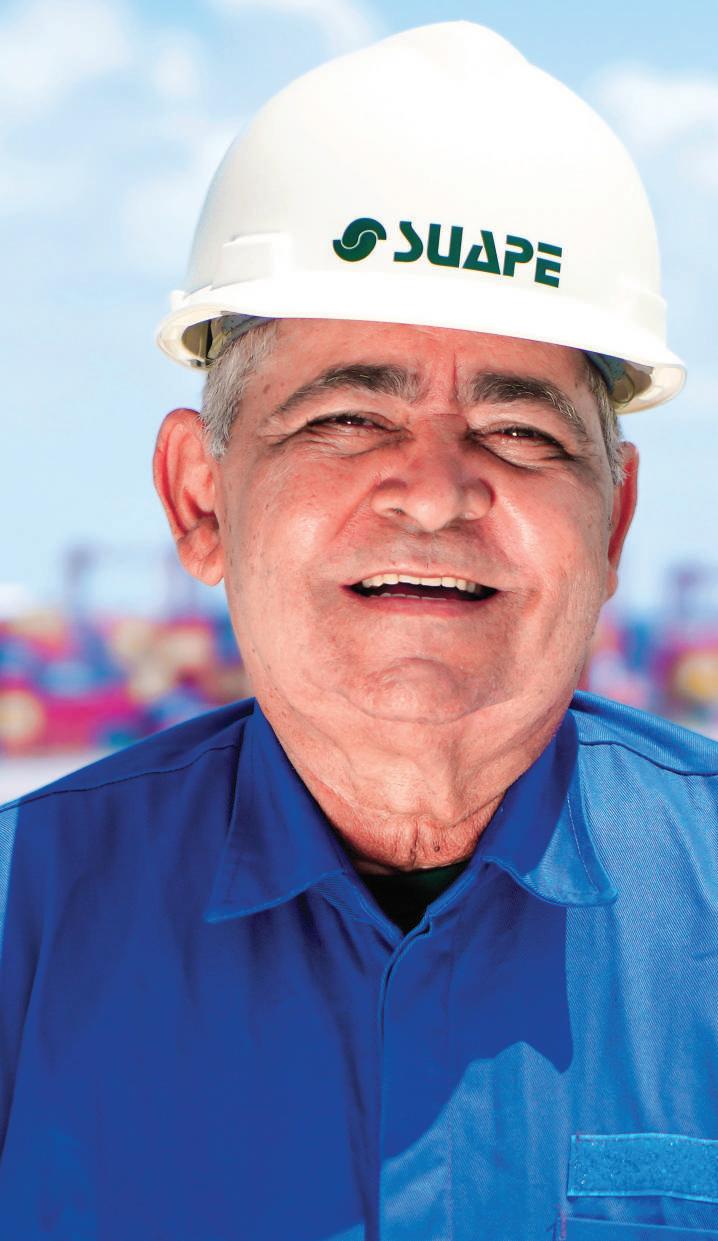

“
Eu vi e vejo tantas empresas chegando, Suape batendo recorde atrás de recorde de cargas, o desenvolvimento, as oportunidades de empregos, a explosão econômica. Para mim, é um orgulho e o melhor lugar onde eu já trabalhei.”
mentos importantes na memória afetiva. Da experiência de ouvir confidências de FHC sobre a função de ocupar o cargo de presidente, enquanto a solenidade de inauguração do porto interno não começava, a outros fatos marcantes, mas nem sempre tão concorridos.
A dragagem do porto interno e da bacia de evolução e obras importantes de infraestrutura fazem parte da relação entre Manoel e Suape. Ele também presenciou a chegada de grandes investimentos, como o primeiro operador privado de contêineres, a Refinaria Abreu e Lima, os estaleiros. Em uma retrospectiva de todo esse tempo dedicado à empresa, ele faz uma declaração que é um mix de satisfação e muito orgulho:
- Eu vi e vejo tantas empresas chegando, Suape batendo recorde atrás de recorde de cargas, o desenvolvimento, as oportunidades de empregos, a explosão econômica. Para mim, é um orgulho e o melhor lugar onde eu já trabalhei.
The story of Suape can be told from many different perspectives in many different ways. The 7th of October 1999 forms part of this long history. On this date, a ship called the Sea Panther moored in Suape’s inner port, ushering in a new strategic stage in the history of the complex. The day also constituted a landmark in the professional life of electrician Manoel Teófilo da Silva Filho, who had been chosen as Suape’s model employee that year. He ended up being invited as a guest of honor to the Sea Panther ceremony. Des-
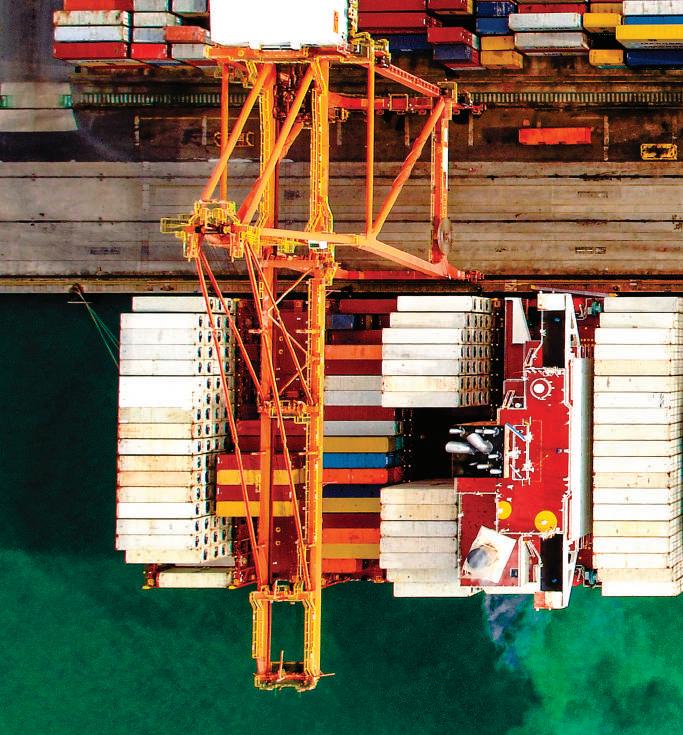
pite being a bit nervous, he accomplished the task of helping then President of the Republic, Fernando Henrique Cardoso, unveil a commemorative plaque.
Manoel still has news clippings of interviews conducted on that day, a letter of congratulation from then Vice-President of the Republic, Marco Maciel, and a few photos of the inauguration. The phrase ‘model employee’, which was highlighted in many of the reports, is still, in his opinion, very appropriate today:

- Suape has saved Pernambuco
Manoel Teófilo has been working at Suape for 35 years. He has seen the complex develop year after year. He has many memories. Such as when FHC told what it was like to be President, while they were waiting for the inauguration of the inner port to begin, and other striking events, though not always as hard won.
Manoel was involved in the dredging of the inner port and of the bay, and other major infrastructure projects at Suape. He also
saw a major influx of investment, including the first private container operator, the Abreu e Lima Refinery, and the shipyards. Looking back over his many years of service, it is with a mix of pride and satisfaction that he is able to declare:
- I have seen so many companies arriving and I still do. Suape constantly beats the records for cargo, development, job vacancies, economic growth. I am very proud of it. It is the best place I have ever worked.
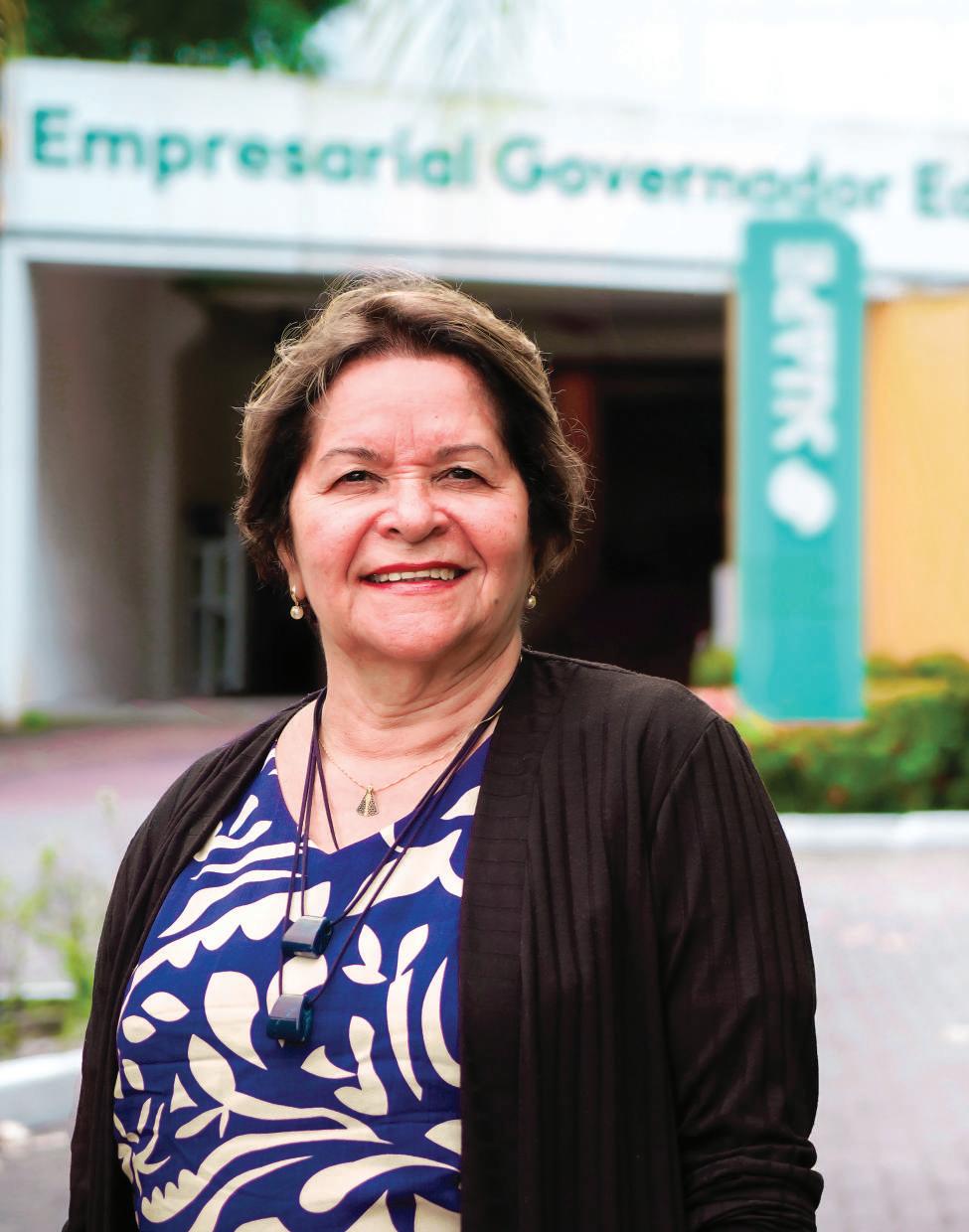
É com grande emoção que olho para trás e vejo as marcas que deixei e as conexões que construí.” “

NADEGE MACIEL
Administradora - Administrator
“Que o futuro seja ainda mais promissor”
Um dia de chuva intensa sempre foi um problema na Suape do final da década de 1970. Na estrada sinuosa de barro batido, o ônibus da empresa que transportava os funcionários não tinha forças para subir a ladeira que dava acesso ao antigo centro administrativo. Só restava aos passageiros uma única opção: enfrentar o resto do caminho a pé.
Nadege Maciel perdeu as contas de quantas vezes teve que encarar esse trajeto para, enfim, chegar ao local de trabalho e começar a rotina. A estrada hoje é asfaltada. O antigo centro administrativo foi desativado e, de inverno a verão, os colaboradores chegam tranquilamente ao moderno prédio da administração de Suape. As lembranças, entretanto, remetem a um tempo que Nadege preserva na memória. Quem passou por momentos como esse é porque foi testemunha de como tudo começou no porto-indústria.
A primeira passagem de Nadege em Suape foi na função de datilógrafa e teve dias de trabalho intenso. Contratos e mais contratos precisavam ser preparados diariamente. As obras eram muitas, exigindo licitações, concorrências. Quanto mais o tempo avançava, maior era o ritmo de trabalho das datilógrafas. Tudo feito manualmente.
Nadege foi aprovada em um concurso para a área de finan-
ças da Petrobras e deixou Suape, em 1979. Dois anos depois, foi convidada a retornar. Só que, em vez do vínculo por uma empresa terceirizada, ela voltou como funcionária da estatal portuária no setor financeiro. De lá para cá, ocupou várias funções, inclusive em cargo de chefia.
- Fui chefe da Divisão de Finanças, em 1998. Depois, fui supervisora de Planejamento, em 2003, e, três anos depois, coordenadora-executiva.
Nadege presenciou muitas mudanças em Suape ao longo do tempo. Participou de datas marcantes - como a chegada de grandes investidores. Da antiga máquina de escrever à transformação digital, que deixa tudo mais rápido e mais prático, encarou um grande desafio em 2020: a pandemia de covid-19.
- Trabalhei três anos em casa. Mas deu tudo certo. Não manuseamos mais papel. Tudo é feito digitalmente.
Vinculada à Diretoria de Administração e Finanças, Nadege faz, aos 70 anos, uma retrospectiva profissional e declara o seu encantamento por Suape:
- É com grande emoção que olho para trás e vejo as marcas que deixei e as conexões que construí. Continuarei comprometida com o nosso propósito, colaborando com o mesmo entusiasmo que me impulsionou ao longo desses anos. Que possamos seguir trabalhando juntos para um futuro ainda mais promissor.
“May the future hold even greater things”
In the late 1970s, a day of heavy rain was always a problem in Suape. On the winding dirt road, the company bus that was carrying employees to work was not powerful enough to climb the hill that led to the old administrative center. The passengers had no option but to trudge the rest of the way on foot.
Nadege Maciel has lost count of the number of times she had to do this to get to work. The road has now been surfaced. The old administrative center has been closed down and, come summer come winter, everyone has a comfortable journey to Suape’s new modern office building. Nadege, however, remembers the old days well. Such memories are a hallmark of someone who was there when it all began.
Nadege’s first stint at Suape was as a typist and some days she had to work really hard. Every day there was an endless stream of contracts to be typed up. There were many projects, each requiring bids for tender, public contests. Over the years, the typists had to work harder and harder. Everything was done manually.
Nadege was selected for a position in the Petrobras finance department and left Suape in 1979. Two years later, she was invited back. Except that, instead of being hired by an outside contractor, she returned as a fully-fledged Suape staff member in the Financial Sector. Since then, she has occupied various posts, including managerial ones.
- I was Head of Finance, in 1998. Then I was Planning Supervisor, in 2003, and, three years later, executive coordinator.
Nadege has seen many changes at Suape over the years. She has witnessed key events – such as the arrival of major investors. She saw the changeover from typewriter to computer, which made everything much quicker and much more practical, and, in 2020, had to face the enormous challenge of the COVID-19 pandemic.
- I worked from home for three years. But it all worked out fine. We don’t use paper anymore. Everything is digital.
Now working for the Director of Finance and Administration, at the age of 70, Nadege looks back on her career and expresses her fond feelings for Suape:
- I get very emotional when I look back and see the impact I have made and people I have met. I am still very committed to this project, as enthusiastic as I have been all the years I have worked here. Let’s hope we can work together to make the future even better.

KLEBER ROLIM MILLET
Geólogo e Engenheiro Civil - Geologist and Civil Engineer
“Suape
o passado e é o futuro”
“O mundo, para ser globalizado, tem que ser pelo mar”. Foi esse o entendimento que o geólogo e engenheiro civil Kleber Rolim Millet teve no início da década de 1980. Reflexão que entrelaça e amarra a trajetória profissional dele com a de Suape. Kleber teve a mesma interpretação visionária quando esteve pela primeira vez em Suape. A lógica, então, apontou o rumo e o geólogo tomou a decisão de trabalhar em um porto-indústria.
Kleber já era servidor público concursado do Governo de Pernambuco quando foi informado que haveria recrutamento de pessoal para Suape. Dentre as vagas previstas, havia a de engenheiro civil. Ele estava atuando, à época, em um escritório de cálculos. A Cisagro, empresa à qual era vinculado, tinha sido extinta e funcionários estáveis, como ele, seriam redistribuídos sob ordenamento da Secretaria de Administração. O geólogo decidiu concorrer e foi aprovado em processo seletivo.
Designado para a Gerência de Projeto de Engenharia Civil, ele passou a acompanhar e a fiscalizar os projetos de Suape desenvolvidos em um escritório no Rio de Janeiro. O momento era de início da execução de obras no complexo. O destaque era a construção do molhe – proteção de pedras


Suape, simbolicamente para mim, é isso. É o passado e é o futuro.”
no mar - para criar um ambiente de águas calmas, permitindo o trânsito dos navios.
Daquele tempo, Kleber guarda lembranças de que a engenharia funcionava na estação de tratamento de água potável para abastecimento de Suape e de cidades vizinhas. As barragens Bita e Utinga foram obras vinculadas ao Complexo Industrial Portuário e, posteriormente, entregues à Companhia Pernambucana de Saneamento (Compesa) para a exploração. Os demais setores funcionavam numa edificação que originalmente foi um acampamento de obra. O profissional participou ativamente do projeto da ampliação do primeiro centro administrativo.
A convite do tenente-coronel Arthur Cavalcanti Paiva, Kleber passou a integrar a equipe da Defesa Civil de Pernambuco. O que seria um período curto, consumiu 14 anos de dedicação. Ao longo desse tempo, nunca perdeu a conexão com Suape. Muitas vezes foi requisitado pelo também geólogo Francisco Demétrio de Moura Accioly para juntos solucionarem problemas relacionados à geologia no complexo. Kleber aponta três marcos da evolução de Suape: a abertura das operações portuárias (com a chegada do navio Araxá, em 1983), a construção da nova sede administrativa e o plano de compensação ambiental.
Para o geólogo, Suape pode ser traduzido em um episódio recente presenciado por ele no complexo:
- Vi uma cena que eu gostaria de ter fotografado. Uma senhora, com certeza agricultora das proximidades, carregava uma enxada suja de barro apoiada no ombro. Na outra mão, buscava informações no celular. Suape, simbolicamente para mim, é isso. É o passado e é o futuro.
“Suape is the past and the future”
“Globalization has to be by sea”. This was how the geologist and civil engineer Kleber Rolim Millet saw it in the early 1980s. And his career has been bound up with the history of Suape ever since. Kleber saw things the same way when he was first at Suape. This logic led the geologist to make the decision to work for an industrial port.
Kleber was already working as a civil servant for the Pernambuco State Government when he heard that staff were being recruited for the port. The posts on offer included one for a civil engineer. He was at the time working for a structural engineering firm. Cisagro, the organization for which he had worked, had been disbanded and longstanding members of staff, such as himself, had been reassigned to other posts by the Department of Administration. He decided, therefore, to apply for the position at Suape and was duly selected.
Appointed Civil Engineering Project Manager, he supervised and inspected the plans for Suape drafted at an office in Rio de Janeiro. This was a key moment for work at the complex. The main project underway was the construction of a stone breakwater designed to create an area with calm waters to allow ships to pass through.
Kleber recollects that the engineering department was, at that time, working out of the drinking water treatment station designed to supply Suape and neighboring towns. The Bita and Utinga dams were built by Suape and later handed over to Compesa, the State Water Authority. The other sectors were located in a building that was originally part of a works encampment. Kleber played an active role in the expansion of the initial administrative center.
At the invitation of Lieutenant Colonel Arthur Cavalcanti Paiva, Kleber joined Pernambuco’s Civil Defense Team. This was to be a short-term commission, but he ended up spending 14 years there. Throughout this time,
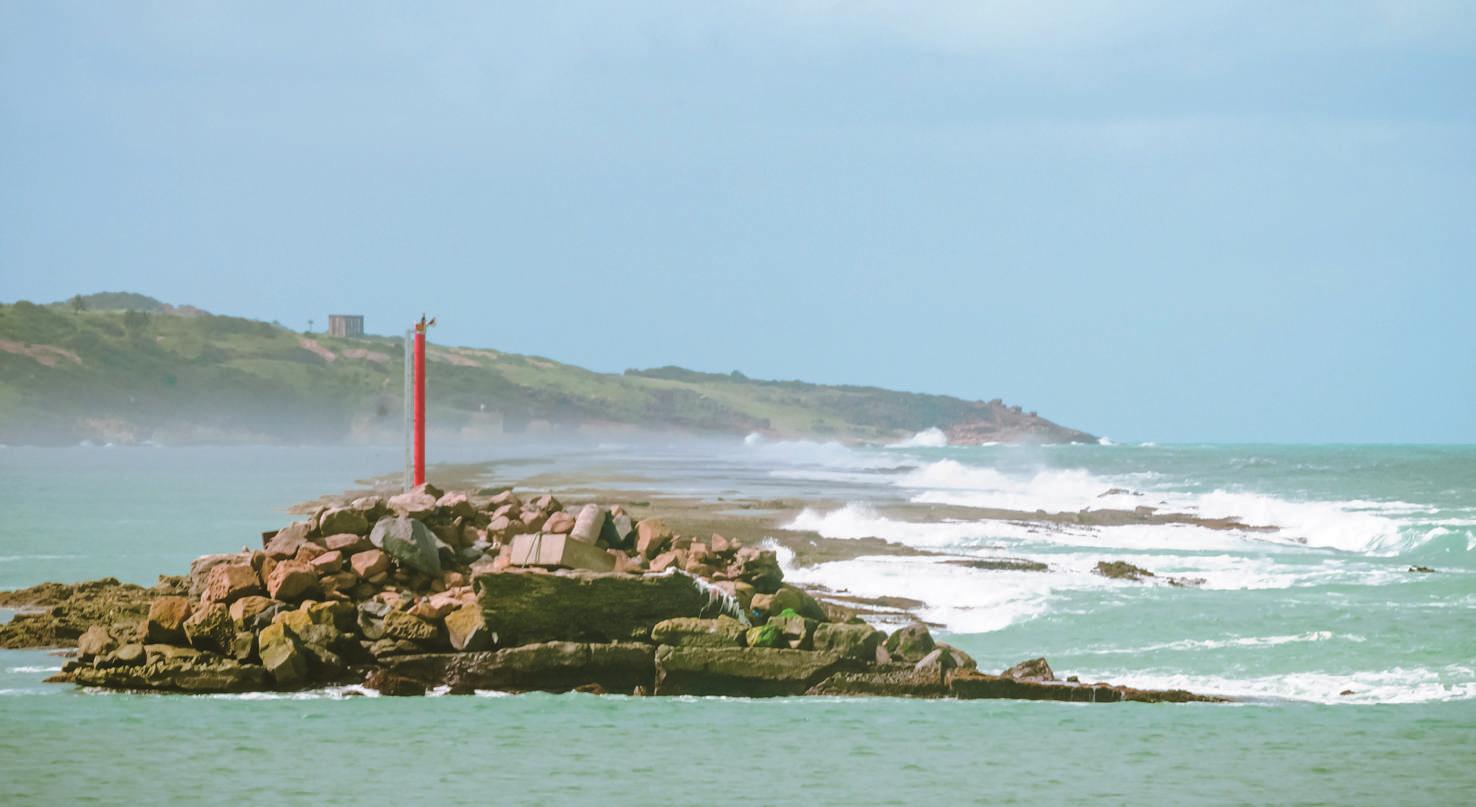
he maintained connections with Suape. He was often requisitioned by the geologist Francisco Demétrio de Moura Accioly to help him solve problems of a geological nature at the complex.
Kleber identifies three stages in the evolution of Suape: the start of operations as a port with the arrival of the Araxá in 1983, the building of a new administrative head office, and the environmental compensation plan.
For this Kleber Milet, Suape is aptly summed up by a scene he witnessed recently at the complex.
- I saw something that I wish I had photographed. An old woman, who obviously worked on a farm somewhere in the vicinity, was carrying a mud-caked spade slung over one shoulder. Meanwhile, she was using her other hand to search for information on a cell phone. This sums up Suape for me. It is the past and it is the future also.
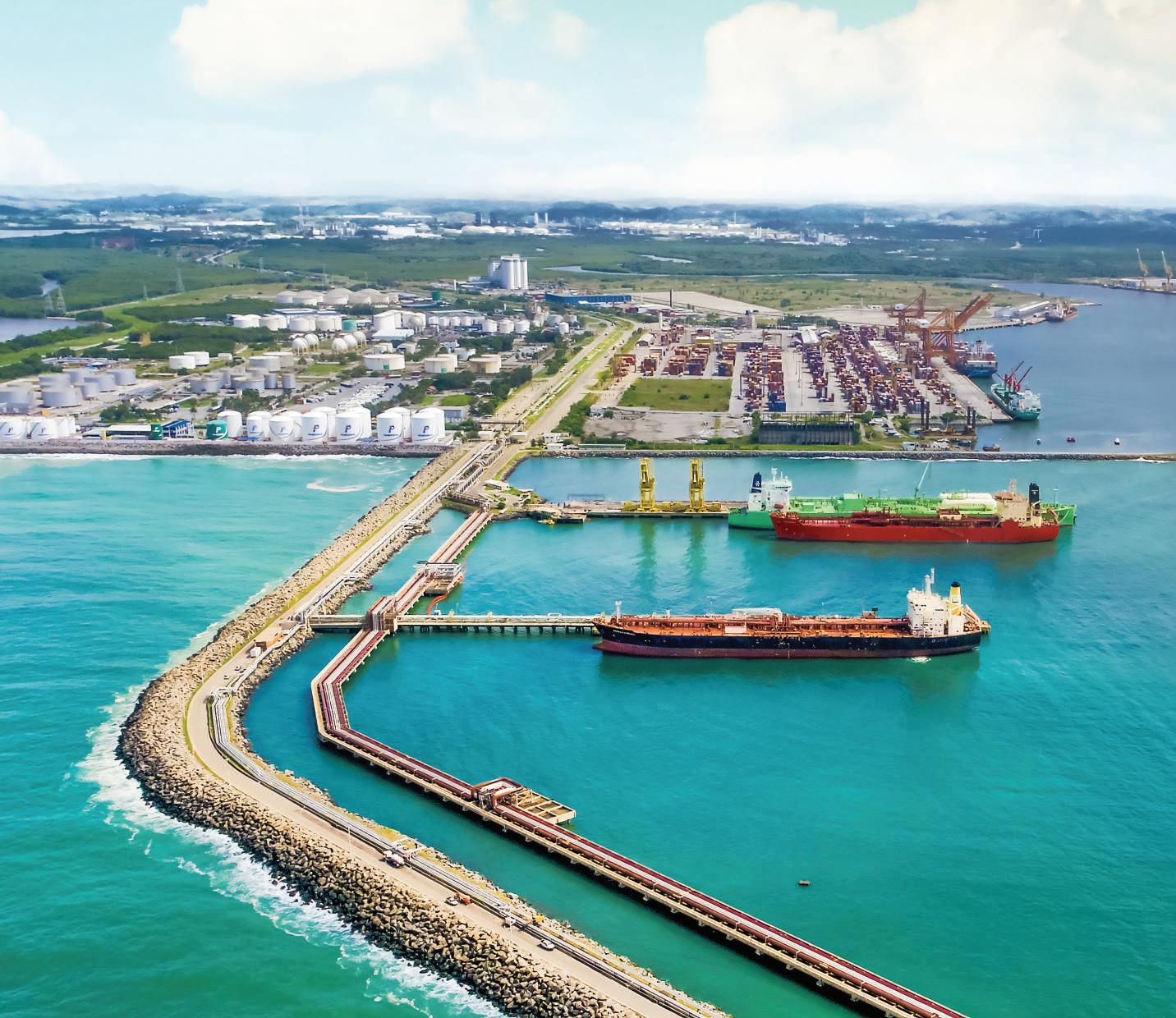

Dizem que o pernambucano tem mania de grandeza. Mas tem como não ser assim quando o assunto é o Complexo Industrial Portuário de Suape? O empreendimento que nasceu com a missão de diversificar a economia do estado – até então ancorada quase que exclusivamente na monocultura da cana-de-açúcar – ostenta números robustos quatro décadas e meia depois. Suape abriga 83 empresas. Juntas, elas empregam mais de 20 mil trabalhadores e trabalhadoras. Só os investimentos privados somam R$ 74,5 bilhões.
Destaque entre os portos públicos do país, Suape conquistou empreendimentos importantes para a economia regional e nacional. Opera durante os 365 dias do ano, 24 horas por dia, sem restrições de marés ou condições climáticas. Em 2023, 1.499 navios atracaram no porto. Entre eles, um porta-contêineres de 347 metros de comprimento que só cabe em atracadouros de classe mundial com infraestrutura compatível.
Quando chegam a Pernambuco, esse e outros gigantes aportam nos berços de atracação de Suape, divididos entre porto interno e porto externo. No total, o porto interno conta com cinco berços, que, além da carga conteinerizada, realizam operações de carga e descarga de trigo, açúcar, veículos, entre outras mercadorias. O hub de veículos já é o maior do Norte/ Nordeste. Opera com exportação, importação e transbordo, e registrou crescimento de 42% em 2023, com a movimentação de 80.647 unidades.
É daqui que saem rumo à Argentina e ao México, por exemplo, os carros produzidos nas fábricas da Jeep, instalada em
Goiana (PE), e da Fiat, localizada em Betim (MG), ambas pertencentes ao Polo Automotivo Stellantis. Veículos fabricados no Uruguai e na Argentina desembarcam em Suape, entram em outros navios por meio das operações de transbordo, e são distribuídos para vários países do continente americano, como Colômbia, República Dominicana, Costa Rica, México e Estados Unidos.
No porto externo, estão localizados quatro píeres de granéis líquidos e o Cais de Múltiplos Usos (CMU). Atracada a um dos píeres, está a tancagem flutuante de GLP (gás de cozinha). Atualmente, Suape é líder nacional na movimentação de granéis líquidos (óleo diesel, gasolina, querosene de aviação, óleo bruto de petróleo, além de outros derivados). Título obtido graças à participação da Refinaria Abreu e Lima (Rnest). Ela pode ter demorado 50 anos para chegar a Pernambuco, mas, depois que começou a operar, vem mudando a economia local. Sozinha, garante 10% do Imposto sobre Circulação de Mercadorias e Prestação de Serviços (ICMS) do estado.
O óleo combustível é o principal produto movimentado por Pernambuco e tem em Singapura o maior importador. Com a retomada da construção do segundo trem de refino da Rnest, a previsão para o futuro próximo não poderia ser melhor. Até 10 mil novos empregos devem ser gerados durante a execução da obra. Depois que a nova etapa estiver concluída, a produção da refinaria será ampliada e a movimentação de granéis líquidos em Suape deve, no mínimo, dobrar.
Para garantir que o óleo da Rnest saia de Pernambuco em petroleiros ainda maiores, como os Suezmax, uma obra impor-

tante será finalizada: a dragagem do canal externo do porto. Um navio-draga de última geração fará a remoção de sedimentos e rochas nos seis quilômetros da área. O canal será aprofundado para 20 metros em toda sua extensão.
Outro resultado esperado com a dragagem é que Suape fique ainda mais atrativo para novas operações. E elas tendem
a chegar mais rapidamente para o complexo com a retomada da autonomia portuária, ocorrida em outubro de 2022. Depois de quase dez anos, Suape retomou a competência para conduzir estudos, elaborar editais, fazer licitações, celebrar e fazer a gestão de contratos relativos aos arrendamentos portuários. Um novo marco.
It is said the people of the State of Pernambuco have delusions of grandeur. Are these not, however, justified when it comes to the Suape Port and Industrial Complex? The undertaking that started out with a mission to diversify the State’s economy – which had up till then depended almost exclusively on sugarcane – can now, four and half decades later, boast very healthy results. Suape is now home to 83 companies, which, combined, directly create employment for over 20,000 workers. Private investment alone totals almost R$ 74,5 billions.
One of the main public ports in Brazil, Suape has become home to businesses that are of vital importance for the regional and national economy. The port operates 365 days a year, 24 hours a day, with no restrictions related to the tides or weather conditions. In 2023, a total of 1,499 ships berthed at the port. These included 347-meter-long container ships that can only be accommodated by world-class docks with compatible infrastructure.
When they arrive in Pernambuco, these and other giant ships berth at Suape’s docks, in either the inner or the outer port. The inner port has a total of five berths, which can load and unload, not only containerized cargo, but also grain, sugar, vehicles, and other goods. The vehicles hub is already the largest in the North and Northeast regions of Brazil. It works with exports, imports, and transshipment, and recorded growth of 42% in 2023, with a total throughput of 80,647 units.
It is from here, for example, that cars produced by the Jeep plants in Goiana and by Fiat in Betim (both part of the Stellantis Automobile Hub) are shipped to Mexico and Argentina. Vehicles manufactured in Uruguay and Argentina are unloaded in Suape, transferred onto
other ships, and then shipped to various countries in the Americas, including Colombia, the Dominican Republic, Costa Rica, Mexico and the United States.
The outer port contains the four liquid bulk cargo piers and the Multipurpose Quays (MPQs). A floating LPG cooking gas storage tank is moored to one of the piers. Suape is currently a world leader in the shipment of liquid bulk cargos (diesel, gasoline, aviation fuel, crude oil, and other petroleum products) and it owes this achievement to the existence of the Abreu e Lima Refinery (Rnest). It may have taken 50 years to bring the Refinery to Pernambuco, but, since it began operations, it has brought about a veritable transformation in the local economy. Suape alone is responsible for 10% of ICMS (Sale of Goods and Services Tax) revenue in Pernambuco.
Fuel oil is the main product passing through Pernambuco. Now work has recommenced on construction of the second Rnest oil refinery train, the forecast for the near future could not be better. Up to 10,000 new jobs will be created by this construction project. When the new stage is completed, refinery production will be stepped up and Suape’s throughput is expected to increase at least twofold.
To ensure that Rnest oil leaves Pernambuco in even larger oil tankers, such as those of the Suezmax class, it is important to conclude dredging of the port’s outer channel. A state-of-the-art dredger will remove sediment and rocks across a six-kilometer area. The depth will be increased 20 meters along the whole length of the channel.
Another expected result of dredging is that it will make Suape even more attractive to new operations. These are tending to appear more rapidly now, after the complex regained its autonomy
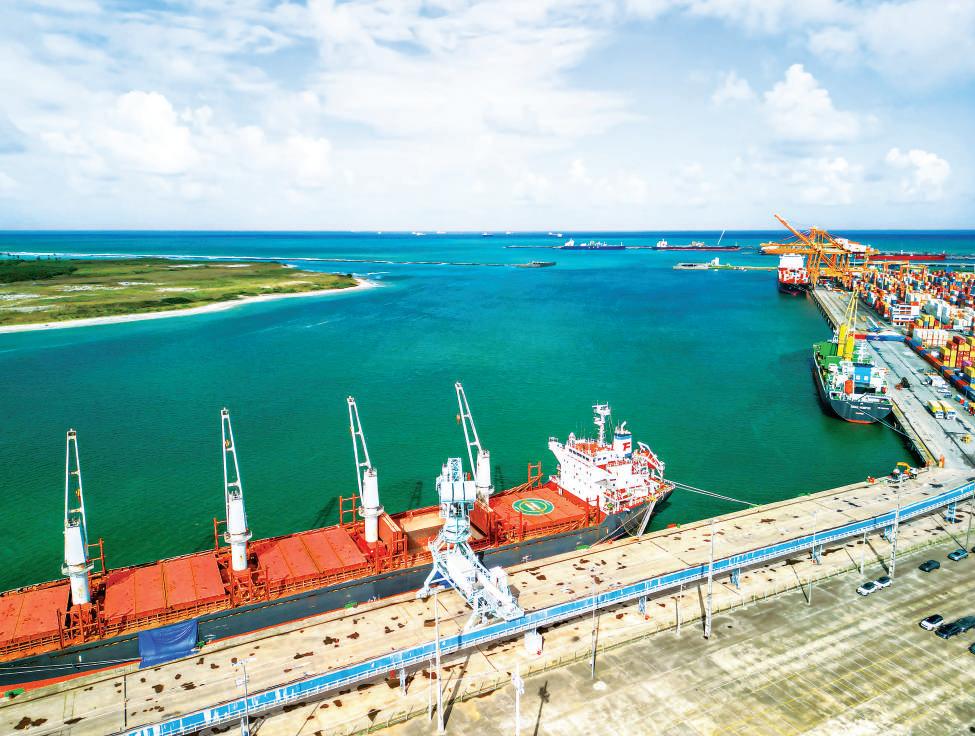
as a port, in October 2022. After almost ten years, Suape is now once again able to conduct studies, put out calls for projects and bids for tender, and sign and manage the port’s leasehold contracts. This is a new milestone.
Suape conta com 12 polos industriais instalados por todo o seu território. Tem o logístico, o de material de construção, o metalmecânico, o naval e offshore. A área também reúne polos de granéis líquidos e gases, componentes eólicos, pré-forma PET e plástico, petroquímico, alimentos e bebidas, de serviços, farmacoquímico e geração de energia. O petroquímico é formado por empresas líderes na produção de PTA e resina PET, que fazem do complexo o maior hub para a cadeia da indústria de embalagens plásticas e de PET da América do Sul.
Já o polo de alimentos e bebidas abriga empresas importantes do setor, como a Bunge, que produz quase duas mil toneladas de farinha e pré-misturas de trigo por dia para as indústrias de panificação, biscoito e massas. Na área, estão instaladas também as fábricas da Coca-Cola, Pepsico e Camil.
O polo farmacoquímico “estreou” com a chegada da fábrica do grupo Aché. A terraplenagem da unidade dessa gigante nacional foi iniciada em 2017 e a primeira etapa foi inaugurada dois anos depois. A segunda fase do empreendimento está prestes a ser concluída. Quando estiver em pleno funcionamento, poderá produzir 700 milhões de unidades de medicamentos por ano.
Outra gigante do setor está chegando a Suape. No segundo semestre de 2022, foi assinado um contrato de aquisição de um terreno onde será implantada uma nova indústria, com investimento acima de R$ 1 bilhão. A planta contará com uma grande estrutura e com 36 linhas de produção. Poderá fabricar até o chamado Ingrediente Farmacêutico Ativo (IFA), matéria-prima utilizada na produção de vacinas.
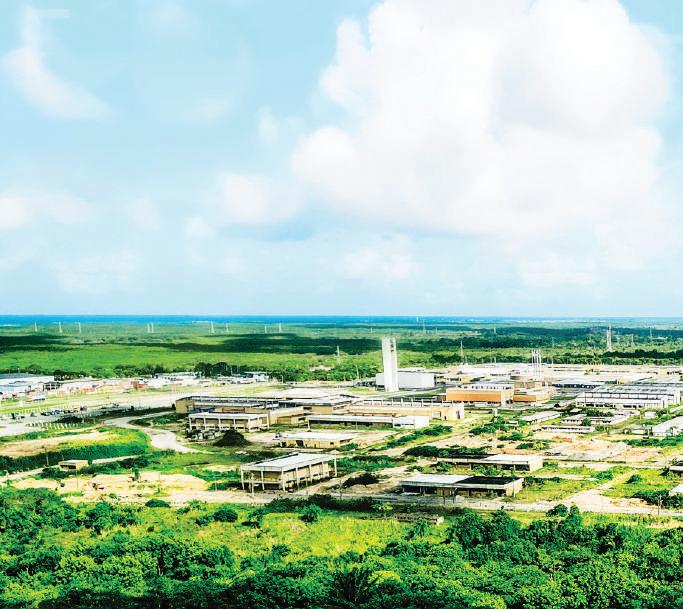
E como Suape funciona como uma cidade, nada mais justo que tenha a infraestrutura de uma. É por isso que o Plano Diretor Suape 2035 contempla a Zona Central de Serviços dentro da Macrozona de Desenvolvimento Econômico. Dela farão parte atividades de prestação de serviços de saúde, educação, lazer, hotelaria, entre outras, para quem circula – diariamente ou só de passagem – nesta grande cidade. Com tantos números positivos e novidades que não param de chegar, fica praticamente impossível deixar de lado uma certa dose da megalomania pernambucana ao falar de Suape. Até porque o que já é grande vai ficando cada vez maior. O Complexo Industrial Portuário não vai deixar de crescer e aparecer.

Twelve industrial hubs have now been installed throughout the Suape site. There is the logistics hub, the construction materials hub, the metalworking hub, and the shipbuilding and offshore construction hub. The area also contains business clusters relating to bulk liquids and gases, wind power turbine components, PET and other plastic preforms, petrochemicals, food and beverages, services, pharmaceutical chemicals, and power generation. The petrochemical cluster includes companies that lead the field in the production of PTA and PET resin, making the complex the largest hub for the plastics and PET packaging chain in South America.
The food and beverages hub includes major companies in the sector, such as Bunge, which produces almost 2,000 tons of flour and wheat flour premix per day for the breadmaking, biscuit and pasta industries. Coca Cola, Pepsico, and Camil also have factories in the area.
The pharmaceuticals hub was launched with the installation of an Aché Group factory. The land clearing for this enormous national company’s facility was started in 2017 and the first stage was completed two years later. The second phase of the undertaking is due to be concluded soon. When the plant is operating at full capacity, it will be able to produce 700 million units of medication per year.
Another huge company in this sector is about to arrive in Suape. In the second half of 2022, a contract was signed to acquire the land on which a new plant will be constructed, with an investment of over R$ 1 billion. The plant will be a huge structure, with 36 production lines. In a possible second phase, it will also manufacture the so-called Active Pharmaceutical Ingredient (API), the raw material used to produce vaccines.
Since Suape functions like a city, it comes as no surprise that it should have a city-like infrastructure. This is why the 2035 Suape Master Plan envisages a Central Services Zone within the Economic Development Macrozone. This will cover health, education, leisure, hospitality, and other services for those living and working in or passing through this great city.
With so many positive figures and such an unceasing stream of new developments, it is practically impossible to resist a touch of Pernambuco-style megalomania when talking about Suape. Not least because something that was already huge is getting even larger. The Port and industrial Complex will never cease to grow and to have an even greater impact on the region.
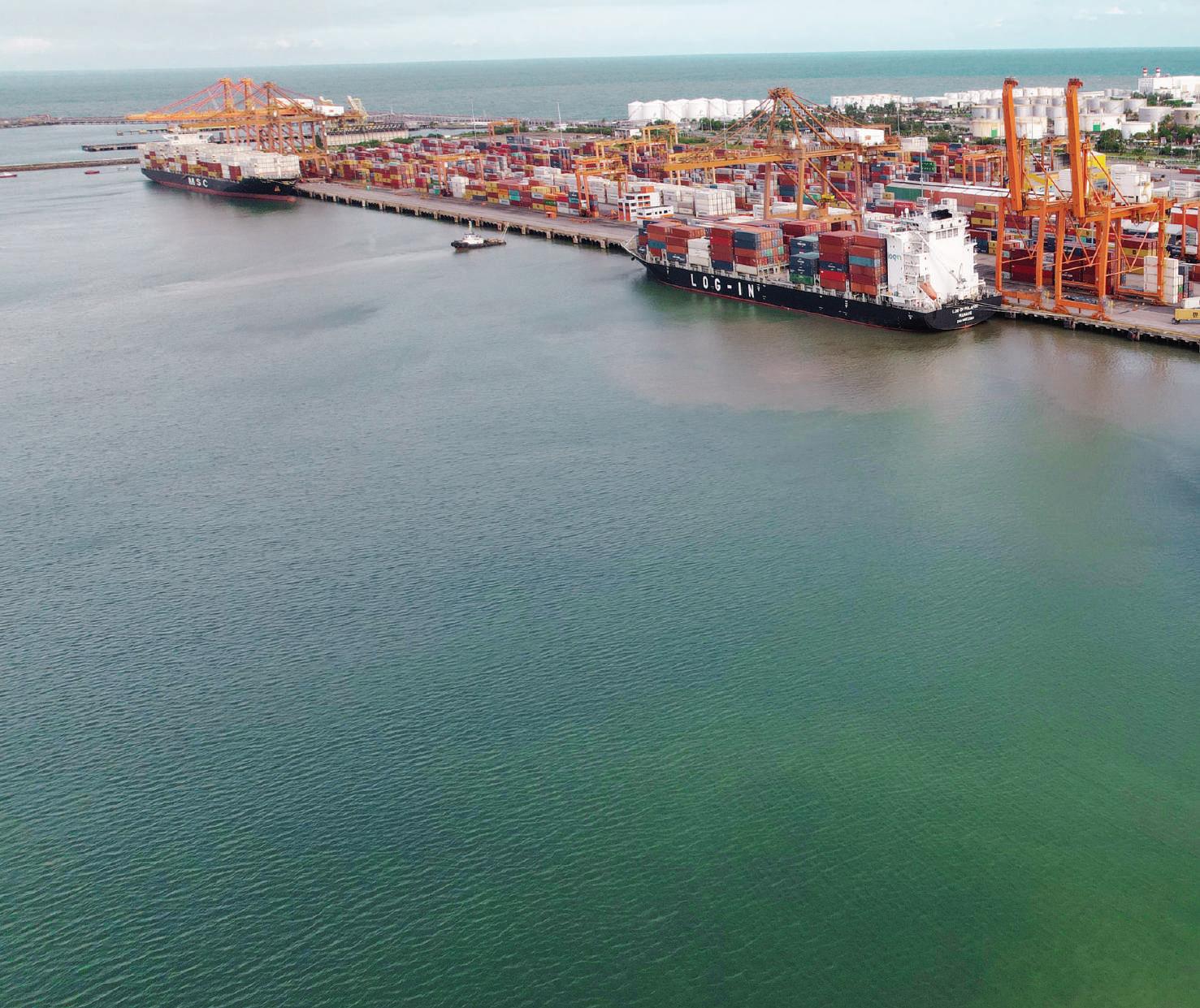

A construção do porto interno de Suape foi concluída em 1999. Possui cinco berços de atracação, o último deles inaugurado em 2009 para movimentar, principalmente, carga geral e granéis sólidos. Dois de seus cinco berços são privados, operados pela empresa Tecon Suape
The construction of Suape’s inner port was concluded in 1999. It has five mooring berths, the last of which was inaugurated in 2009, principally to move general cargo and bulk solids. Two of its five berths are private, operated by Tecon Suape
No dia 11 de março de 2023, um gigante do mar entrou para a história de Suape.
O porto recebeu o APL Dublin, um porta-contêineres de classe mundial, com 347,29 metros de comprimento e 45,28 metros de largura. Foi o maior navio de cargas já atracado em Suape, até aquela data
On 11 March 2023, a giant of the sea entered Suape’s history. The port welcomed the APL Dublin, a world-class container carrier, 347.29 meters long and 45.28 meters wide. It was the largest cargo vessel ever to have put into Suape Port up to that time




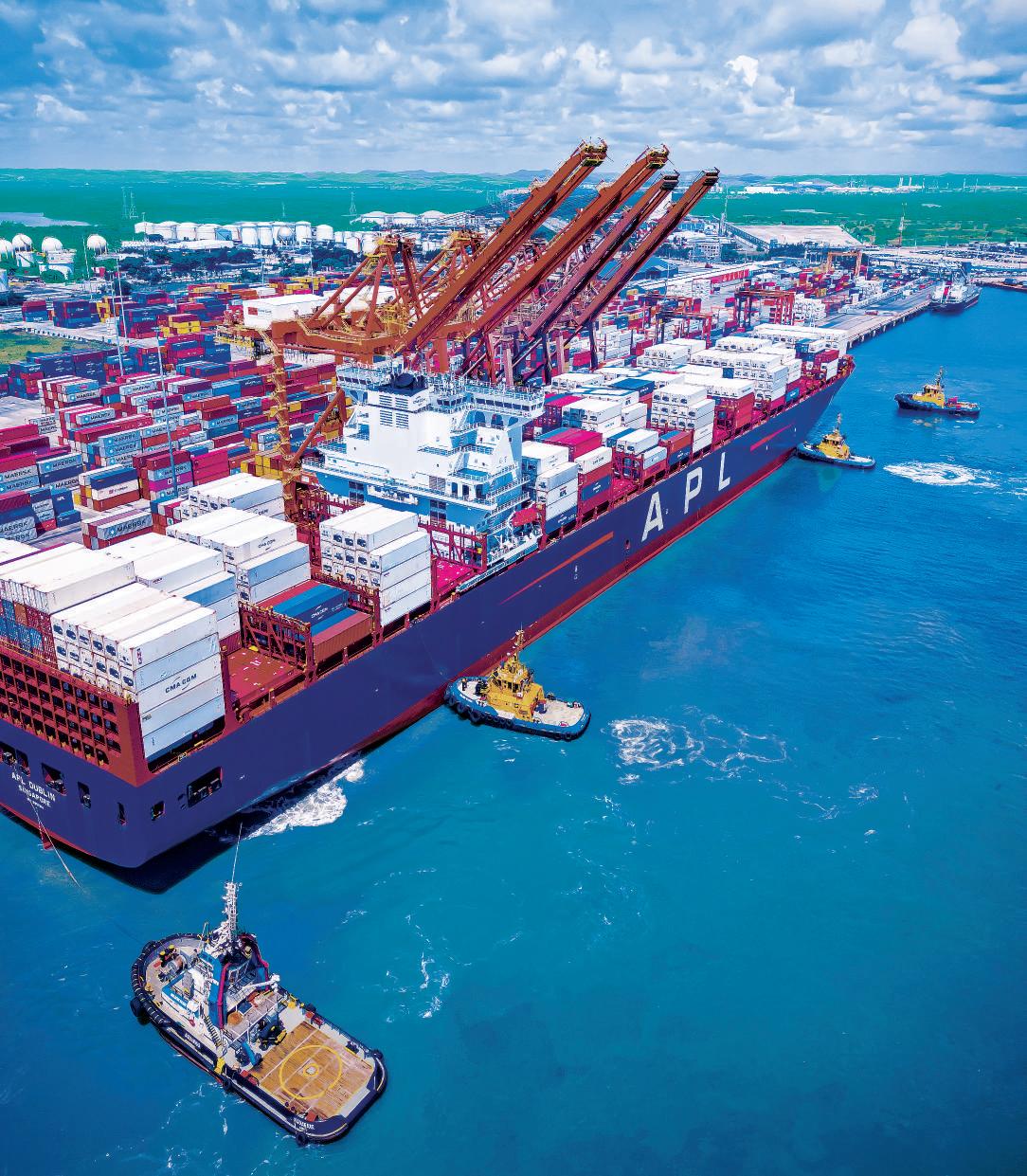
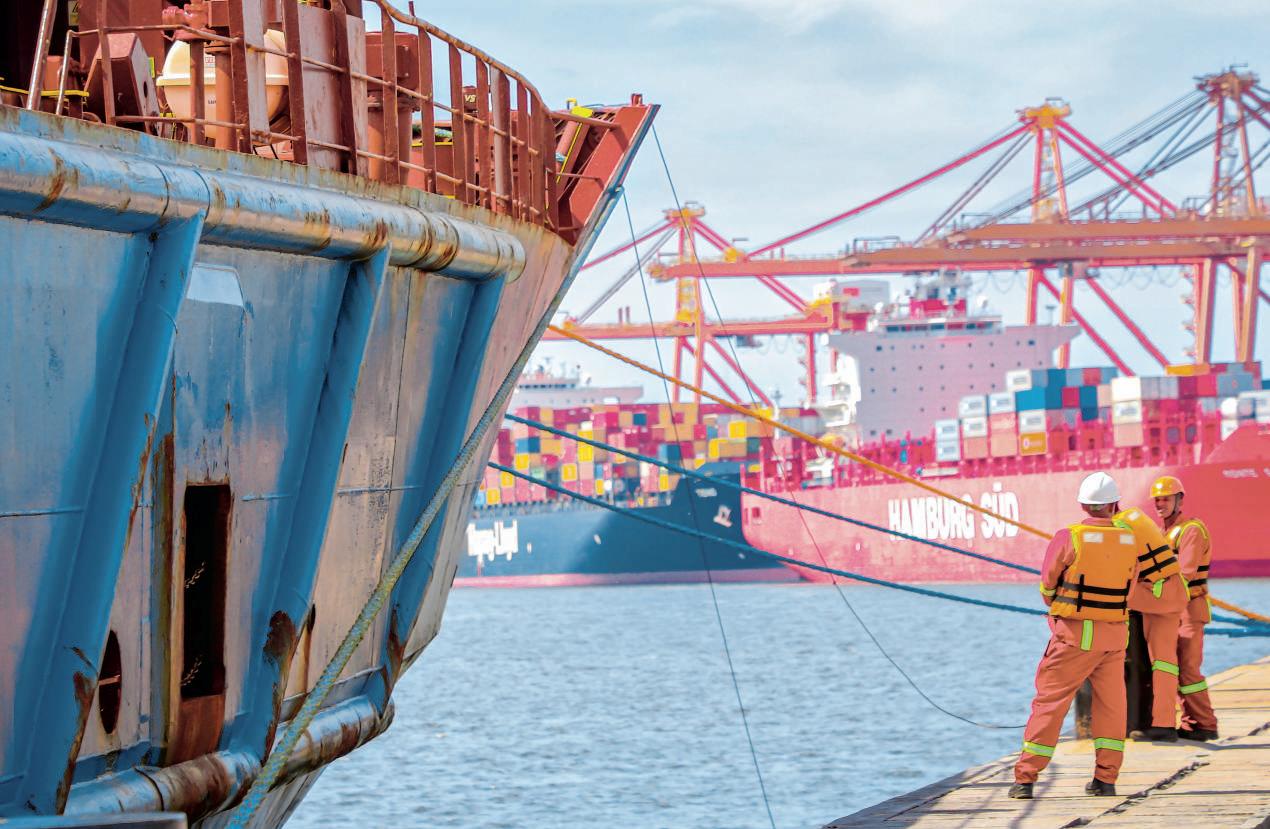
Operadores de atracação fazem um minucioso trabalho antes da entrada e da saída de navios do porto. Tudo é conferido nos mínimos detalhes para que as atracagens e as operações de carga e descarga ocorram com precisão e no menor tempo possível
Mooring operators undertake careful work prior to the arrival and departure of ships at the port. Every tiniest detail is checked so that berthing and the loading and unloading of cargo can be carried out as quickly and efficiently as possible
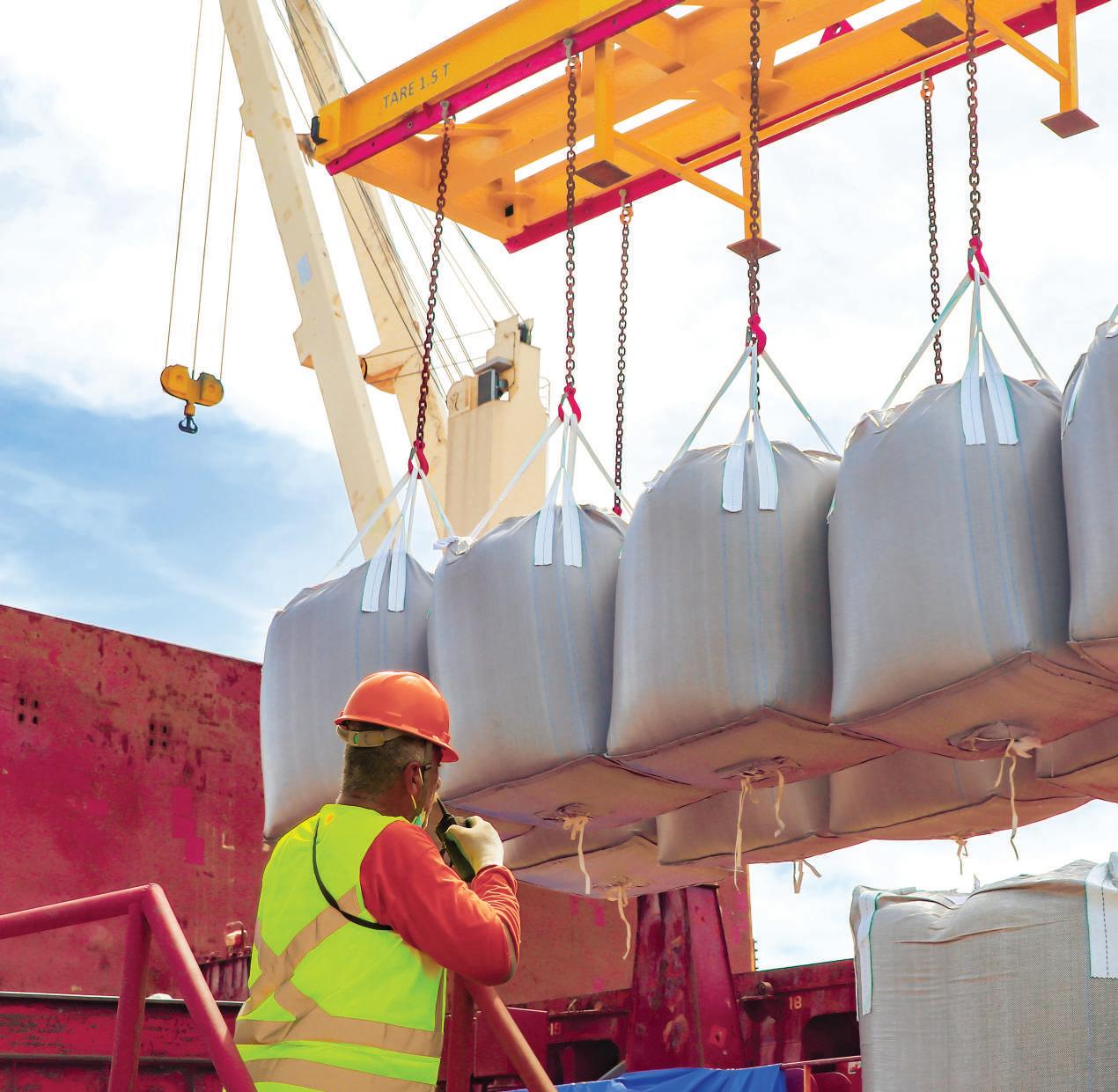
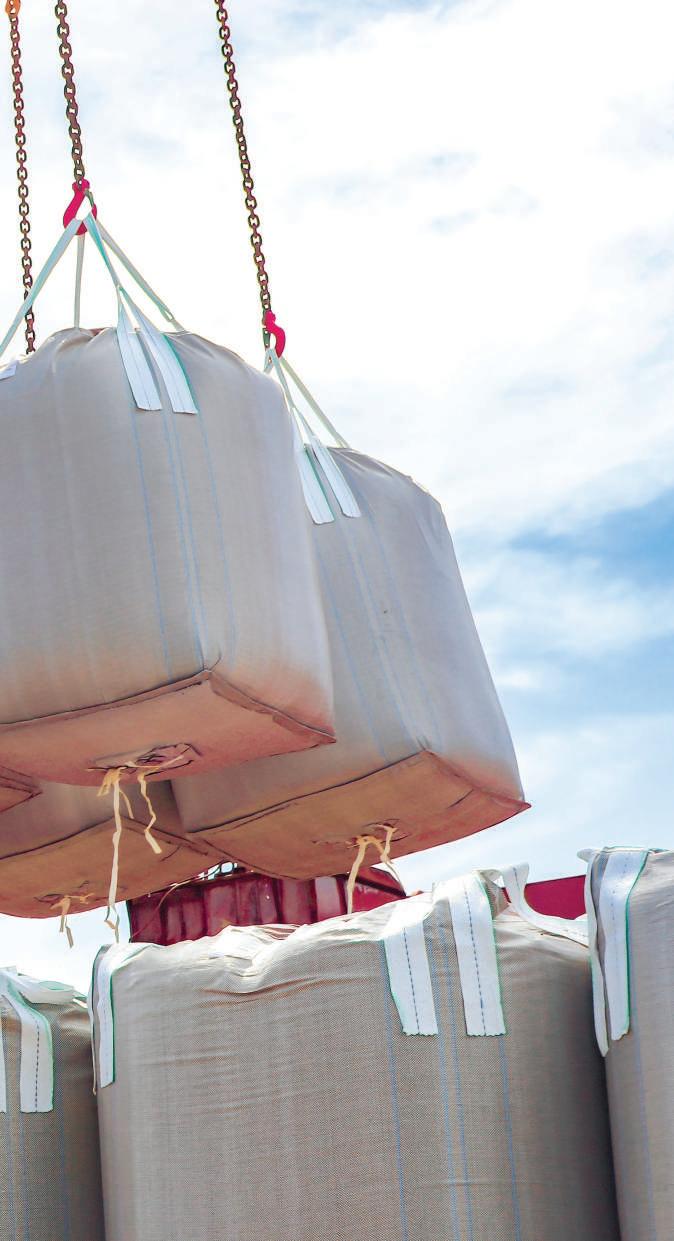
O berço 4 do cais interno é público. É por ele que entra e sai a chamada carga geral, que inclui, por exemplo, produtos e materiais não conteinerizados, como chapas de aço, açúcar ensacado e pás eólicas. Também é onde atracam os navios carregados de veículos
Berth 4 of the inner quay is public. It is here that so-called general cargo comes in and goes out, including, for example, non-containerized products and materials, such as sheet steel, sacks of sugar, and wind turbine blades. It is also where ships carrying vehicles are loaded and unload their cargo

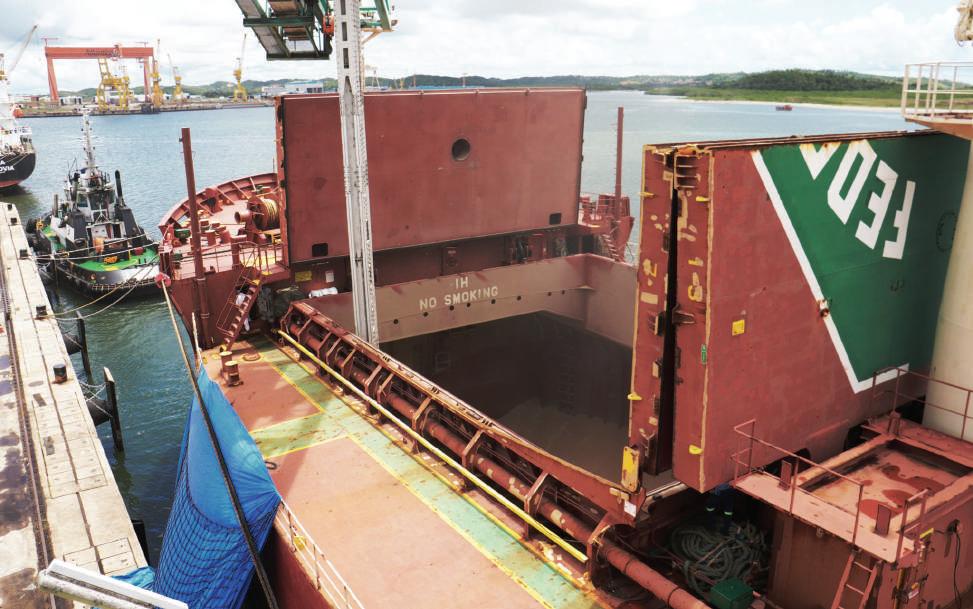



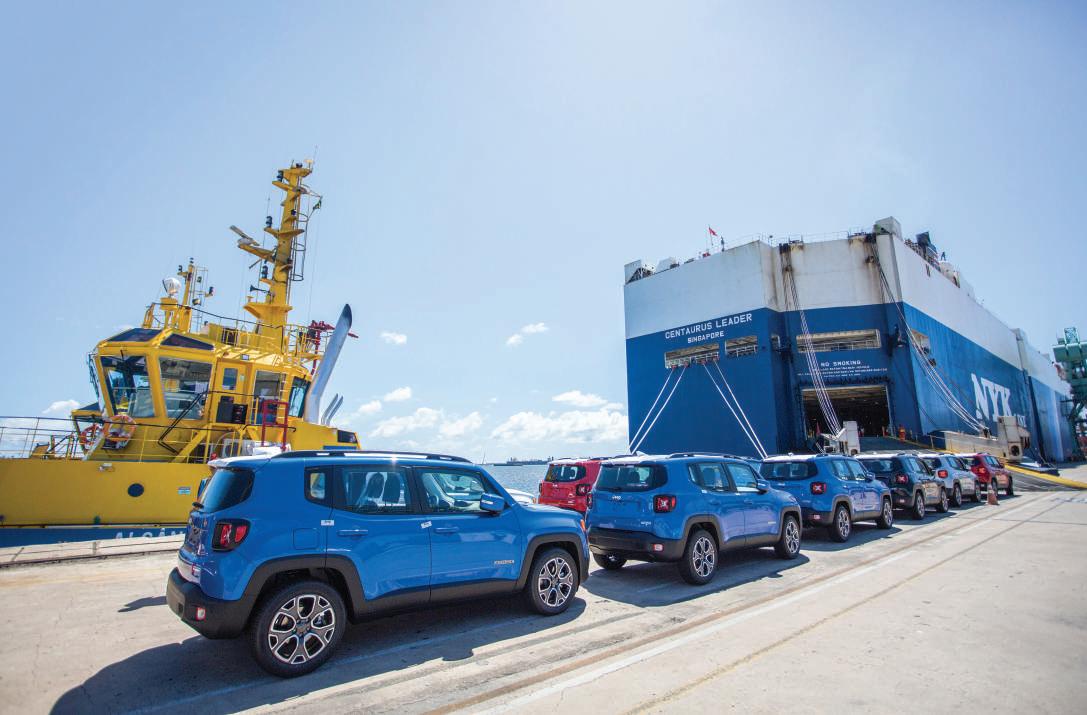
O hub de veículos não para de crescer. Opera com exportação, importação e transbordo. Registrou crescimento de 42% em 2023, com a movimentação de 80.647 unidades, a maior do Norte e Nordeste
The vehicles hub never stops growing. It works with exports, imports and transshipment. Registered an increase of 42% in 2023, shipping 80.647 units, the most of any port in the North and Northeast regions
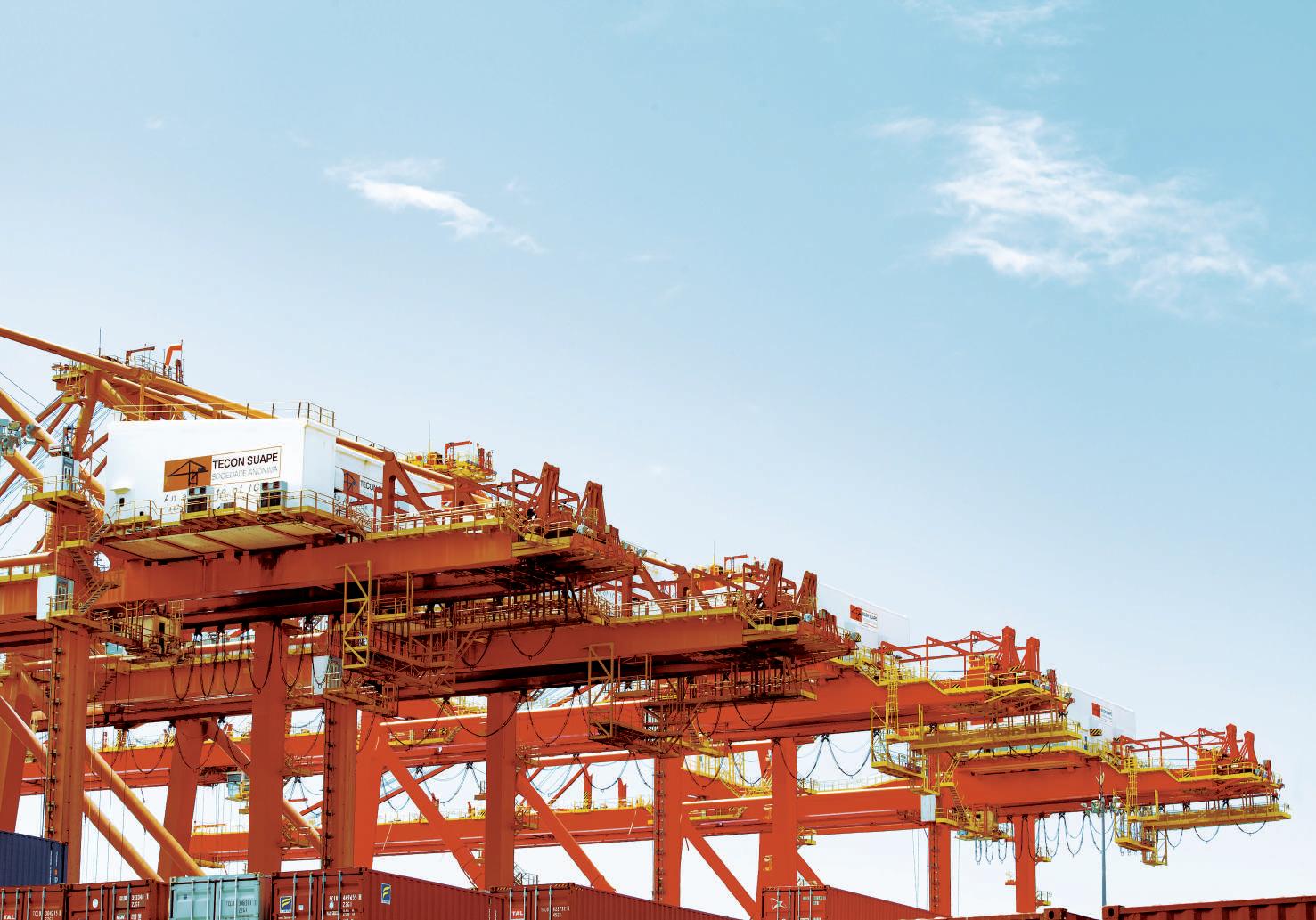

Equipamentos e movimentação no Tecon Suape

Facilities and throughput at Tecon Suape

A movimentação de contêineres é a maior do Nordeste. As imagens mostram o Tecon Suape, primeiro terminal privado do porto. A empresa iniciou suas operações em 2002
Suape is the largest shipper of containers in the Northeast region of Brazil. The images show Tecon Suape, the port’s first private terminal. The company began operations in 2002

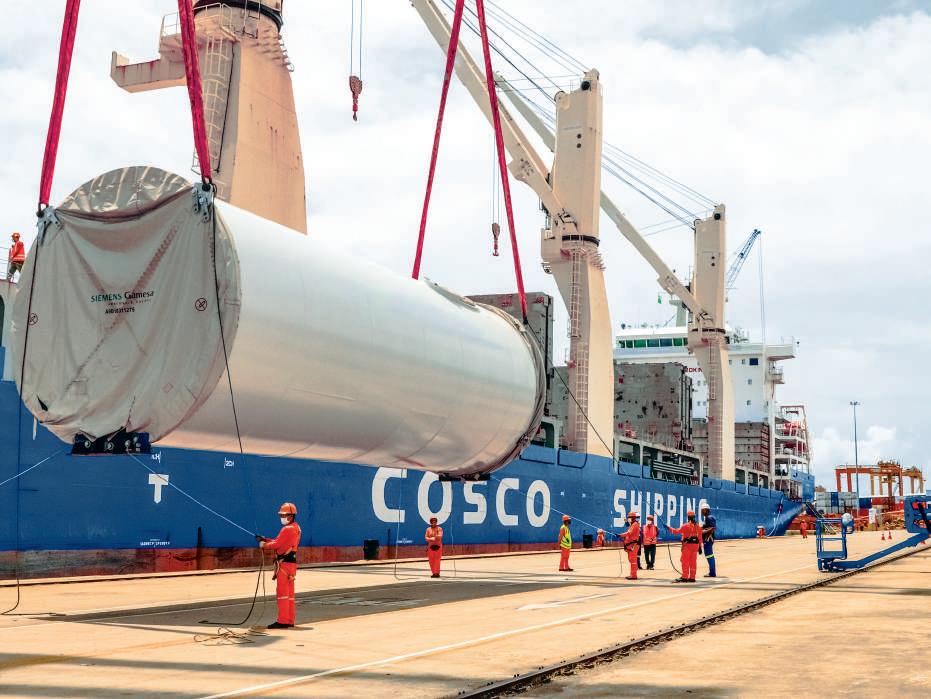

Suape também é o líder brasileiro no transporte de cargas por cabotagem - entre os portos do país. O complexo pernambucano conseguiu superar grandes portos, como o de Santos (SP), o maior atracadouro nacional

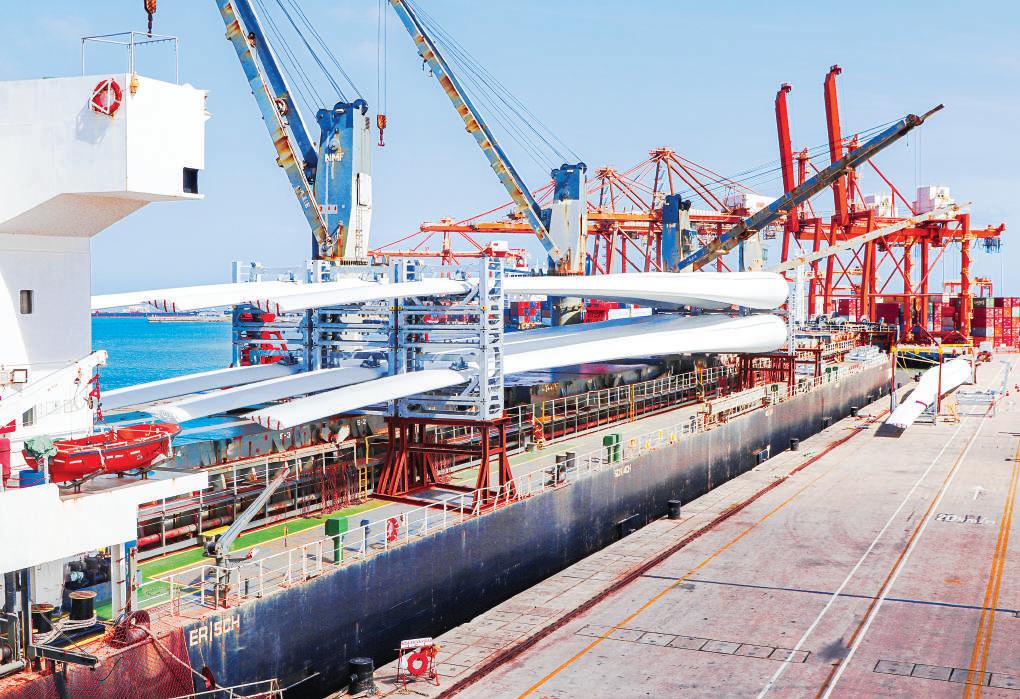
Suape is also a leading player in Brazil in the transport of cargo by cabotage – from one port in the country to another. Pernambuco’s port has managed to outclass larger ones, such as Santos (in the State of São Paulo), which is the largest in Brazil
Área de águas abrigadas e repleta de história. É onde passado, presente e futuro se cruzam, apontando rumos de mais prosperidade. Conta com um Cais de Múltiplos Usos, um píer exclusivo de granéis líquidos, outro de granéis líquidos e gases, e um reservado aos petroleiros, além de uma bacia de evolução de navios
An area of sheltered waters replete with history. Here past, present and future cross paths, pointing the way forward to greater prosperity. The outer port has a multipurpose quay, a pier exclusively for bulk solids, another for bulk liquids and gases, and yet another reserved for oil tankers, along with a shipbuilding yard
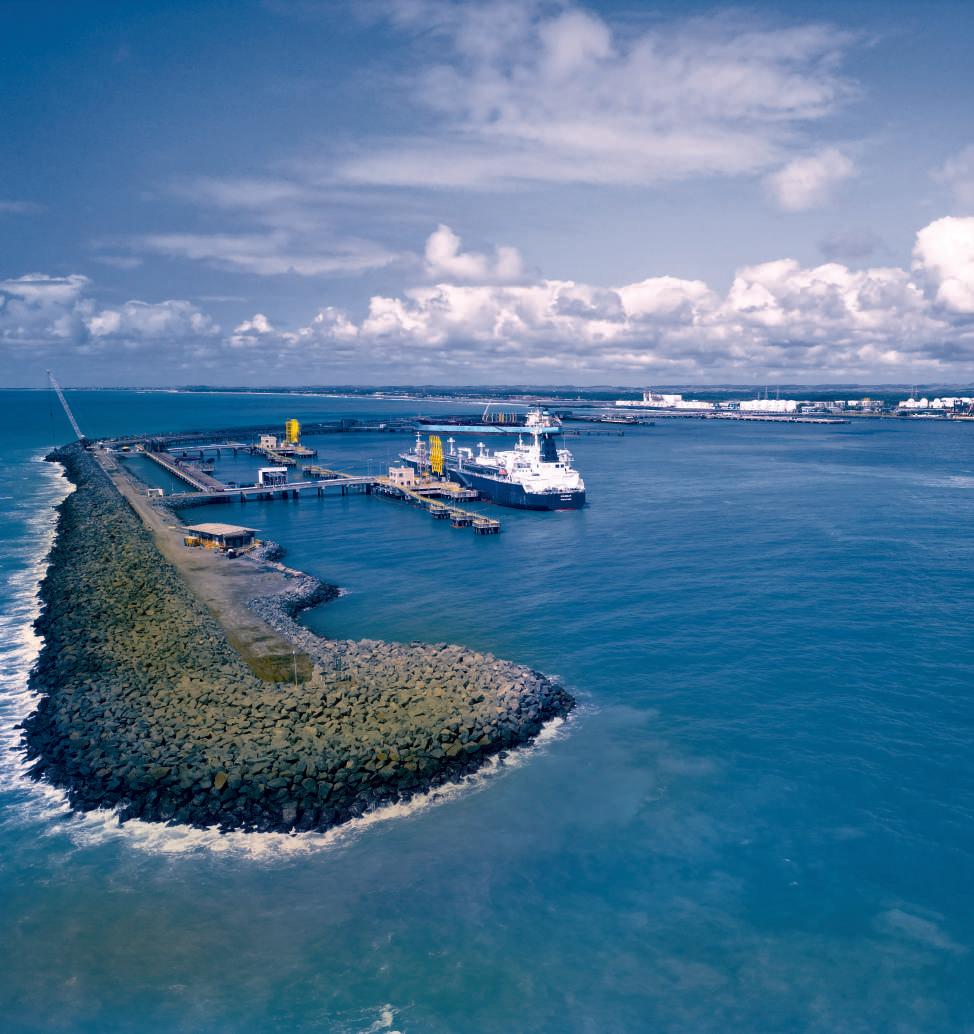

Suape bate recordes atrás de recordes. É líder nacional na movimentação de granéis líquidos. Posição que vai ficar ainda mais pujante com a ampliação da Refinaria Abreu e Lima, os investimentos no parque de tancagem e a atração de novos negócios
Suape never stops beating records. It is currently a national leader in the shipment of bulk liquids and is constantly consolidating this position with the expansion of the Abreu e Lima Refinery, investment in the tanking park, and efforts to attract new business
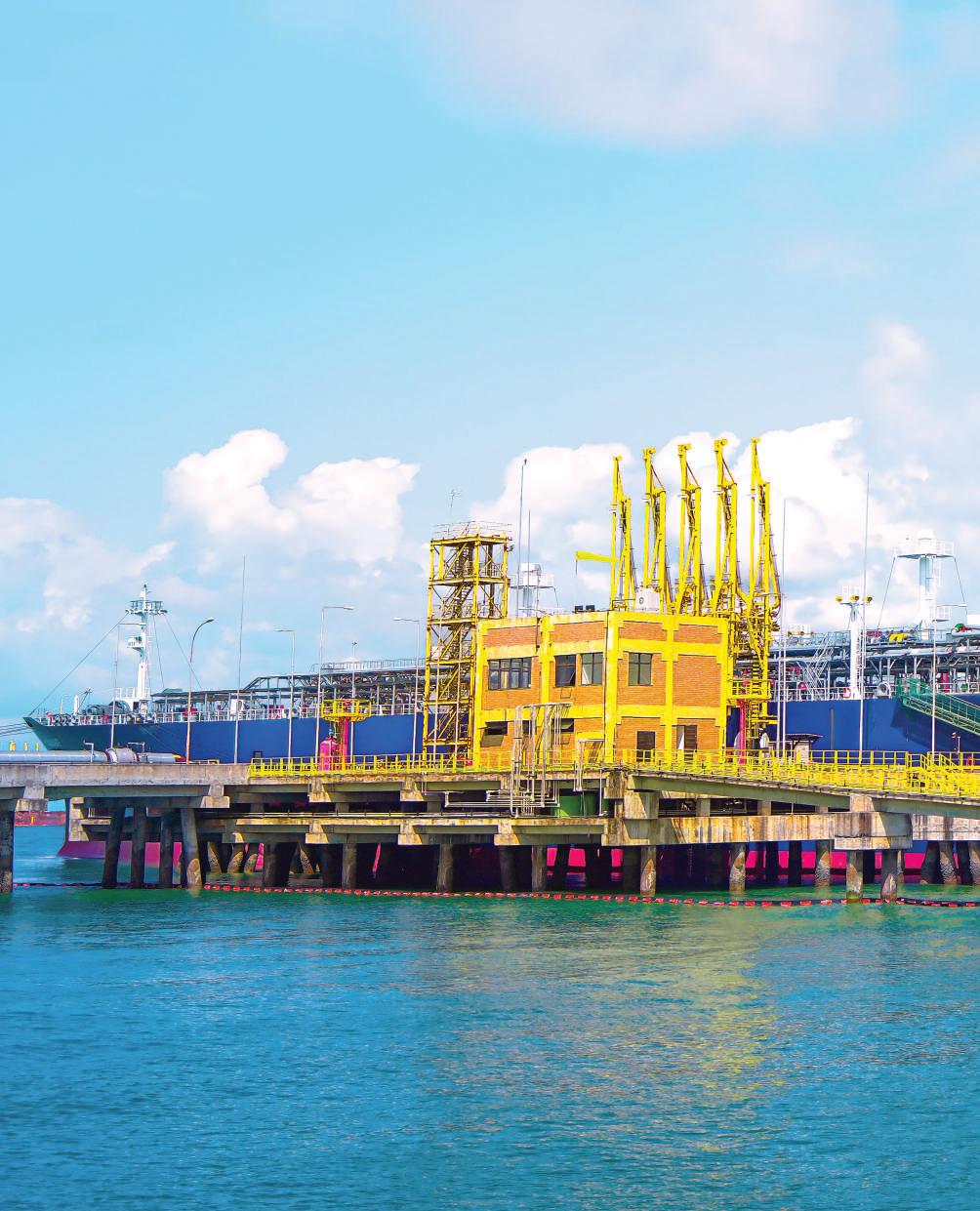
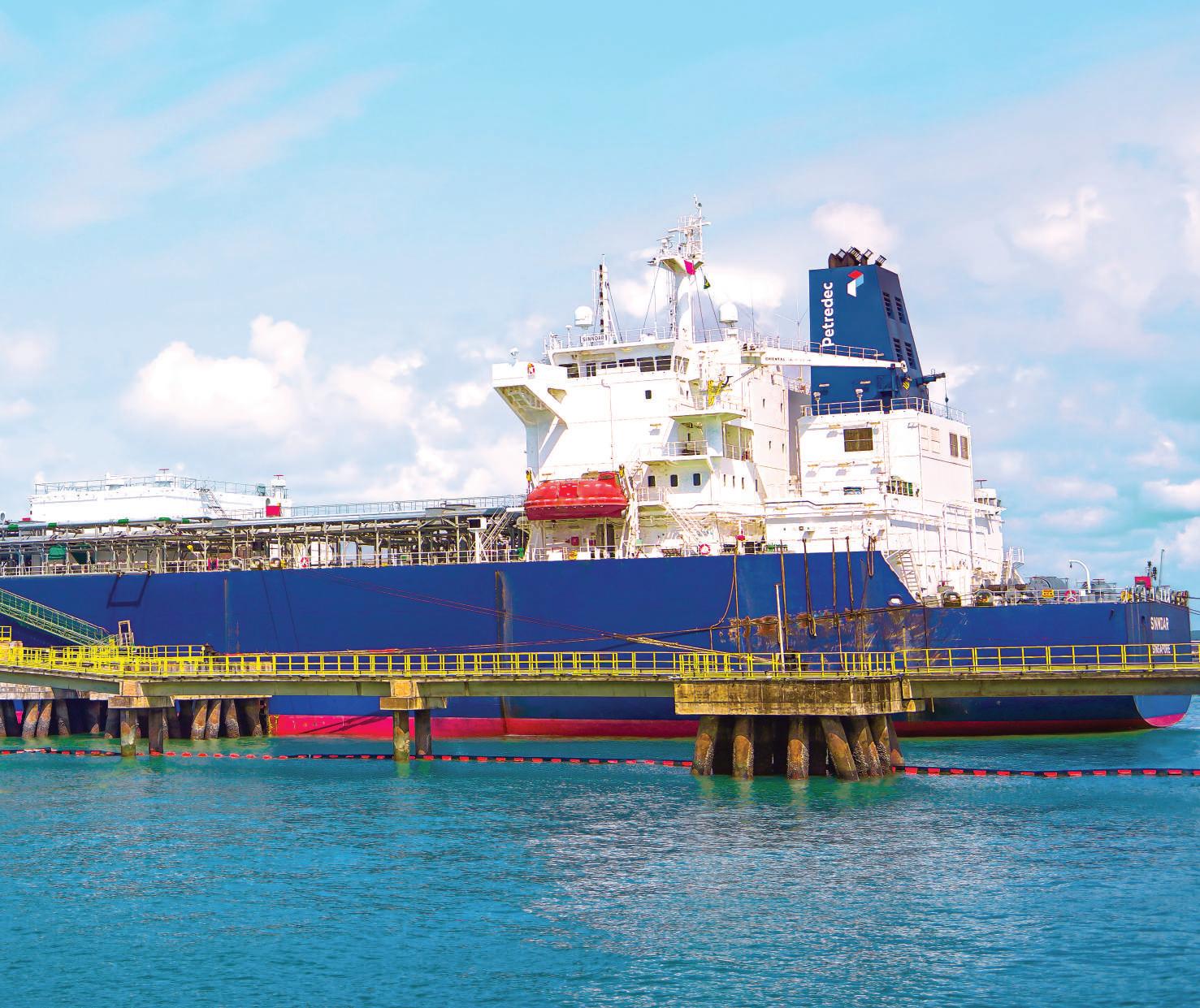


Operação que acontece na movimentação de granéis líquidos, quando dois navios se posicionam lado a lado para que ocorra a transferência de carga de um para o outro. Será replicada no futuro Terminal de Regaseificação de Gás Natural Liquefeito, no Cais de Múltiplos Usos
A type of operation used to move bulk liquids, involving two ships positioning themselves alongside one another to transfer cargo from one to the other. This will be replicated at the future Liquid Natural Gas Regasification Terminal on the Multipurpose Quay
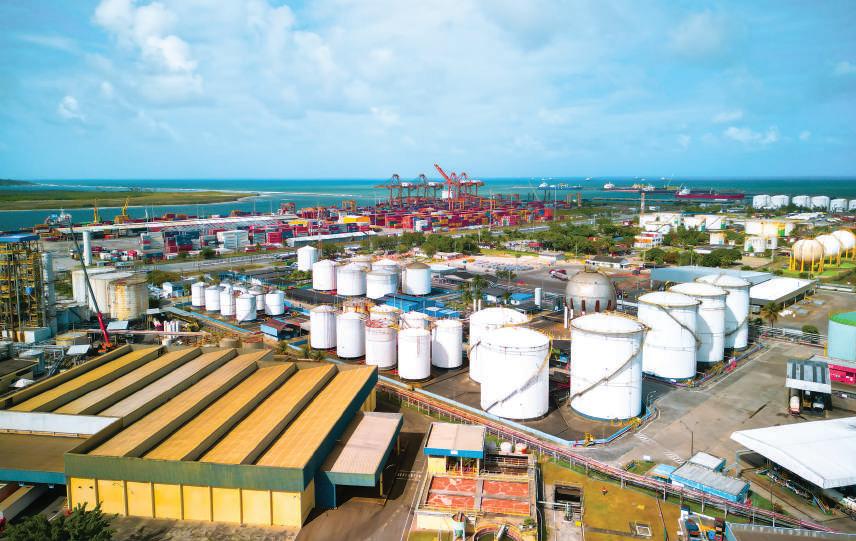

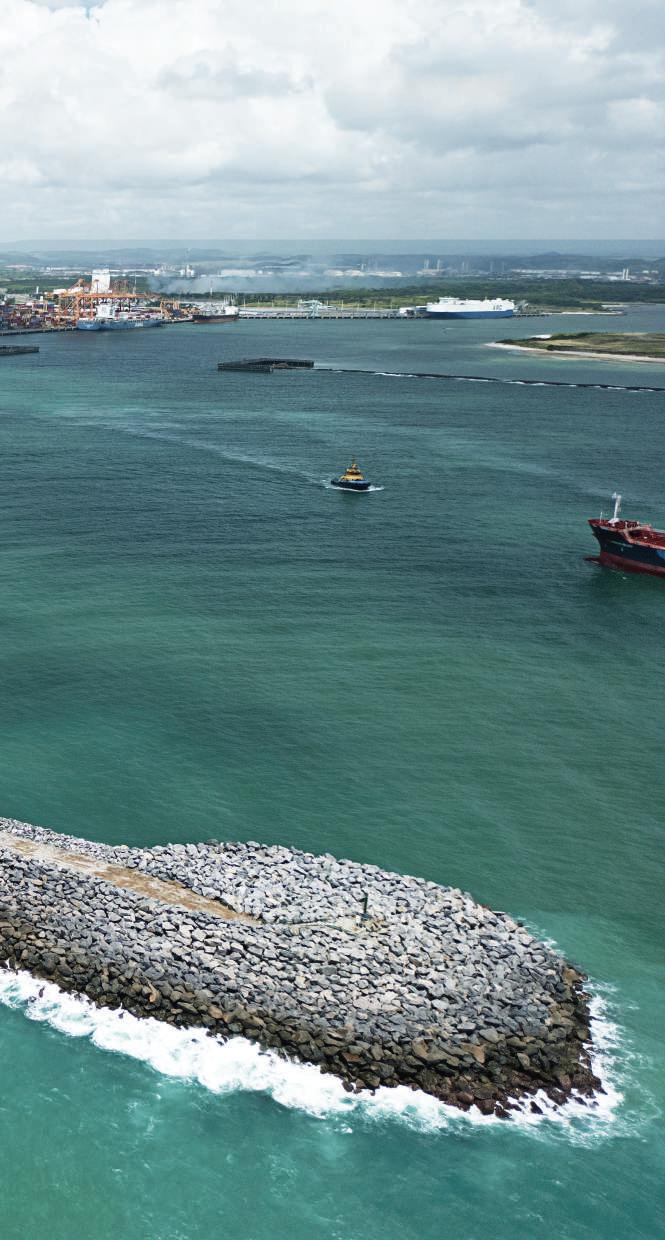
Imagem do cais externo e de sua bacia de evolução de navios
Infrastructure
Image of the outer port and bay for ships

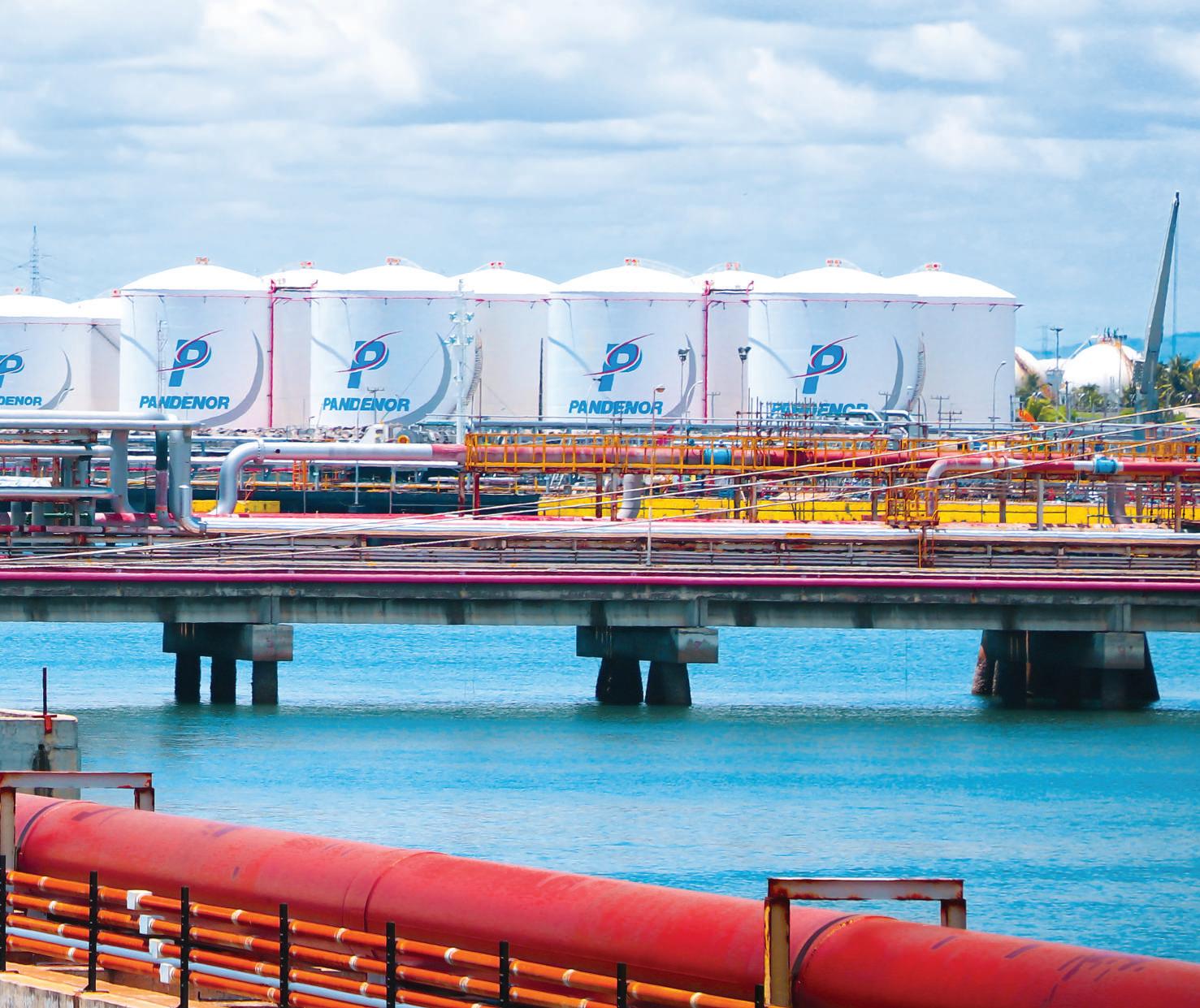
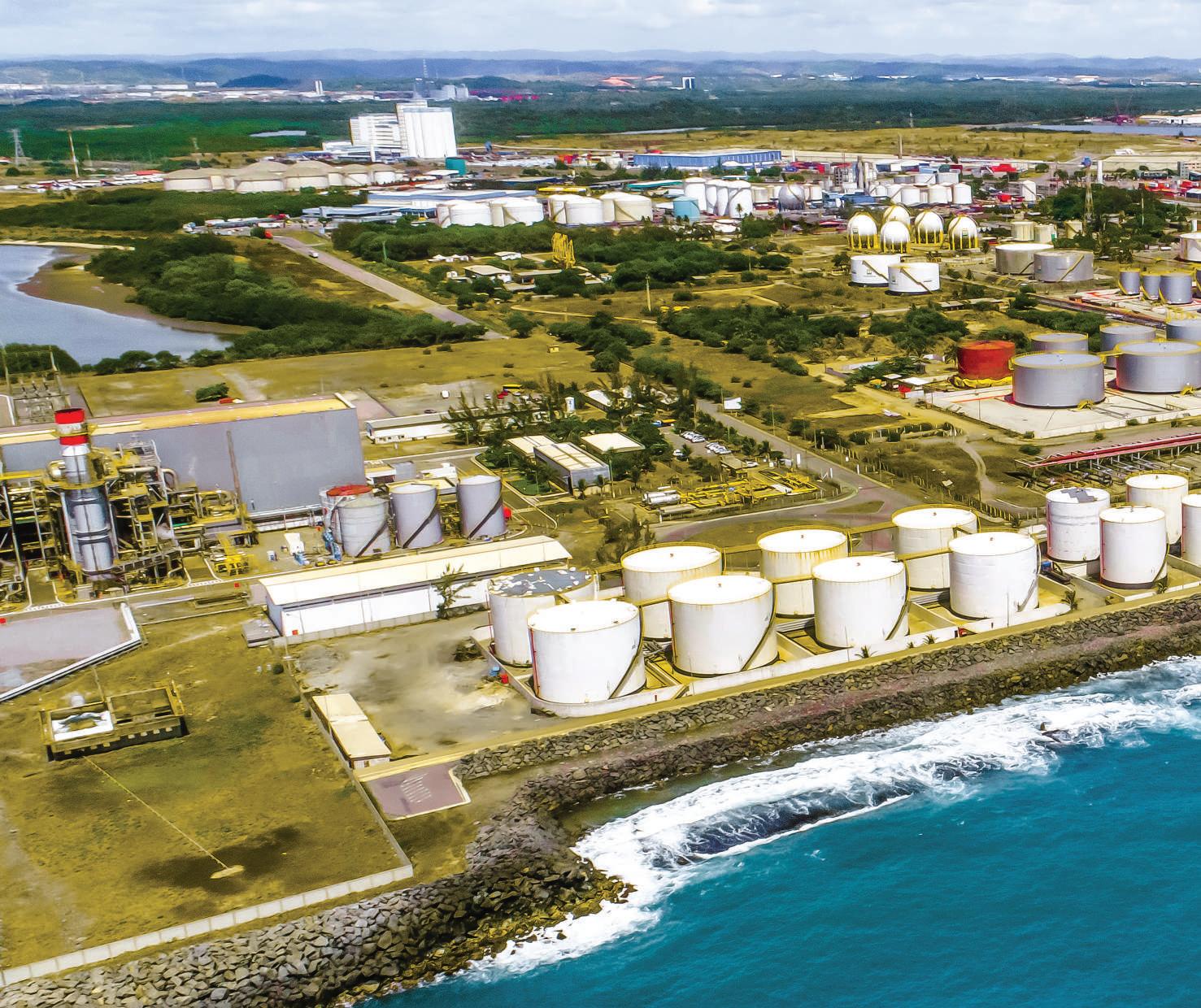
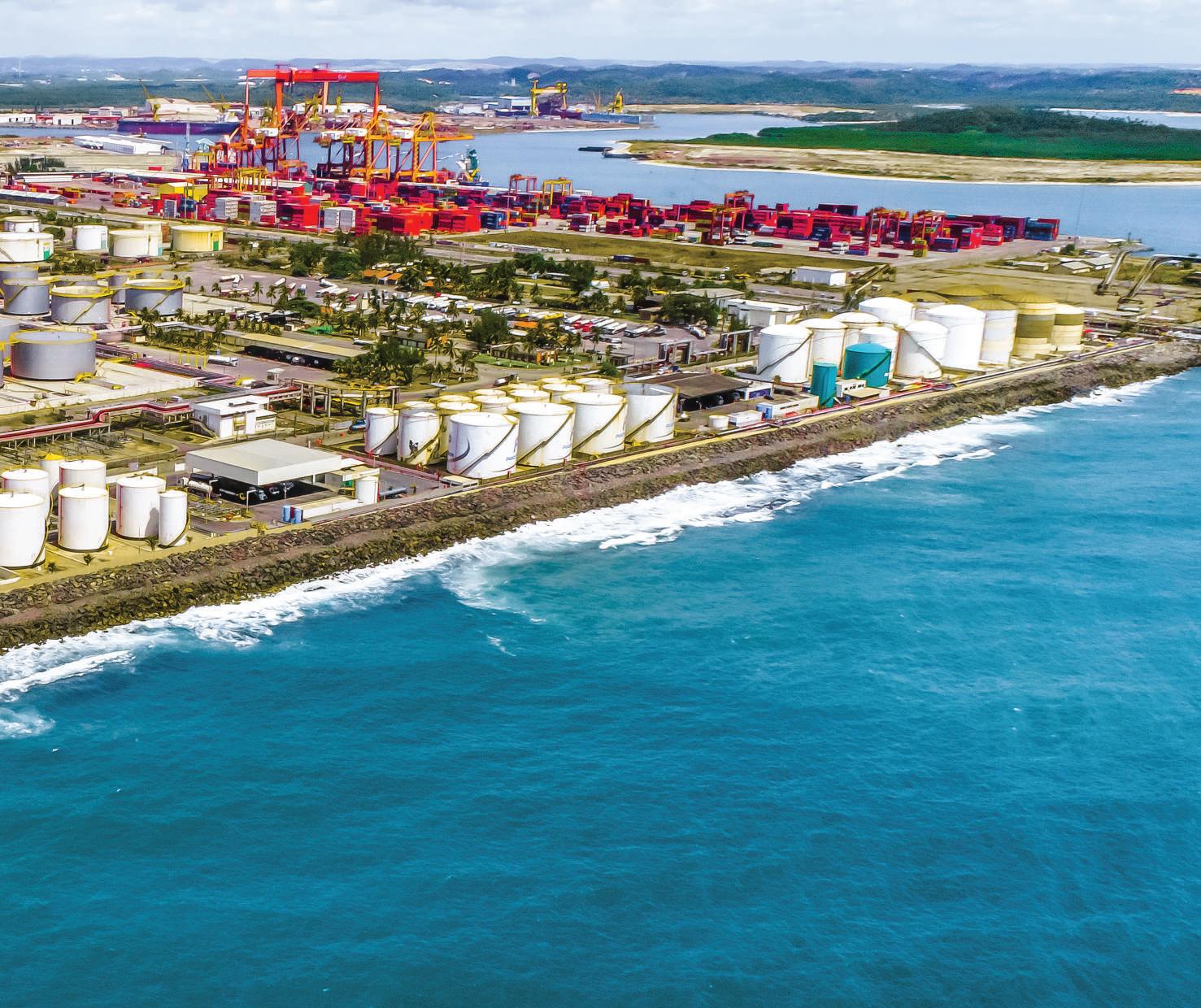
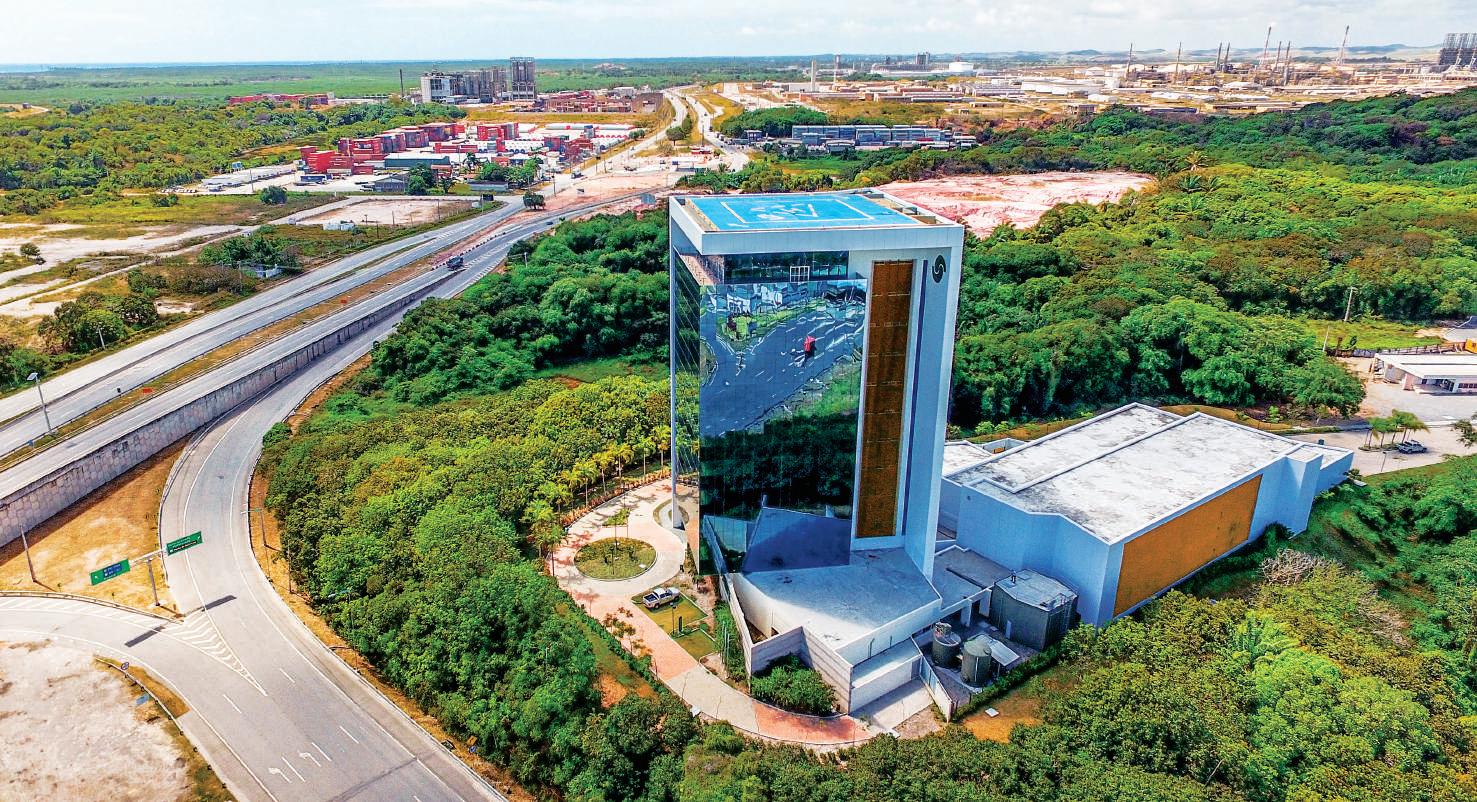
Moderno prédio com dez andares e equipado com heliporto, onde são tomadas importantes decisões que norteiam a rotina de Suape. Ambiente onde transitam investidores nacionais e internacionais interessados em trazer seus negócios para o complexo
A modern ten-floor building equipped with heliport. It is here that the important decisions that guide Suape are taken, and national and international investors interested in bringing their companies to the complex come to visit
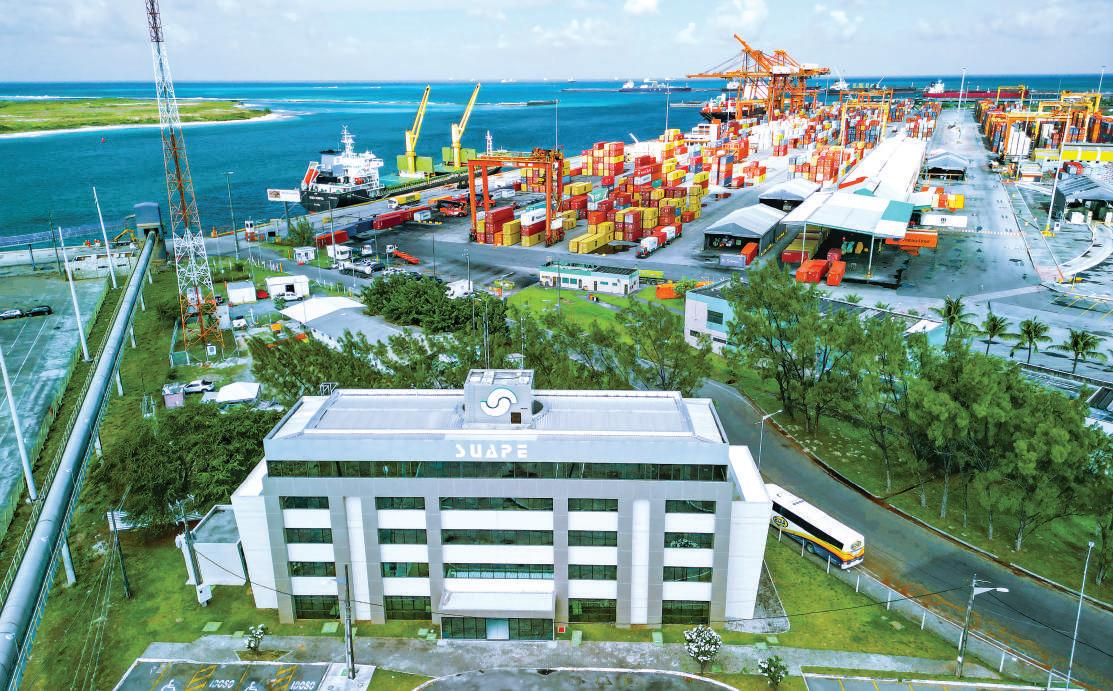
O prédio da Autoridade Portuária reúne, num mesmo local, órgãos como a Polícia Federal e a Delegacia de Imigração, reduzindo o tempo de liberação dos navios e deixando todo o processo mais rápido
The Port Authority building provides the offices of the Federal Police and Immigration Service, thereby reducing the amount of time it takes to release ships
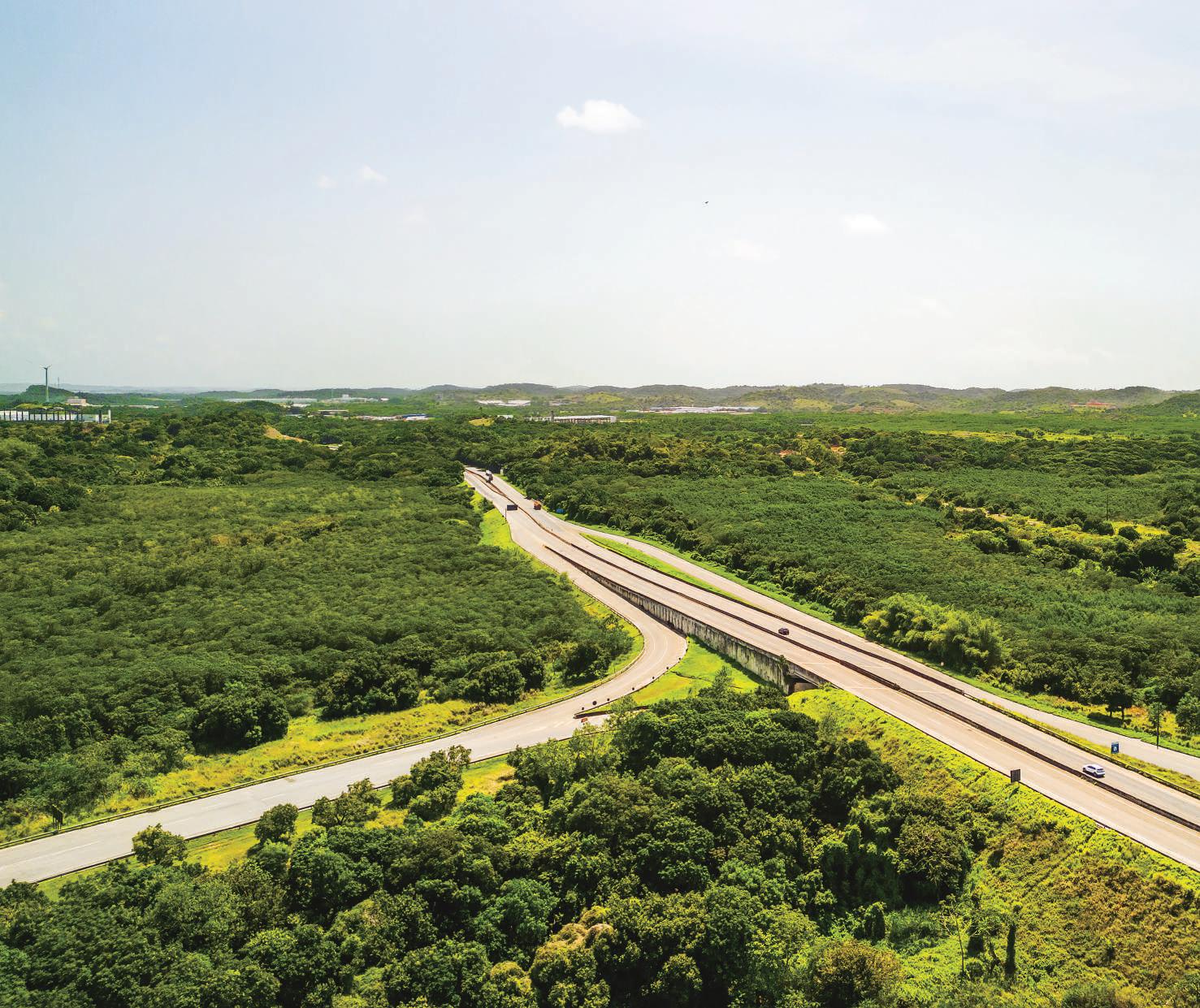

Inaugurada em 2014, a Via Expressa pedagiada tem 43 quilômetros e facilitou o acesso a Suape. Agora, quem visita as praias do Litoral Sul e faz a opção pela Rota do Atlântico pode apreciar algumas áreas do complexo e conferir de perto o ritmo do desenvolvimento daquela região com o porto-indústria
Opened in 2014, the Expressway toll road is 43 km in length and has facilitated access to Suape. People visiting the beaches on the Southern Coast and opting for the Atlantic Route can now admire some parts of the Complex and see close up the pace of development of the industrial port region


Suape tem 20 mil trabalhadores e 83 empresas. Esta é a linha de produção de uma delas, a Shineray
Suape’s 83 companies provide employment for 20,000. This is the production line of one of these companies, Shineray

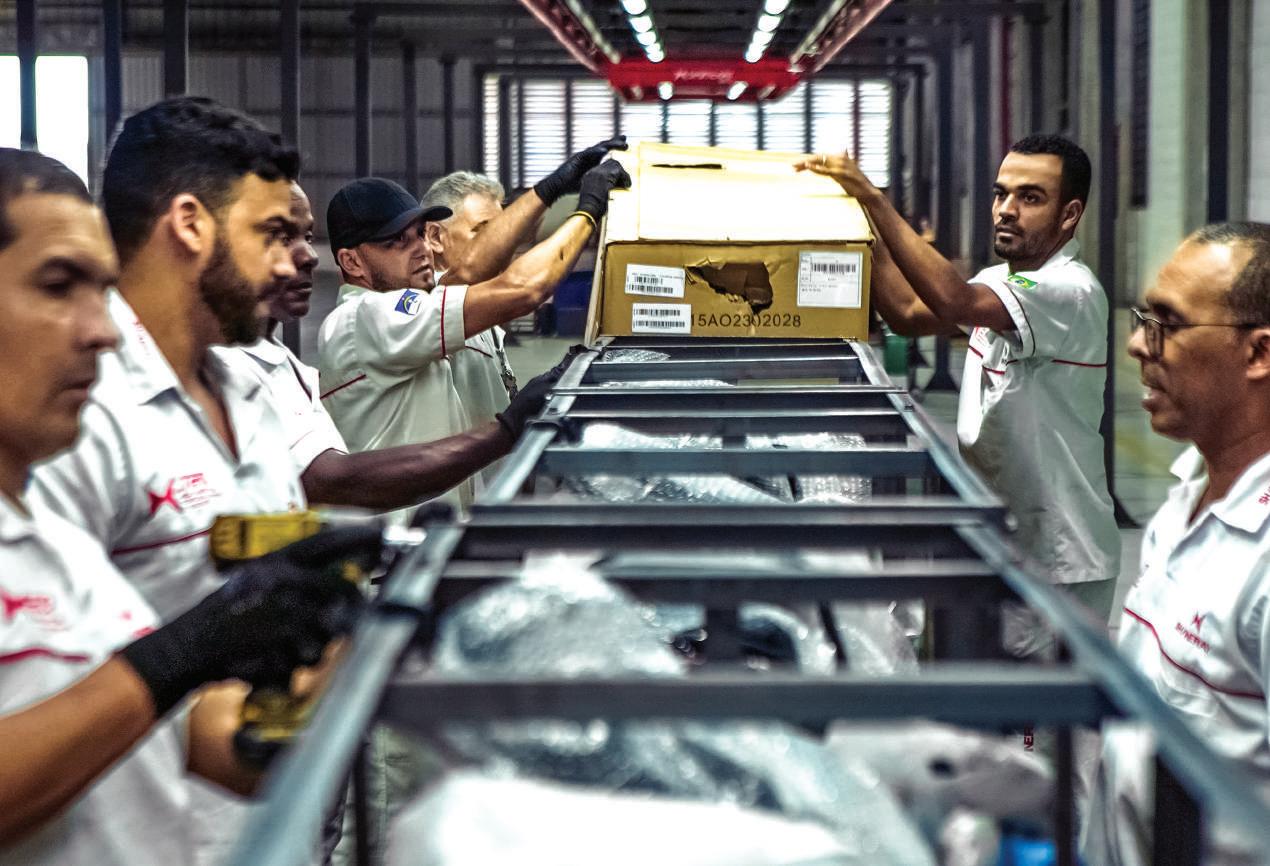
MANU PONTES
Gestora Portuária - Port Manager
Manu Pontes, moradora do Cabo de Santo Agostinho há 36 anos, nunca tinha prestado muita atenção ao imponente vizinho chamado Suape. Nem mesmo quando decidiu encarar a concorrência e participar do concurso público aberto para a empresa. Foi aprovada, em 2010, para o cargo de auxiliar administrativo, mas entrou na lista de espera.
Três anos depois, assumiu a vaga. Iniciava, ali, uma história de amor pela empresa, realização profissional e de ineditismo. Manu é a primeira mulher na história de Suape a ocupar a Supervisão de Operações Portuárias da Torre de Controle, simbolicamente conhecida como o coração do porto.
As tarefas iniciais, que foram no setor que cuidava da folha de pagamento, não desviaram a atenção dela do porto. A curiosidade era enorme.
- Eu trabalhava em Suape, mas não conhecia a rotina do porto. Comecei, então, a pleitear uma transferência para lá, mas não consegui de imediato. Inicialmente, fui para o setor de segurança portuária, até que surgiu uma vaga de controlador de tráfego marítimo na torre. Fui convidada e aceitei na hora. Foi uma sensação maravilhosa.


Manu chegou exatamente onde mais queria. A função era de plantonista, com uma rotina completamente diferente de tudo que já havia feito. Aprendeu rapidamente algo de grande responsabilidade.
- Aprendi a função com os colegas que estavam lá há mais tempo e coloquei em prática. Consegui me formar, digamos assim. Quando houve a avaliação de desempenho, tive a melhor notícia: estava pronta para uma nova responsabilidade - a liderança do plantão. Prossegui trabalhando, me desenvolvendo e tive a oportunidade de, em 2022, alcançar a supervisão, cargo que ocupo atualmente.
Antes de Manu Pontes, apenas outra mulher havia trabalhado na Torre de Controle.
- É uma honra. Um orgulho para mim e para minha família, principalmente meus pais, que tanto lutaram para que eu alcançasse o sucesso. Além, claro, da minha filha, Bianca Pontes, que, quando me identifica em algum post de Suape,
nas redes sociais, reposta imediatamente, mostra para todo mundo.
A paixão pela área portuária e a sede de conhecimento foram tantas que Manu decidiu investir num curso de logística e também foi fazer gestão portuária.
Em dez anos em Suape, assistiu a muita coisa, inclusive ao avanço da tecnologia. Depois do SuapeGEO (ferramenta que dá acesso rapidamente a uma série de informações portuárias), Manu tem certeza que o PMISsistema de gerenciamento de informações do porto desenvolvido pelo Centro de Estudos e Sistemas Avançados do Recife (CESAR) - vai colocar Suape na ponta da linha da inovação. E ela, claro, quer tirar o melhor proveito da plataforma para contribuir cada vez mais com o sucesso da empresa.
- Fazer parte do time Suape é de um orgulho sem tamanho. Tem sido um presente divino para minha vida.
Manu Pontes, who has lived in Cabo de Santo Agostinho for 36 years, never paid much attention to the imposing neighbor called Suape. Not even when she decided face the stiff competition and apply for a job there. She was hired in 2010 as an administrative assistant but remained on the waiting list.
Three years later, she took up the post. Thus began a long love affair with the company, involving professional development and unprecedented accomplishments. Manu is the first woman in the
history of Suape to occupy the post of Supervisor of Port Operations at the Control Tower, symbolically known as the heart of the port.
Her first job, in the payroll sector, did not stop her from being curious about the port as a whole.
- I worked in Suape, but I did not know anything about the everyday working of the port. Then I started asking for a transfer, but I didn’t get it straight away. First, I went to the port security

sector, until a vacancy appeared for maritime traffic controller in the tower. I was offered the job and accepted almost immediately. It was wonderful.
Manu got the job she had always wanted. She worked on call, with a routine completely different from anything she had done before. She learnt quickly to do something that required great responsibility.
- I learnt from colleagues who had been there longer and put
what I learned into practice. I did my training, let’s put it that way. When there was a performance evaluation, I received the highest grade. I was ready to take on a new responsibility: managing the shift. I continued working and developing my skills and, in 2022, I got the opportunity to become a supervisor. This is the job I am still doing today.
Before Manu Pontes, only one woman had worked in the Control Tower.
- It´s a great honor. I am proud of myself and for my family, especially my parents, who struggled so hard for me to be successful. And also, of course, my daughter, Bianca Pontes, who, when she sees me on a Suape post on social media, replies immediately and shows it to everybody.
Manu’s passion for working at the port and thirst for knowledge were such that she decided to take courses in logistics and port management.
During her ten years at Suape, she has seen a lot, including advances in technology. After the introduction of SuapeGEO (a tool providing rapid access to a whole range of information about the port), Manu is certain that PMIS – a port information management system developed by the Recife Center for Advanced Studies and Systems (CESAR) – will put Suape on the cutting edge of innovation. She, of course, wants to make the most of the platform so that she can do even more to help the company succeed.
- I am so proud to be a part of the Suape team. It has been a gift from God in my life.
ALEXANDRE REIS
Economista - Economist
Tanto no passado quanto agora, o crescimento de Suape transita por sua capacidade de ser um imponente indutor para investimentos públicos e privados no estado. Nos últimos dez anos, a missão de divulgar essas potencialidades, atrair novos negócios, receber e conquistar investidores passa diretamente pela mesa de trabalho de Alexandre Reis, coordenador de Desenvolvimento de Negócios do porto-indústria.
Alexandre atua na conversa direta com investidores do Brasil e do mundo. Em termos comparativos, é como se ele fosse um afiado vendedor. Na hora de apresentar o produto, mostra como Suape é um porto diferenciado na região, expõe as condições logísticas, seu enorme território para implantação de indústrias, incentivos fiscais oferecidos pelo Estado e, entre outros atrativos, o comprometimento com o meio ambiente.
Incorporado ao quadro funcional de Suape em 2013, por meio de concurso público, Alexandre teve antes uma vida profissional voltada para a iniciativa privada. Economista de formação, acumulou vasta experiência no setor varejista e de infraestrutura. Trajetória que lhe garantiu importante expertise para tocar a nova função em Suape.
Durante essa década de atuação no complexo, ele se or-
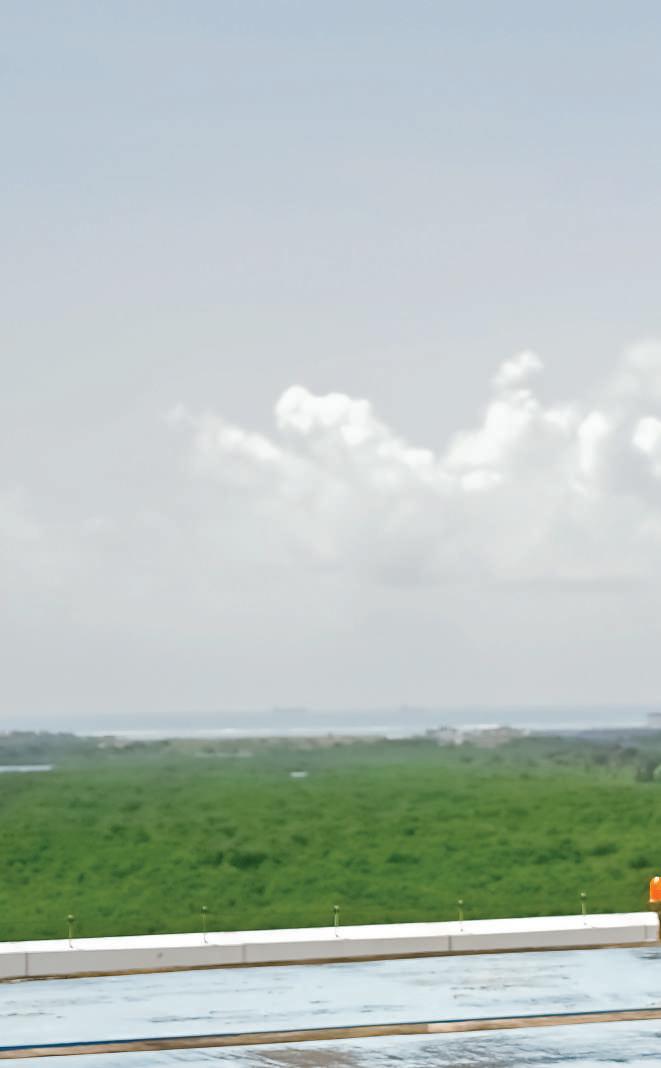
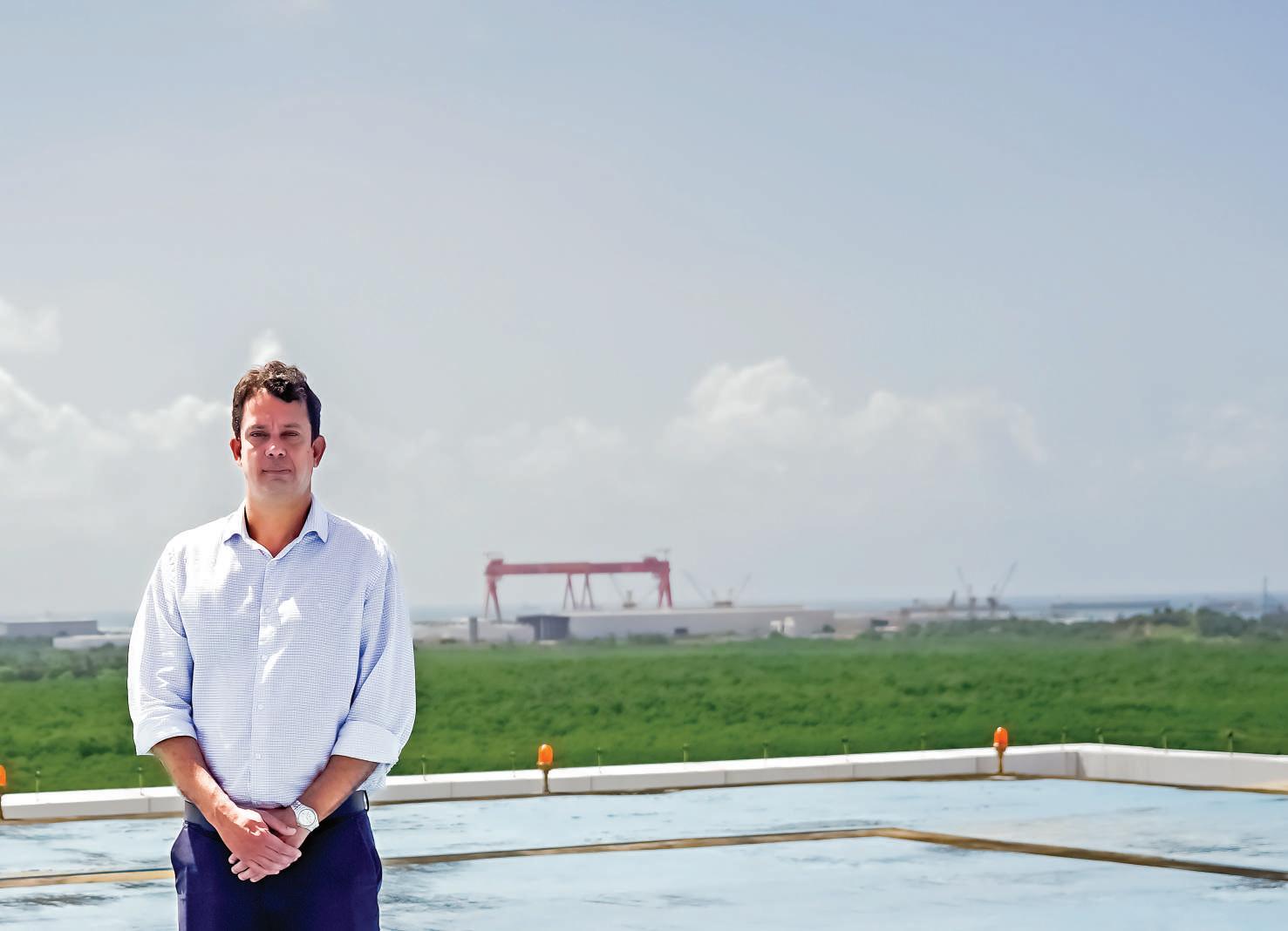
Estamos vendo todo um cenário que vem mudando, cada vez mais, no sentido de oportunidades, formação e investimentos para Pernambuco e para o Brasil, por meio de Suape.”
gulha dos investimentos que ajudou a trazer para Suape e para Pernambuco.
- Tivemos muitos avanços na última década, mas precisamos fazer um trabalho mais forte, porque ainda há muita margem para crescimento em Suape. Estamos falando de indústrias que terão acesso a um equipamento muito diferenciado como é o Porto de Suape, que pode tanto receber seus insumos de fora como também levar seus bens produzidos para outros países. Podemos dizer que, de certa forma, isso é uma espécie de grife para essas indústrias.
Dentro dos potenciais alavancadores de investimentos, ele destaca um novo terminal de contêineres privado, a futura conclusão do segundo trem da Refinaria Abreu e Lima, a instalação de um terminal de regaseificação, a própria expansão do porto, além da chegada de uma nova malha ferroviária e vários outros pontos previstos no Plano Diretor Suape 2035.
O complexo abriga 83 empresas plurais em suas produções e serviços. E um de seus grandes potenciais para uma expansão é o portfólio ambiental e sua capacidade de empreender com desenvolvimento sustentável. Alexandre aponta que Suape dispõe de um ativo ambiental superavitário, com um cenário natural que reúne condições de preservação e produção de energia limpa.
- Não é da boca para fora quando digo que nosso trabalho aqui melhora a vida das pessoas. É algo que me faz sentir muito gratificado, pois, desde meu começo, enquanto estudante, eu optei pela economia como um meio de entender o mundo e melhorar a vida das pessoas. Estamos vendo todo um cenário que vem mudando, cada vez mais, no sentido de oportunidades, formação e investimentos para Pernambuco e para o Brasil, por meio de Suape.
Both in the past and now, the growth of Suape has been driven by its enormous capacity to attract public and private investment to the State. In the last ten years, the mission of promoting this potential, attracting new business, and gaining investment has been the direct responsibility of Alexandre Reis, coordinator of Business Development at the industrial port.
Alexandre works directly with investors from Brazil and overseas. He operates like a skilled salesperson. When presenting the product, he shows how Suape is a different kind of port, explains the logistics, the vast area available for the installation of new businesses, the tax incentives offered by the State government and other attractive features, including a commitment to the natural environment.
Hired by Suape in 2013, by way of public selection, Alexandre previously worked in the private sector. Trained as an economist, he amassed vast experience in the retail and infrastructure sectors. This enabled him to bring vital expertise to his new position at Suape.
During his ten years working at the Complex, he is proud of the investment he has helped to bring to Suape and to Pernambuco.
- We have seen much progress in the past ten years, but we need to work harder, because there is still a lot of scope for growth in Suape. We are talking about industries that will have access to the very special port facility that we have at Suape, which can receive goods from abroad and also export goods produced here to other countries. We could say that this is a kind of brand label for the businesses that set up here.
Among factors with the potential to leverage investment, he includes a new private container terminal, the future completion of the second Abreu e Lima Refinery train, the installation of a regasification terminal,
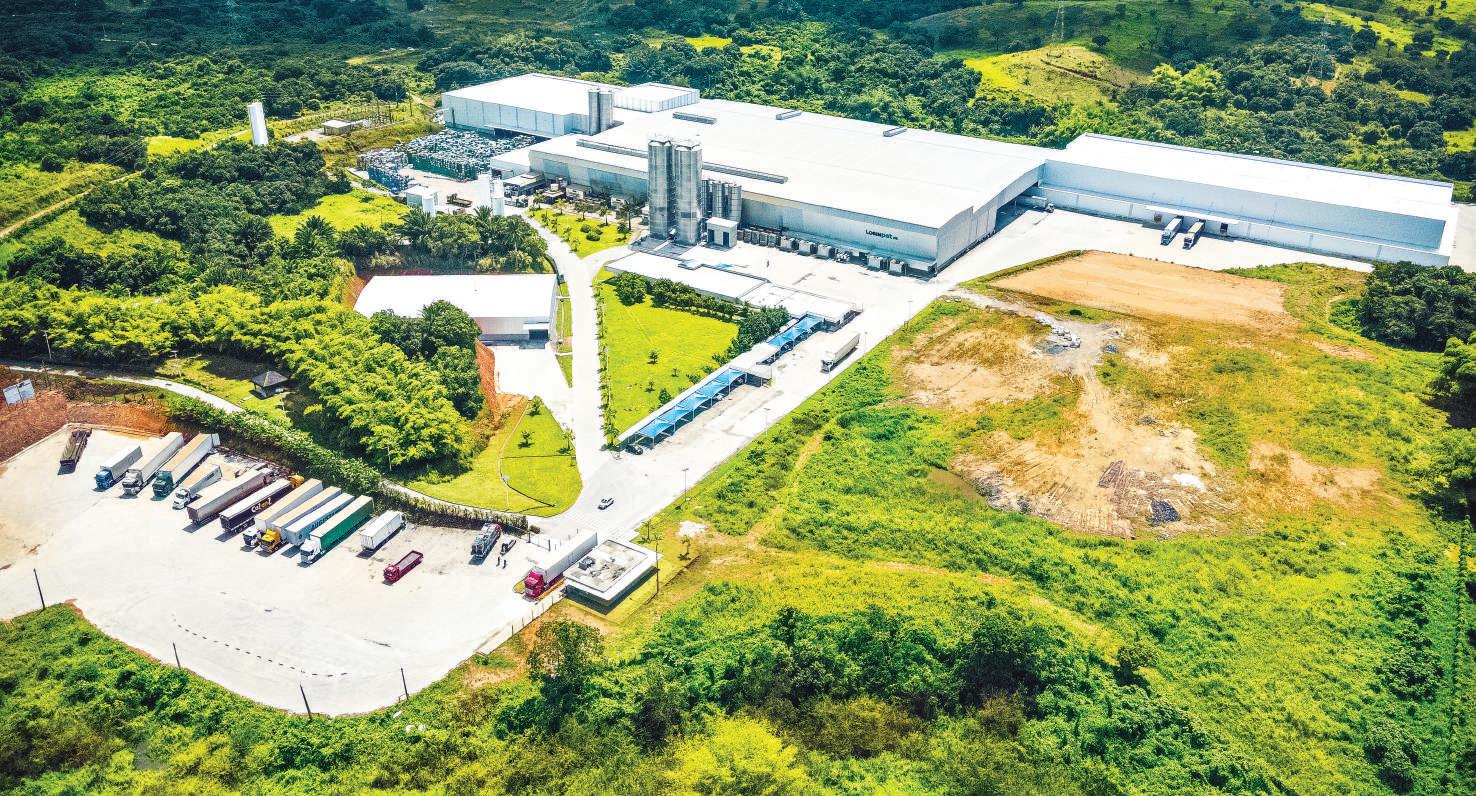
the expansion of the port itself, the arrival of a new railroad network, and various other plans laid out in Suape’s 2035 Master Plan.
The complex is home to 83 companies providing a wide range of products and services. One feature that gives it great potential for expansion is its environmental portfolio and its potential to undertake sustainable development. Alexandre notes that Suape has an environmental surplus, with a natural setting that combines the conditions needed for both preservation of the environment and
the production of clean energy.
- I really mean it when I say that our work here improves people’s lives. It is something of which I am very proud, because, since I started out, as a student, I chose to study Economics, because it is a way of understanding the world and improving people’s lives. We can see that the whole world is changing at an increasingly rapid pace, in terms of the opportunities, training and investment that Suape can provide Pernambuco and Brazil as a whole.
JOSÉ SIMPLÍCIO
Agente Operacional - Operational Agent
“Suape é progresso”
José Simplício saiu de Lajedo, no Agreste pernambucano, aos 21 anos, para trabalhar no Complexo Industrial Portuário de Suape. Um mundo totalmente desconhecido para ele nos idos de 1982. A expectativa era ser contratado como motorista, mas os planos não saíram exatamente como ele esperava. O primeiro cargo foi o de vigilante. Acabou chegando ao estratégico setor de tráfego do porto, onde já exerceu a função de supervisor. Tomando a própria experiência como referência, faz uma avaliação bem particular do lugar que escolheu para construir a trajetória profissional.
- Suape não é uma simples empresa. É uma grande universidade. Vejo muitos estagiários. Suape ensina, leva conhecimento para muita gente e abre oportunidades.
Ao longo de quatro décadas, Simplício passou por várias funções. Depois de cinco anos na vigilância - em uma Suape bem diferente -, trabalhou no almoxarifado. Foi chefe da divisão de serviços auxiliares e também da área de transportes,


“
Vejo muito crescimento de Pernambuco, do Nordeste, da região.”
mas se encontrou mesmo no setor portuário. Uma das funções que ocupou foi a de coordenador executivo de operações.
- Comecei no porto como auxiliar na recepção e expedição de contêineres no pátio público de contêineres de Suape. Isso foi antes da chegada do Tecon, terminal privado que assumiu as operações.
Simplício testemunhou, ano após ano, a transformação de Suape em muitas etapas. Alguns momentos, em especial, ficaram marcados como símbolos da consolidação do porto-indústria. O início das obras da refinaria, em 2005, é algo especial.
- Pernambuco esperava por isso há muito tempo. Foram várias campanhas. A refinaria chegou e foi um boom. Suape cresceu muito mais rápido depois dela, atraiu muitas empresas. Foi um marco importantíssimo.
Desde aquele já longínquo ano de 1982, quando chegou em Suape, a perspectiva de Simplício em relação ao porto-indústria mudou radicalmente. Antes, ele não fazia ideia do que era o empreendimento. Não tinha a dimensão do tamanho. Agora, o sentimento é outro. É de orgulho, de dever cumprido.
- Vejo muito crescimento de Pernambuco, do Nordeste, da região. Suape não tem volta. Suape é progresso.
“Suape means progress”
José Simplício left home in Lajedo, in the Agreste region of Pernambuco, at 21 years of age, to start work at the Suape Port and Industrial Complex. In 1982, it was a world that was totally new to him. He was expecting to work as a driver, but things did not go exactly according to plan. His first job was as a security guard. He then moved to the strategic port traffic sector, working sometimes as a supervisor. He provides here, based on his own experience, a very personal evaluation of the place he has chosen for the development of his professional career.
- Suape is not just a company. It is a huge university. I see many interns. Suape teaches. It provides many people with knowledge and opens up opportunities.
Over four decades, Simplício has held various positions. After five years working as a security guard – in an already much changed Suape – he started work in the warehouse. He was made head of the auxiliary services division and also of transport, but he found his true vocation in the port sector. One of the posts he has occupied is executive coordinator of operations.
- I began work at the port as an assistant, receiving and dispatching containers in Suape’s public container yard. This was before the opening of the private terminal Tecon, which took over these operations.
Simplício has witnessed the many transformations that Suape has been through in various stages, year after year. Some moments, in particular, are remembered as being particularly symbolic of the consolidation of the industrial port complex. When work began on the refinery, in 2005,

this was something special.
- Pernambuco had been waiting for this for a long time. There were various campaigns. The refinery arrived and there was a boom. Suape grew much faster after that. It attracted a lot of companies. It was a very important development.
Since that time long ago, when he arrived in Suape in 1982, Sim-
plício’s view of the port and industrial complex has changed radically. Before that time, he had no idea what Suape was. No idea of how big it was. Now it is different. He is proud and feels he has done his duty.
- I see a lot of growth in Pernambuco, the Northeast, the whole region. There is no going back for Suape. Suape means progress.
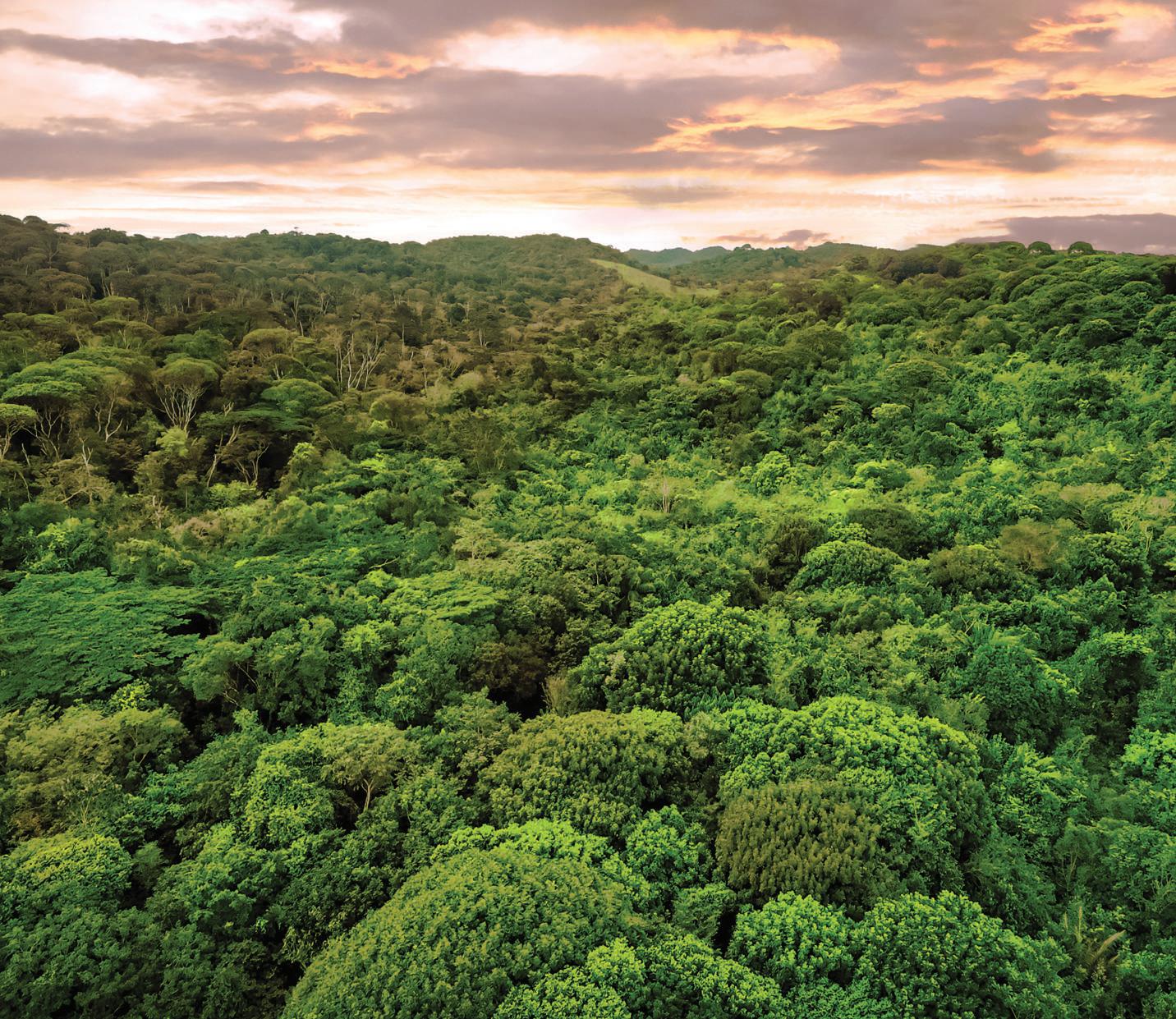

Innovation and sustainability

Sustentabilidade e inovação. Quantos significados cabem nessas duas palavras? Em Suape, elas traduzem boas práticas de muitas formas. Transitam intensamente por uma gestão guiada pela Agenda ESG, sigla em inglês que simboliza uma política focada no meio ambiente, na responsabilidade social e na moderna governança. Depois de quatro décadas e meia de existência, Suape investe nesse caminho para crescer e se desenvolver, alinhado às melhores iniciativas corporativas mundiais.
As ações proliferam em todas as áreas do Complexo Industrial Portuário e em várias direções. Seja na preocupação de colaborar com a descarbonização, em dar passos para o futuro com a transição energética, preservar o capital ambiental ou criando condições para partilhar desenvolvimento com as comunidades que existem no seu vasto território.
Suape também faz movimentos estratégicos para agregar aliados e ter ao seu lado instituições que partilhem objetivos semelhantes, focando em um futuro melhor para Pernambuco, para o Nordeste e para o país. Foi assim que lançou, em setembro de 2023, uma iniciativa batizada de Open Innovation.
Do que se trata e onde Suape quer chegar com isso? É um modelo de gestão que acelera a inovação nas empresas do complexo por meio de parcerias com outras corporações, universidades e com Instituições Científicas e de Inovação Tecnológica (ICTs). A expectativa é promover a troca de ex-
periências, criando um ambiente que incentive a criatividade e fomente a cadeia produtiva com o que há de mais moderno no mercado.
Mesmo antes disso, outros projetos surgiram na vanguarda. É o caso do SuapeGEO. A premiada plataforma de geoprocessamento foi desenvolvida pelos profissionais de tecnologia da estatal, em parceria com uma empresa privada. Ela aponta soluções para praticamente todas as áreas e dá suporte nas operações portuárias, na segurança patrimonial e nos projetos socioambientais. Também foi lançado um aplicativo para que qualquer cidadão tenha acesso ao que acontece no complexo.
Se é bom, pode ficar ainda melhor. Um convênio com o Centro de Estudos e Sistemas Avançados do Recife (CESAR) foi celebrado para impulsionar estratégias no universo digital. E assim nasceu o Port Management Information System (PMIS). Dividido em cinco módulos, o gerenciador compila uma série de informações em tempo real, como a movimentação de navios e a hora que estão chegando. Também é uma ferramenta para gerenciamento de faturamento e armazenagem, já integrada ao programa Porto Sem Papel, do governo federal.
O sistema unifica toda a comunicação do porto, deixa para trás resquícios do mundo analógico, além de projetar o complexo para um modelo semelhante ao adotado nos portos da Europa. O futuro já está presente em Suape.
Sustainability and innovation. How many ideas do these two words conjure up? At Suape, they involve many kinds of good practices, and these have a lot to do with a form of management guided by the ESG Agenda, focusing on the environment, social responsibility and modern governance. After four and a half decades of existence, Suape is investing in this path towards growth and development, in line with the best corporate practices worldwide.
Such actions are proliferating in all areas of the Suape Port and Industrial Complex and are moving in various directions. These include a concern to work towards decarbonization, taking steps towards a future energy transition, preserving environmental capital, and creating the conditions to share development with the communities with which the complex coexists in the vast territory it occupies.
Suape also has a strategy of putting together a group of allies and bring on board institutions that have similar objectives, in search of a better future for Pernambuco, the Northeast region, and Brazil as a whole. This led, in September 2023, to the launch of an initiative called Open Innovation.
What does this mean and where is Suape expecting to go with it? This management model is designed to accelerate innovation at the companies in the complex by partnering with other corporations, universities and institutions committed to scientific and technical innovation. The aim is to provide an exchange of experiences,
creating an environment that promotes creativity and furnishes the chain of production with the most up-to-date features available on the market.
Other projects have gone before this one. One was SuapeGEO, an award-winning geoprocessing platform developed by public sector technical experts in partnership with a private company. This project provides solutions for practically all fields and offers support for port operations, asset security and social and environmental programs. An application has also been launched to enable every citizen to access information about the complex.
This is great but we can do even better. A partnership with the Recife Center for Advanced Studies and Systems (CESAR) has been formed to develop digital technology strategies and has already led to the production of the Port Management Information System (PMIS). Divided into five modules, this data manager compiles a series of real-time data, including ship movements and arrival times. The tool can also be used for management of revenue and storage and has already been incorporated into the Federal Government’s Paperless Port program.
The system brings together all port communications in a single location, leaving behind all relics of the analog world and aims to adapt the complex to the model adopted by ports in Europe. At Suape, the future has already arrived.


Conhecida como o coração do porto, a Torre de Controle também é um símbolo da eficiência e da transformação digital de Suape
Known as the heart of the port, the Control Tower also testifies to the efficiency and digital transformation of Suape
A biodiversidade na área do complexo é ampla. Suape preserva e estuda diariamente a fauna terrestre e marinha do território, com atenção à necessidade de ações e de cuidados com os habitats presentes. Boas práticas voltadas para o ambiente aquaviário, por exemplo, resultaram no Painel Digital da Vida Marinha e Estuarina, com dados de 369 espécies. Você pode ver nas imagens a seguir: iguana, lagarto, cavalos-marinhos e coruja
There is great biodiversity in the area covered by the Complex. Suape works daily to preserve and study terrestrial and marine fauna, paying special attention to the need to take care of existing habitats. Good practices relating to the aquatic environment have resulted, for example, in the production of a Digital Display of Marine and Estuarine Life, containing data on 369 species. You can see in the following images iguana, lizard, seahorses, and owl
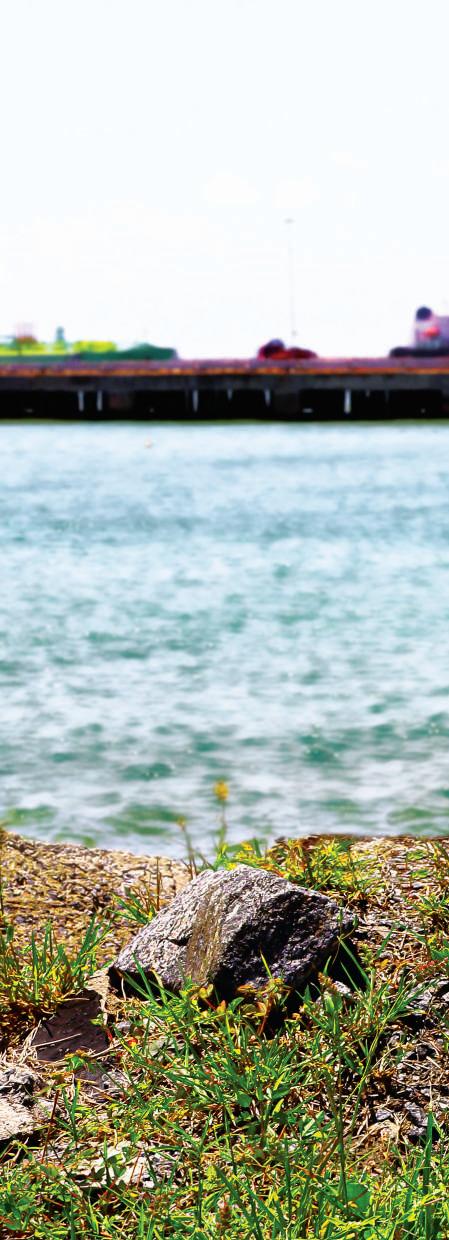
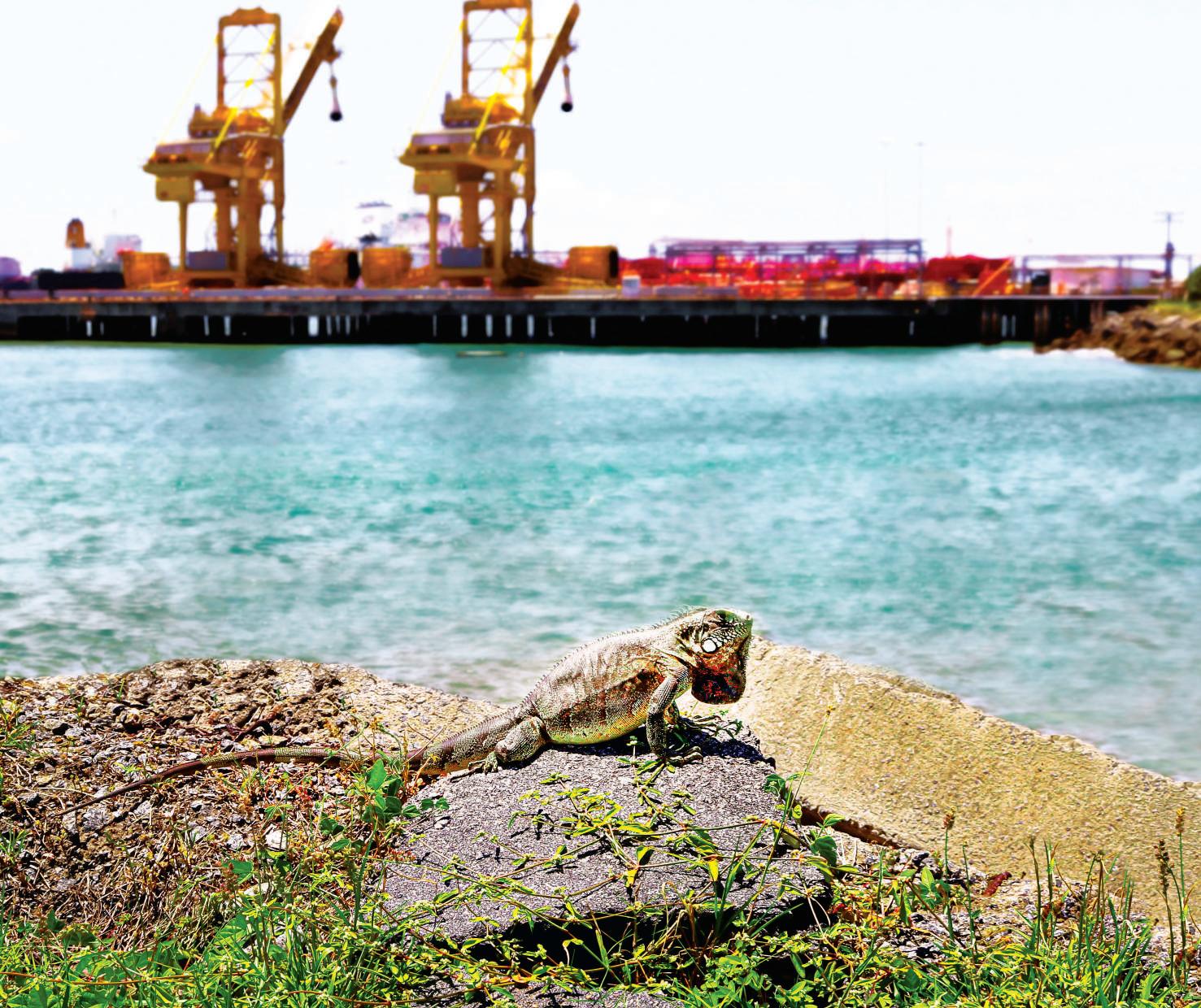

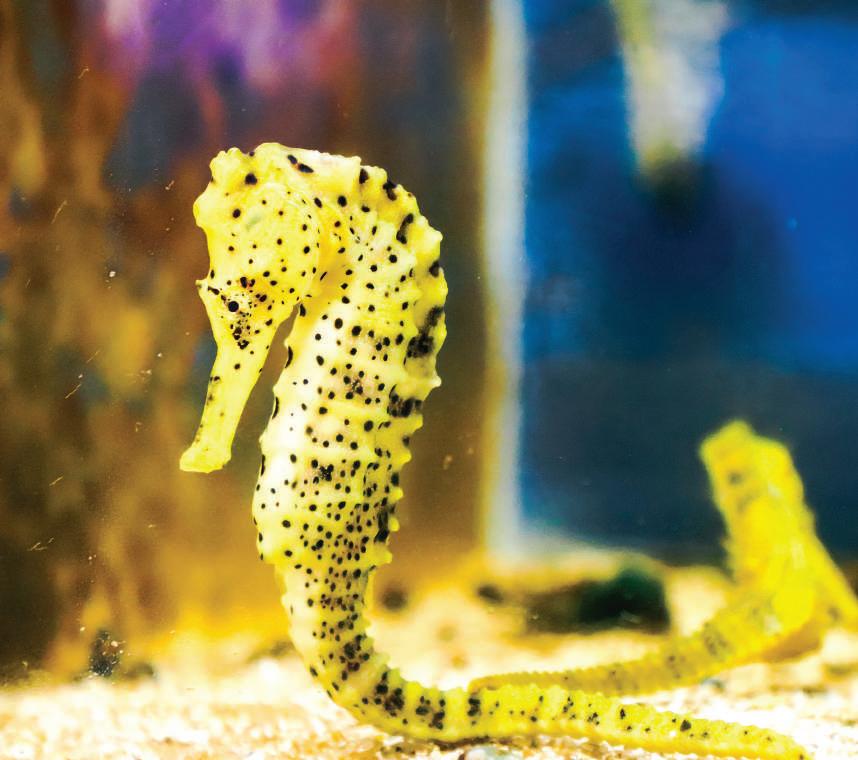


O viveiro florestal de Suape tem capacidade para produzir anualmente mais de 450 mil mudas de 80 espécies nativas da Mata Atlântica
Suape’s tree nursery has the capacity to produce 450,000 saplings annually, covering 80 local species of Atlantic Forest vegetation
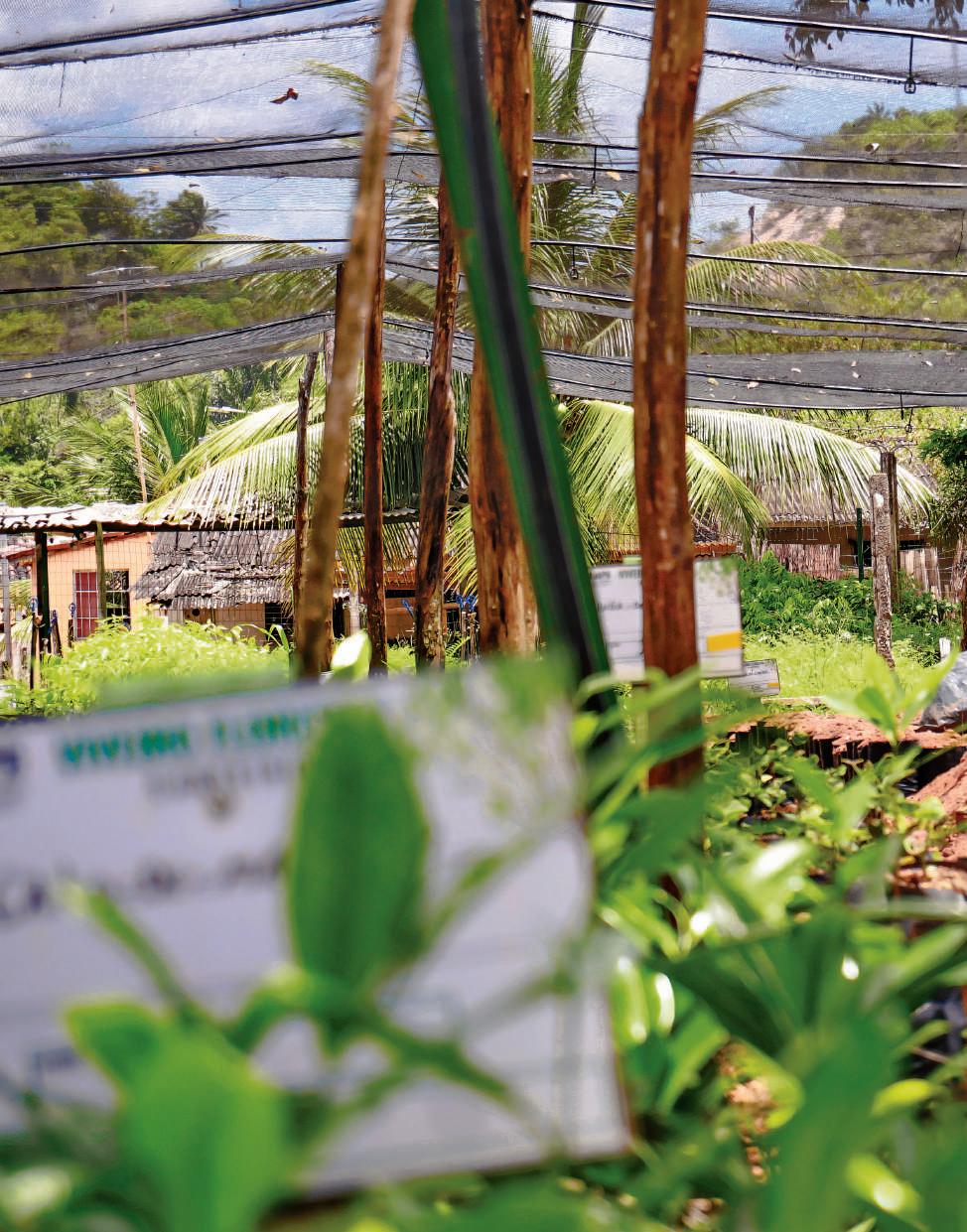

Uma das formas de compensação ambiental em Suape é alimentada por um grande viveiro florestal, que tem capacidade para produzir, todos os anos, mais de 450 mil mudas de mais de 80 espécies nativas da Mata Atlântica. Um importantíssimo ativo que ganha cores, formas e vida com aroeiras, sucupiras, mutambas, visgueiros, maçarandubas. Tem espaço até para o belo e emblemático pau-brasil. O reflorestamento já assegurou a preservação de 8 mil hectares de Mata Atlântica, com o plantio de 3 milhões de mudas.
O viveiro existe desde 1995 e está localizado às margens da Rodovia PE-60, no município do Cabo de Santo Agostinho, em uma área de quase 20 mil metros quadrados. Desde que surgiu, transformou-se em uma engrenagem indispensável aos projetos socioambientais, colaborando para a preservação dos biomas no vasto território de Suape. Dos 17,3 mil hectares do complexo, 59% estão inseridos na Zona de Preservação Ecológica (ZPEC).
Nesse processo de cuidar do reflorestamento, Suape conta com o fundamental apoio de pessoas das comunidades locais, como os moradores de Algodoais e de Massangana. Muitos nativos são profundos conhecedores da mata e ajudam no precioso trabalho de encontrar sementes das espécies selecionadas.
Uma vez com as sementes em mãos, uma cooperativa contratada por Suape inicia todo o ciclo de produção. Antes de serem lançadas à terra para brotar e crescer, passam por algumas etapas, como beneficiamento, germinação, ensacamento e rustificação (retirada gradual de cobertas). As áreas de reflorestamento são selecionadas pela Diretoria de Sustentabilidade. Algumas espécies levam até um ano para que fiquem no ponto exato para o plantio. Para outras, como a aroeira e a mutamba, o processo é mais rápido: leva cerca de três meses. Seja exigindo mais ou menos tempo, o importante é plantar, reflorestar e assistir, diariamente, a natureza se renovando.
One way in which Suape promotes environmental compensation is through its huge forest nursery, which has the capacity to produce, on an annual basis, over 450,000 saplings of more than 80 species native to the Atlantic Forest. This is an extremely important and highly visible asset, with its lively colorful pepper trees, Pteridons, bay cedars, Parkia, and bulletwood. There is even room for some examples of Brazil’s iconic pau-brasil tree. Reforestation has already secured the preservation of 8,000 hectares of Atlantic Forest, through the planting of 3 million saplings.
The nursery has been in existence since 1995 and is located along the PE-60 highway, in the Municipality of Cabo de Santo Agostinho, covering an area of two hectares. Since then, it has become an indispensable component of social and environmental projects, helping to preserve the biome of Suape’s vast territory. Fifty-nine percent of the 17,300 hectares of the Complex lies within the Ecological Preservation Zone (ZPEC).
Fundamental to the success of Suape’s reforestation activities is the support of the residents of local communities, such as Algodoais and Massangana. Many local people have in-depth knowledge of the forest, and their help is indispensable in finding seeds for selected species.
Once the seeds have been acquired, a cooperative hired bySuape begins the cycle of production. Before being planted out, the seeds go through various procedures, including pre-processing, germination, bagging, andrustication (the gradual removal of coverings). Areas for reforestation are selected by the Sustainability Department.
Some species take up to a year to be ready for planting. For others, such as pepper trees and bay cedar, the process takes only around three months. However long it takes, it is vital that reforestation be carried out and that nature be allowed to renew itself on a daily basis.

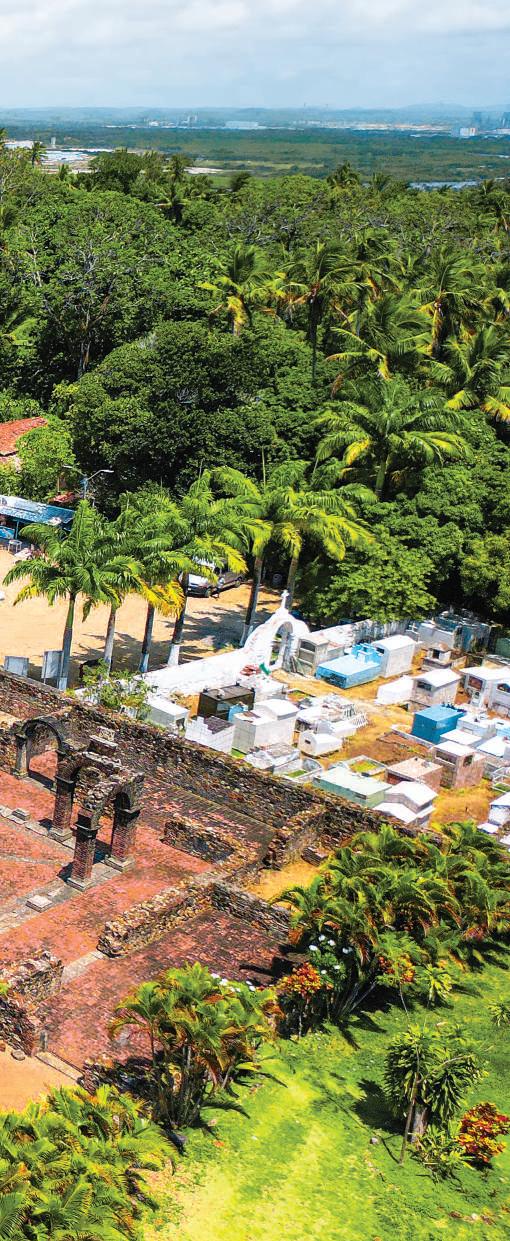
Monumentos históricos e culturais estão inseridos na Zona de Proteção de Suape. No Parque Metropolitano Armando Holanda Cavalcanti, está localizado um conjunto histórico do século 16, conhecido como Vila de Nazaré. Já o Engenho Massangana abriga a casa onde morou na infância o ilustre pernambucano Joaquim Nabuco, um dos fundadores da Academia Brasileira de Letras
Some monuments of historical and cultural significance are located within the Suape Protection Zone. The Armando Holanda Cavalcanti Metropolitan Park contains an historical ensemble known as Vila de Nazaré that dates back to the 16th century. The Massangana Plantation is the location of the house that was once home to the illustrious Pernambuco abolitionist Joaquim Nabuco, one of the founders of the Brazilian Academy of Letters


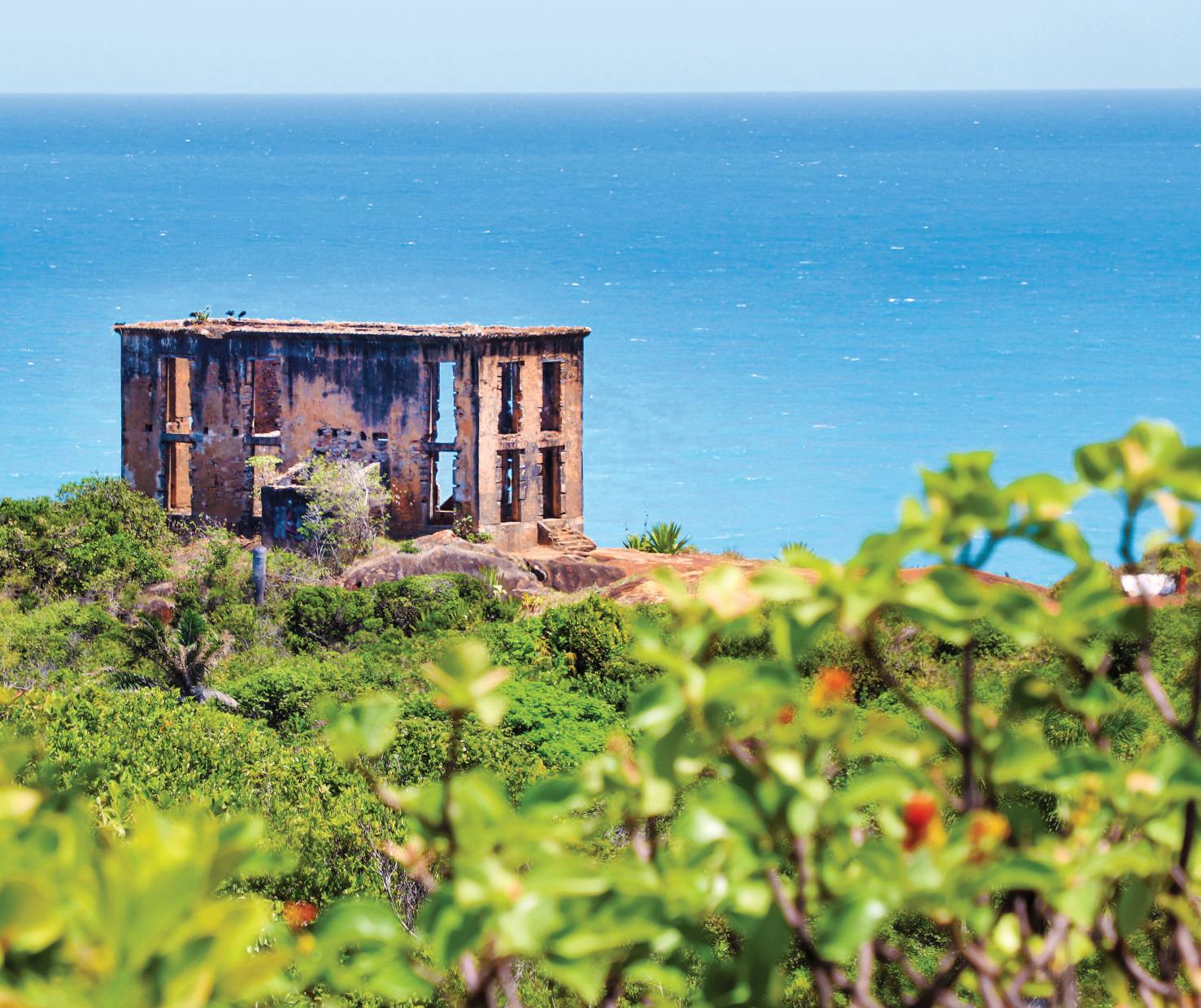
O número de pessoas que vivem no território de Suape cresceu cerca de 70% nos últimos 12 anos. Passou de 10 mil para 17 mil. População maior do que a de muitos municípios pernambucanos, como Itaquitinga, Lagoa dos Gatos e Triunfo. O cenário foi revelado no Plano Diretor 2035, mas o que poderia ser traduzido em frias estatísticas deflagrou um projeto inovador: o Sistema Agroflorestal.
A iniciativa inaugura um novo momento na relação entre Suape e as comunidades. Isso porque permite que moradores da Zona de Preservação Ecológica (ZPEC), em vez de serem instados a deixar a área onde fixaram residência, fiquem onde estão. E mais: recebam capacitação para desenvolver agricultura orgânica sem agressão ao bioma.
Movimentos iguais a esse - que promovem a união entre o modelo produtivo das comunidades e a natureza - já foram deflagrados com sucesso em outras localidades do país. Em
Suape, após levantamento criterioso nas comunidades, vai funcionar assim: cada agricultor ou agricultora terá uma área para desenvolver o Sistema Agroflorestal. A partir do momento em que a produção saudável proliferar, será acionado um círculo virtuoso.
Com a mediação de Suape, as comunidades vão passar a fomentar o mercado de alimentos sem agrotóxicos junto às empresas do complexo. Essas, por sua vez, já formam uma rede de potenciais clientes. Para se ter uma ideia da demanda, apenas a Refinaria Abreu e Lima oferece 2,5 mil refeições aos funcionários três vezes ao dia.
Por que, então, não comprar bananas, hortaliças e tantos outros produtos fresquinhos de uma fonte conhecida e ecologicamente correta? Sem contar que as empresas vão ajudar a promover o desenvolvimento socioeconômico das comunidades e a fortalecer a simpática e necessária política da boa vizinhança.
The number of people living in the Suape area has grown about 70% in the past 12 years, from 10,000 to 17,000 inhabitants. This is a population larger than that of small municipalities in the State of Pernambuco such as Itaquitinga, Lagoa dos Gatos or Triunfo. This was revealed in the 2035 Master Plan, but these cold statistics have also been turned into an innovative project: the Agroforestry System.
The initiative ushers in a new phase in relations between Suape and local communities. This enables residents of the Ecological Preservation Zone (ZPEC) to stay put rather than being forced out of their homes. Furthermore, they will be trained to practice organic farming that does no harm to the biome.
Movements like these – that promote harmony between the model of production of the community and the natural environment – have already been successfully set up in other parts of the
country. In Suape, after a careful survey of the communities, it was decided that each farmer should have an area to develop agroforestry. Once healthy production has been fully installed, a virtuous circle will be set in motion.
Helped by mediation from Suape, communities will go on to promote the market for food grown without artificial fertilizers or pesticides among companies installed in the complex. These companies already form a network of potential clients. To give some idea of the potential demand, the Abreu e Lima Refinery alone provides meals for 2,500 employees three times a day.
Why not, then, purchase bananas, fruit and veg and other fresh produce from a locally known and environmentally friendly supplier? Not to mention the fact that companies will be helping to promote the socioeconomic development of the communities and strengthen good neighborliness.
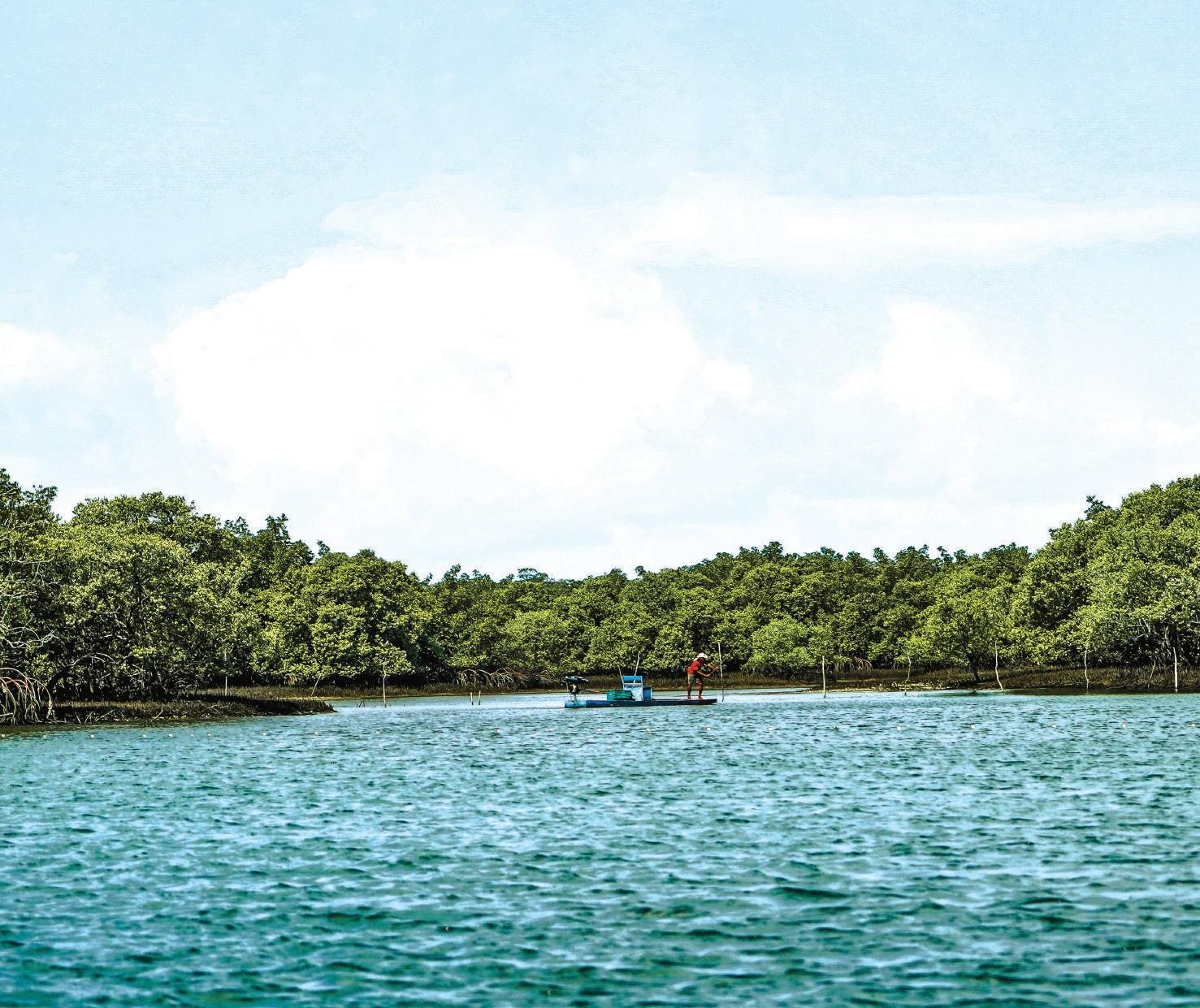
A cesta de projetos socioambientais de Suape cresceu com o Sistema Agroflorestal, mas já conta com iniciativas importantes que estão fazendo a diferença na vida de muita gente. O programa Quintais Ecoprodutivos é uma dessas ações, beneficiando 3.330 pessoas no território estratégico do complexo, garantindo segurança alimentar e a geração de renda por meio da ecotecnologia.
As casas dos moradores passaram a contar com galinheiros móveis, cisternas e fornos ecológicos, permitindo que as famílias em situação de vulnerabilidade social começassem a produzir alimentos para o próprio consumo. O que consideram excedente é comercializado. O programa foi desenvolvido em parceria com a Cáritas Regional Nordeste 2, organismo da Conferência Nacional dos Bispos do Brasil (CNBB).
Outro projeto consolidado é o Tô na Feira. A feirinha itinerante foi criada em 2019. Ora circula nas empresas, ora nas indústrias, ou é montada no próprio Centro Administrativo de Suape. É o momento de interagir, divulgar os produtos, comercializar artesanatos, comidinhas e bebidas típicas da região, como os licores e as deliciosas cocadas. O Tô na Feira é mantido por Suape, mas faz tanto sucesso e ajuda tanta gente que deve ser adotado por alguma empresa. Esse, aliás, é outro movimento que a estatal pretende impulsionar.
Como um projeto puxa o outro, tem gente do Tô na Feira que já passou pela Estação Compartilhar, no Engenho Massangana, um espaço de acolhimento que oferece serviços gratuitos para 8 mil pessoas. Em uma área de 90 metros quadrados, a comunidade tem acesso, de segunda a sexta-feira, a bibliotecas (adulta e infantil), sala de recreação para crianças, sala de reuniões, além de computadores com internet e cozinha escola.
Moradores do território estratégico também puderam investir no empreendedorismo, por meio de cursos de capacitação do Suape Incentiva, como design de sobrancelhas, manicure e gastronomia. O projeto, realizado em parceria com o Serviço Brasileiro de Apoio às Micro e Pequenas Empresas (Sebrae-PE), contemplou 250 famílias em situação de vulnerabilidade social. Tem ainda o trabalho com a Associação de Catadores e Artesãos de Materiais Recicláveis da Nova Vila Claudete (NovaClau Recicla) e o projeto Observatório da Pesca Artesanal, um fórum aberto e permanente para discutir e promover a atividade na região.
Suape quer ir além e criar um fundo de prosperidade com a chancela de uma instituição internacional de peso, a exemplo da Unesco. A meta é impulsionar esses e outros projetos que possam acelerar o desenvolvimento para todos.
Suape’s collection of social and environmental projects has grown with the addition of the Agroforestry System and already includes major initiatives that are making a difference in the lives of many people. The Green Produce Gardens project is one of these and serves 3,330 residents of the area in which the complex is located, ensuring food security and income generation by way of ecotechnology.
Residents’ homes will now be equipped with mobile chicken coops, water tanks, and green ovens, enabling socially vulnerable families to begin to produce food for their own consumption. Any surplus produce can be sold. This program was developed in partnership with Cáritas Regional Nordeste 2, an organization run by the National Conference of Brazilian Bishops (CNBB).
Another well-established project is Tô na Feira [I’m at the market]. This travelling market was created in 2019. It moves from company to company, from industry to industry, or is set up in Suape’s Administrative Center and provides an occasion to interact with people, promote products, and sell handcrafts and local food and beverages, such as liqueurs or delicious coconut candy. Tô na Feira is run by Suape, but it has proved so successful and helped so many people that it is certain to be adopted by some company or other sometime soon. This is something else that this public company aims to promote.
As one project tends to lead to another, some people from Tô na Feira have already migrated to Estação Compartilhar [Sharing Station], at Engenho Massangana, a center that provides services freeof-charge to 8,000 individuals. On this 90 m2 site, the community has access, on weekdays, to: libraries (general and children’s), a recreation room for children, a meeting room, computers with access to the Internet, and a teaching kitchen.
People living in the Suape area will also be able to invest in their entrepreneurial skills, by way of Suape Incentiva training courses, in fields such as eyebrow design, manicure, and gastronomy. The project, run in partnership with the Brazilian Micro and Small Business Support Service (Sebrae-PE), has already served 250 socially vulnerable families. Other projects include one involving the Nova Vila Claudete Association of Waste Pickers and Artisans Using Recyclable Materials (NovaClau Recicla) and the Artisanal Fishing Observatory, a permanent open forum for discussing and promoting this activity in the region.
Suape wants to go further and create a prosperity fund with the seal of approval of a heavyweight international institution, such as UNESCO. The goal is to provide further impetus for these and other projects that are capable of speeding up development for all.
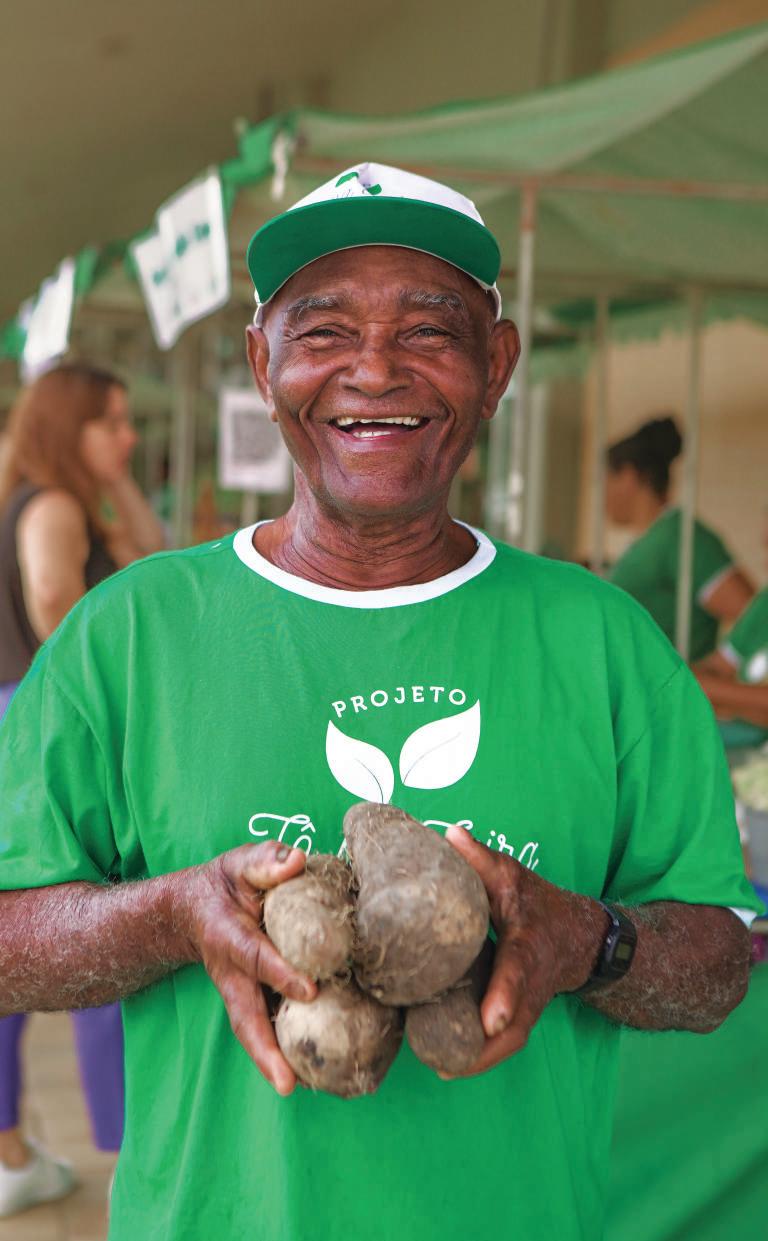
Amaro Clemente de Silva, morador do Engenho Boa Vista, é uma das muitas pessoas beneficiadas pelo programa Tô na Feira. A produção dele é diversificada e atrai de pronto a atenção dos clientes. “Eu tenho coco-verde, batata-doce, cará, macaxeira, banana. Tudo fresquinho. Planto tudo isso com a ajuda dos meus filhos. Antes, eu comercializava os produtos no centro do Cabo de Santo Agostinho. Mas é melhor aqui no projeto. Eu vendo muito mais. Eu acho o Tô na Feira muito bom, ajuda muito. Quando começar a andar sozinho, com as próprias pernas, vai ficar melhor ainda.”
Amaro Clemente de Silva, a resident of the Engenho Boa Vista neighborhood, is one of the many beneficiaries of the I’m at the Market program. His wide range of products immediately grabs the attention of customers. “I have green coconuts, sweet potato, yams, manioc, banana. All fresh from the farm. I grow all of this myself, with the help of my sons. Before this, I used to sell products in Cabo de Santo Agostinho town center. But it’s better here on the project. I sell much more. I think that I’m at the Market is great, it helps a lot. When it starts to walk on its own two feet, it will be even better.”


Renata Maria da Silva tem o dom de criar receitas que se transformam em deliciosos pães caseiros e bolos. Produtos que também ajudam a mudar vidas. Ela aprendeu tudo sozinha, mas faz questão de transmitir seus conhecimentos. A cozinha coletiva da Estação Compartilhar é a base de apoio, o lugar onde ela atua para ajudar outras mulheres a empreender. “A Estação começou como uma biblioteca, mas ampliou as atividades e surgiu a cozinha escola. Eu já ensinava a fazer pães caseiros. Tinha criado a Rede de Mulheres de Massangana, que conta atualmente com 50 integrantes. Mas esse espaço ajudou muito. A gente faz os pães, cursos de qualificação e muitas outras coisas. Aqui temos atividades para as crianças, internet, computador. Não imagino a comunidade sem esse projeto. Eu fazia pão em uma mesa batida, de concreto. De repente, você ganha tudo isso. Fico realmente emocionada. E agora tem a praça aqui na frente. Foram dois presentes.”
Renata Maria da Silva has the gift of creating recipes and transforming them into delicious home-made bread and cakes. These creations also help, however, to change lives. Renata taught herself everything, but she makes a point of passing on her knowledge to others. The Sharing Station’s collective kitchen provides a base of support - a place where Renata helps other women to become entrepreneurs. “The Station started out as a library, but then branched out, and so it was that the kitchen school came about. I was already teaching people how to make homemade bread. I had created the Massangana Women’s Network, which now has 50 members. But this new space helped a lot. People make bread, run training courses and do lots of other things. There are activities for children, Internet access, computers. I can’t imagine what the community would be like without this project. I used to make bread on a beaten up old table made of concrete. Then, suddenly, all this came along. It moves me to tears. And now there’s a square in front of us. It was two gifts.”


Atividades e operações portuárias passam pelo crivo de profissionais encarregados do controle ambiental. É feita a fiscalização de atividades como a manutenção e o abastecimento de embarcações. Também são realizadas, entre outras ações, o controle de destinação de resíduos dos navios e a inspeção ambiental de obras realizadas pela Autoridade Portuária
Port activities and operations are strictly supervised by professionals responsible for environmental oversight. This is carried out by way of inspection of activities such as maintenance and refueling of ships. Other actions include supervision of the disposal of waste from ships and environmental inspection of building work undertaken by the Port Authority
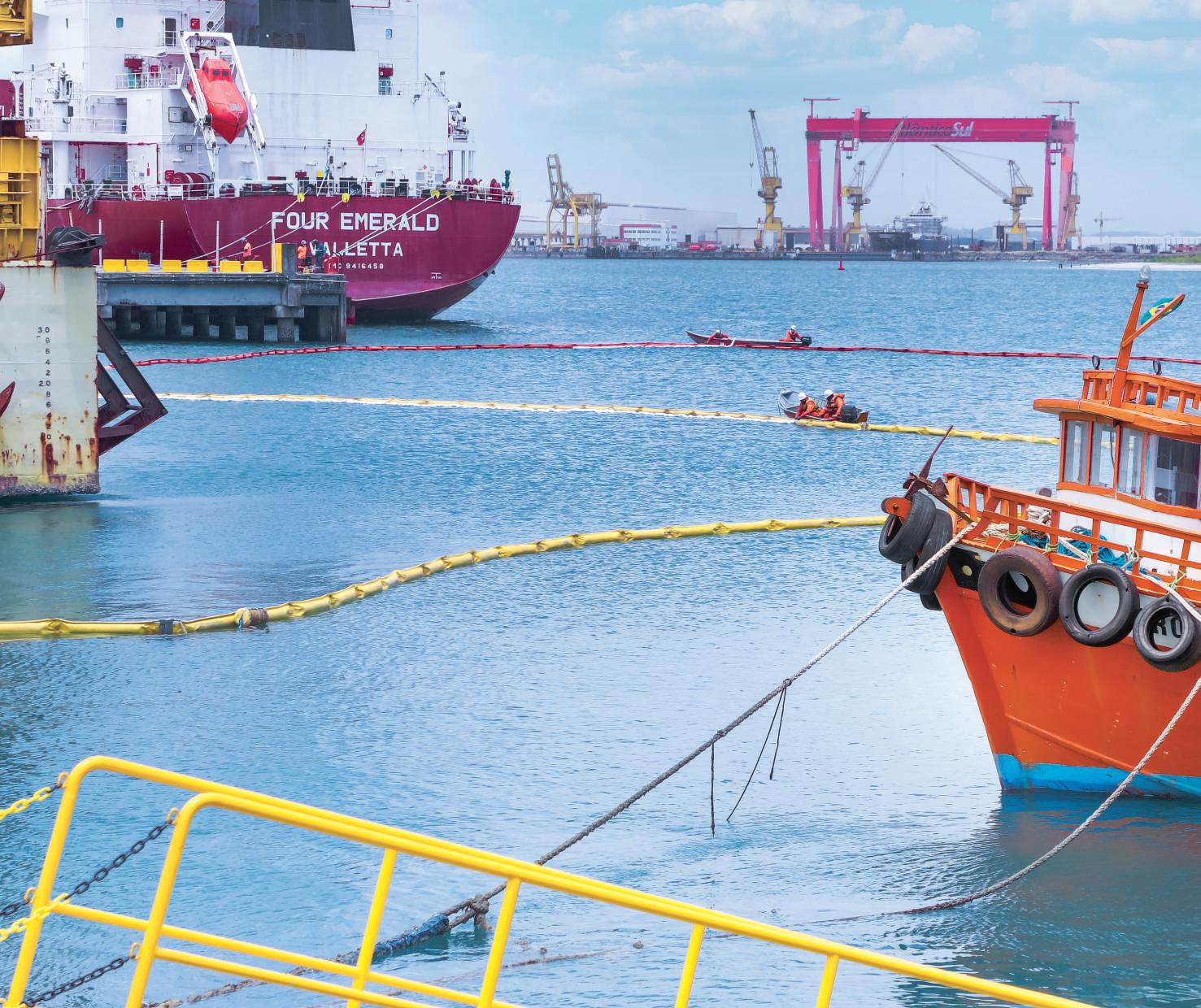
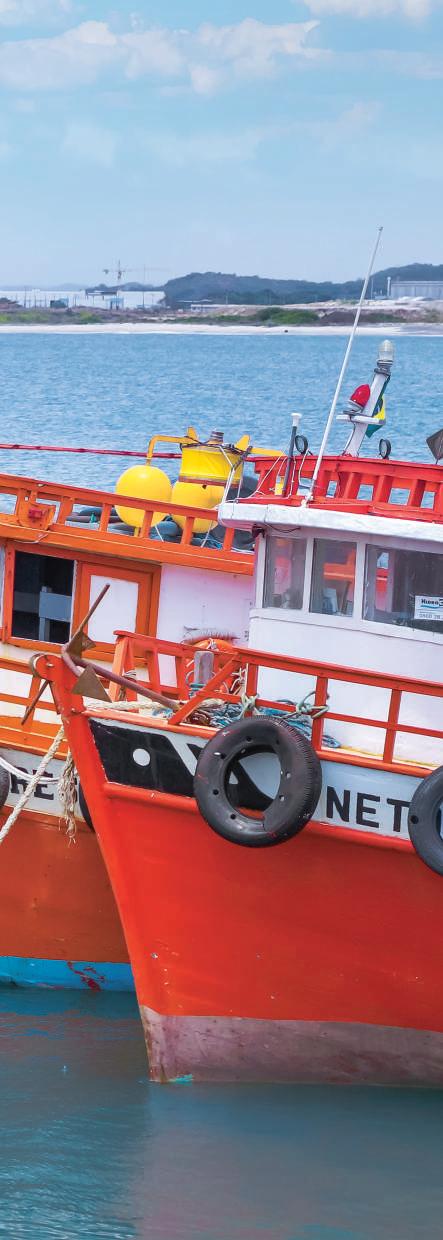


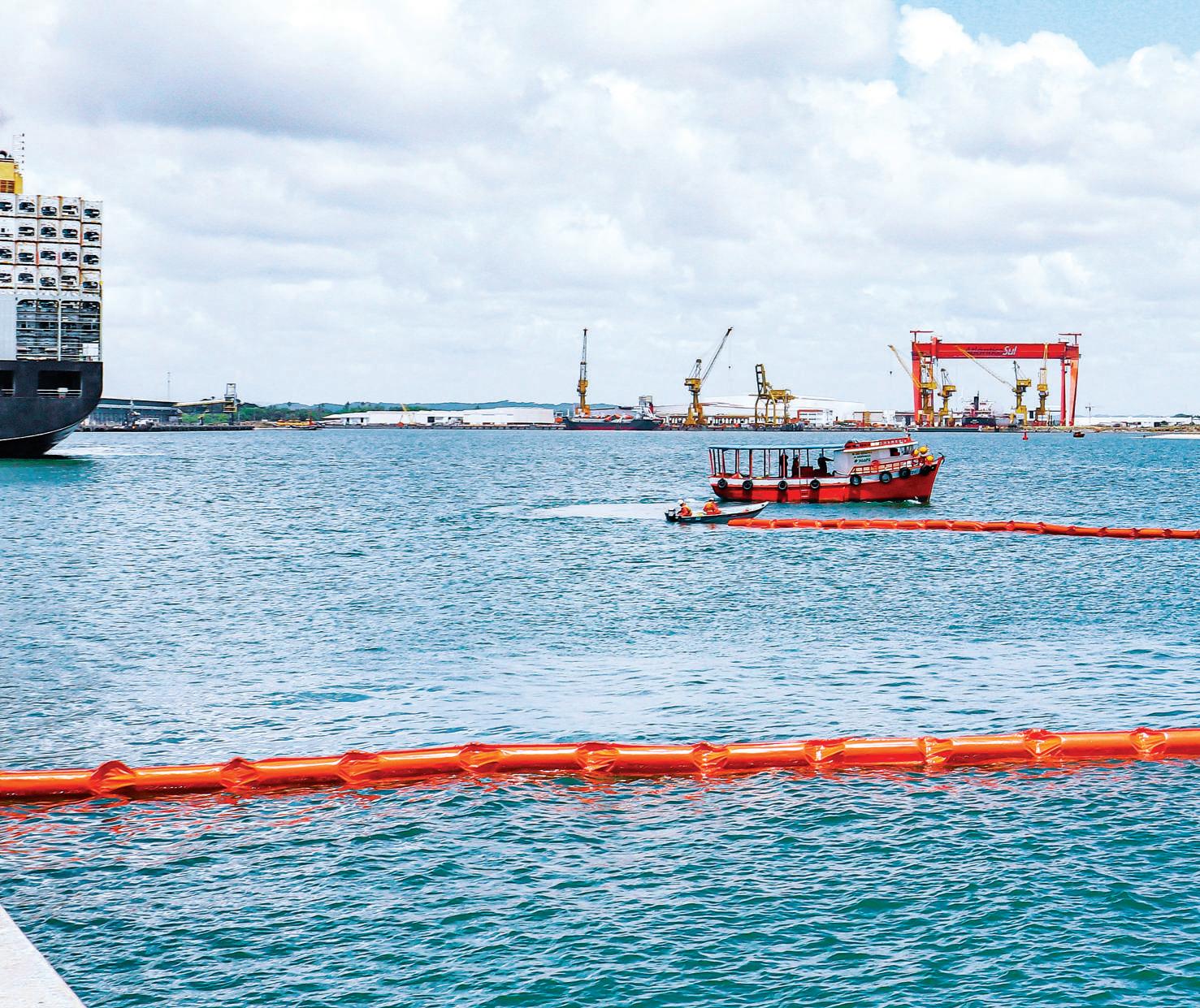





Biólogo e Botânico - Biologist and Botanist
O passado e o futuro do Complexo Industrial Portuário de Suape passam diretamente por diretrizes de sustentabilidade e preservação ambiental. Da concepção inicial às perspectivas para a próxima década. Uma grande testemunha dessa história é Durázio Siqueira. Biólogo da Diretoria de Sustentabilidade, ele tem sua vida profissional ligada à estatal portuária há mais de quatro décadas.
- O cuidado com o meio ambiente está no DNA de Suape. Já em sua concepção original, o projeto trouxe a necessidade de o Governo do Estado contratar um grupo de pesquisadores que estudaram a fundo essa região, do ponto de vista ecológico, passando pela ecologia urbana, sinecologia e autoecologia.


“
Conseguimos unir os remanescentes que foram isolados pela indústria canavieira por centenas de anos, matas que ficaram separadas. O corredor permite o fluxo gênico entre plantas que ficaram isoladas, aumentando as áreas florestais e evitando a erosão genética.”
Dos seus 17,3 mil hectares, o Complexo de Suape destina 59% para a preservação ambiental dentro da chamada Zona de Preservação Ecológica (ZPEC). Situada nos municípios de Ipojuca e do Cabo de Santo Agostinho, reúne no bioma Mata Atlântica e ecossistemas associados: Mangues e Restingas. Nela estão abrigadas importantes unidades de conservação, como a Estação Ecológica de Bita e Utinga, que elevou a proteção ambiental do Parque Natural Estadual de Suape, dos Parques Estaduais Mata do Zumbi e Mata de Duas Lagoas, assim como da Área de Proteção Ambiental Estuarina dos Rios Pirapama e Jaboatão e da Área de Relevante Interesse Ecológico Ipojuca-Merepe.
Durázio aponta a capacidade de Suape de se adaptar sustentavelmente aos avanços e ao tempo. A própria ZPEC, por exemplo, passou por algumas reconfigurações em sua geometria, mas sem perder tamanho. Entre os grandes marcos dessa trajetória, está o Decreto no 8.447, de 1983. Foi publicado dois anos depois da chegada do biólogo a Suape, aprovando as normas do uso do solo, uso dos serviços e preservação ecológica do complexo.
Em seguida, surgiram os projetos de reflorestamento com frutíferas (manga e caju) associados à regeneração das matas nativas, em um momento no qual não havia nenhuma obrigação legal de compensação ambiental. Mesmo assim, Suape teve a iniciativa de começar um projeto que benefi-
ciou a população local com a plantação de frutíferas, estimulado pelo antigo Instituto Brasileiro de Desenvolvimento Florestal (IBDF), órgão que viria depois a se fundir com outros para formar o atual Instituto Brasileiro do Meio Ambiente e dos Recursos Naturais Renováveis (Ibama).
A partir do momento em que as compensações ambientais passaram a ser instituídas pela Agência Estadual do Meio Ambiente (CPRH), surgiram projetos como os Corredores Florestais, desenvolvidos por Durázio, unindo os remanescentes de matas que se encontravam separados por espaços vazios.
- Conseguimos unir os remanescentes que foram isolados pela indústria canavieira por centenas de anos, matas que ficaram separadas. O corredor permite o fluxo gênico entre plantas que ficaram isoladas, aumentando as áreas florestais e evitando a erosão genética.
Hoje, Durázio continua no trabalho de conservação dos ambientes naturais e na consulta técnica aos processos de restauração florestal das áreas da ZPEC. Um projeto que tem como meta ser concluído até 2035. Atualmente, também vem sendo desenvolvido um estudo pioneiro sobre as faunas nativa e sinantrópica de Suape. O trabalho consiste em um levantamento sobre os animais presentes na região, assim como as dinâmicas ecológicas que se desdobram a partir disso. Em Suape e fora dele, Durázio é símbolo de memória, história e de um inestimável respeito pela natureza.
The past and the future of the Suape Port and Industrial Complex, from its initial conception to the plans for the next ten years, involve sustainability and environmental preservation. An important witness to this history is Durázio Siqueira, a biologist in the Sustainability Department, who has been working at the port for over four decades.
- Caring for the environment is in Suape’s DNA. From its inception, the project required the State Government to hire a group of researchers to study the region in depth from an ecological point of view, involving urban ecology, synecology and autecology.
Fifty-nine percent of the Suape Complex’s 17,300 hectares is set aside for environmental preservation in what is called an Ecological Preservation Zone (ZPEC). Situated in the municipalities of Ipojuca and Cabo de Santo Agostinho, the area covers the Atlantic Forest biome and related ecosystems: mangroves and restinga. This includes important conservation units such as the Bita Ecological Station and Utinga, which have increased the level of environmental protection of the Suape State National Park, the Mata do Zumbi and Mata de Duas Lagoas State Parks, along with the Rivers Pirapama and Jaboatão Estuary Environmental Protection Area and the Ipojuca-Merepe Area of Significant Ecological Interest.
Durázio points to Suape’s capacity to adapt sustainably to changes and to the passage of time. The ZPEC itself, for example, has seen some changes in its geometry without diminishing its size. One particular milestone in this regard was Decree no 8,447, of 1983, which was published two years after Durázio arrived in Suape and approved norms relating to land-use, use of services, and ecologi-
cal preservation in the complex.
After this came projects involving reforestation with mango and cashew trees, at a time when there was no legal obligation to provide environmental compensation. Even so, Suape took the initiative of starting a project that benefited the local population by planting fruit trees and providing support for what was then called the Brazilian Institute of Forest Development (IBDF), an organization which would later merge with others to become what is now the Brazilian Institute of the Environment and Renewable Natural Resources (Ibama).
The beginning of the provision of environmental compensation by the State Environment Agency (CPRH) saw the emergence of projects such as Forest Corridors, designed by Durázio to join together remnants of the forest previously separated by wasteland.
- We managed to join together remnants that had been cut off by sugar plantations for hundreds of years, sections of forest that had been separated. The corridor enables the flow of genes between plants that had previously been isolated, increasing the forested area and avoiding depletion of the gene pool.
Durázio is still working with conservation of natural environments as a technical consultant for forest restoration in ZPEC areas. The aim is to conclude this project by 2035. Another pioneering project currently underway involves Suape’s native and synanthropic fauna. The work includes a survey of animals present in the region, and of the ecological dynamics that they create. Within Suape and elsewhere, Durázio is a shining example of the importance of remembering, recording and showing great respect for the natural environment.
VERÔNICA SIQUEIRA
Assistente Social - Social Worker
Vida de estudante é repleta de desafios. A de Verônica Siqueira, quando tinha 19 anos, não era diferente. Aluna do curso de ciências sociais na Universidade Federal de Pernambuco (UFPE), em 1980, ela foi uma das estagiárias selecionadas para trabalhar em Suape. Já nas primeiras missões, teve que embarcar em pequenas canoas ou jangadas nas travessias para as Ilhas de Cocaia e de Tatuoca. A tarefa era levantar o número de famílias que moravam nas duas comunidades e cadastrar todas elas.
- Para ter acesso às ilhas, a gente tinha que ir de barco, canoazinha. Mas, na maioria das vezes, a travessia era feita nas jangadas do pessoal de lá mesmo.


“
Suape sempre foi muito importante na minha vida. O que marcou para mim de bom, que ainda marca, são as verdadeiras amizades que eu fiz aqui.”
De estagiária à funcionária efetiva, Verônica vivenciou momentos especiais da trajetória do complexo. No começo, quando chegou, o quadro funcional ainda estava sendo formado por profissionais que migraram de diferentes secretarias do Governo do Estado.
- Muitos desses profissionais eram pessoas ilustres, muito famosas e conhecidas no estado como servidores públicos antigos.
O tempo passou e Verônica tem muita coisa para contar. Uma história que envolve até mesmo longas amizades, amor e paixão. Foi em Suape que ela conheceu o biólogo Durázio Siqueira, com quem se casou, teve três filhos, um neto e segue a vida.
- Foi quase um ano de paquera. Ele sempre foi uma pessoa cordial, atenciosa. Não só comigo. Demorei a entendê-lo, saber da importância dele na minha vida. Quando decidi dar uma chance, ele me conquistou.
Verônica compartilha com o marido a atenção e o cuidado com o meio ambiente, com as causas sociais e sustentáveis. Não por acaso, um período que ela guarda na memória afetiva é justamente quando fazia parte da Divisão de Preservação Ecológica e Ambiental.
- Nós participamos dos primeiros projetos de plantio de
mata, de reflorestamento com frutíferas ao longo do território de Suape. A iniciativa tinha o vetor social. As assistentes sociais estavam ligadas a isso. Foram plantados cajueiros, mangueiras e outras árvores. Até hoje, você passa em determinada época do ano e tem gente vendendo caju, gente vendendo castanha, que ainda é dessas áreas.
A assistente social tinha, ainda, um olhar para a garantia de direitos dos funcionários. Tanto que, no começo da década de 1980, participou da criação da associação de servidores. Com o surgimento do sindicato, chegou à presidência e segue atualmente na atividade sindical. O Brasil ainda vivia o período do regime militar e ela também participou de movimentos pela redemocratização do país.
Verônica teve idas e vindas em Suape porque atuou nas secretarias de Educação, Meio Ambiente e Administração, além de ter passado 12 anos na Prefeitura do Recife. Mas, se perguntar o que o complexo representa para ela, a resposta chega na ponta da língua.
- Suape sempre foi muito importante na minha vida. O que marcou para mim de bom, que ainda marca, são as verdadeiras amizades que eu fiz aqui. As pessoas que realmente eu gosto e que retribuem esse sentimento.
A student’s life is full of challenges and that of Verônica Siqueira, when she was 19 years old, was no different. It was when she was studying Social Work at the Federal University of Pernambuco (UFPE), in 1980, that she was selected to work as an intern at Suape. One of her first tasks was to go out in canoes or small local boats to the islands of Cocaia and Tatuoca to survey the living conditions of each family living in these communities and to register them for social services and possible relocation.
- The islands were only accessible by boat or canoe. However, the crossing was usually done using one of the traditional boats belonging to the islanders.
After becoming a fully-fledged member of staff, Verônica lived through key periods in the history of the Complex. When she first arrived, the employees were still mostly people who had moved from various State Government departments and agencies.
- Many of these were famous technical experts who had earned a good name for themselves in the State as dedicated public servants.
Much time has now passed and Verônica has many stories to tell. It is a history of love and passion and long-standing friendships. It was in Suape that she met Durázio Siqueira, whom she married, and bore three children. She has one grandchild and life goes on.
- We dated for around a year. He was always very friendly and kind. Not just with me. It took me a while to get to know him, to understand how important he was for me. When I decided to give it a go, he won me over.
Verônica shares her husband’s concern and passion for the natural environment, sustainability, and social issues. It is no coincidence that the period that she looks back on most fondly is precisely the time she spent in the Department of Ecological and Cultural Preservation.
- We were involved in Suape’s first project involving planting fruit trees and reforesting the area. This was a social project. Social workers were involved. We planted mango trees and cashew trees and others. To this day, at certain times of the year, you can see people selling cashew nuts gathered from these reforested areas.
As a social worker, Verônica was also interested in the rights of employees. In the early 1980s, she was a founding member of the Suape Staff Association (Asfus), of which she was director and, later, president. With the creation of the Single State Servants Movement (Muse) and consequent formation of a union, she arrived at the Department of Formal Employees and is currently an active trade unionist. At that time, Brazil was still ruled by a military dictatorship, and Verônica was involved in the pro-democracy movement.
Verônica came and went at Suape, working also in the State Departments of Administration, Education, and the Environment, in addition to previously having occupied posts in three different administrations at Recife City Hall. However, when asked what the Complex means to her, her response is instantaneous.
- Suape has always been very important for me professionally. The impact that it has had on me and that it continues to have, beyond the work itself, concerns the lasting friendships I have made here. People I really like and who like me in return.
ANTÔNIO DA HORA
Topógrafo - Topographer
De família de pescadores, nascido, criado e enraizado em Suape, Antônio Manoel da Hora é também um dos funcionários mais antigos do porto-indústria. Trabalhou nas obras em 1979, pouco depois da criação do complexo, deixando a pescaria de lado para começar a se especializar em topografia.
Antônio já não se interessava muito pela atividade de pescador. Só que, diante do contexto em que vivia, era a opção mais certa para garantir o sustento. Chegou a ir para o alto-mar pescar, mas percebeu cedo que não se identificava com a atividade. Com a experiência obtida nas obras iniciais de Suape, conseguiu outros trabalhos no Rio de Janeiro, já na área de perfuração e sondagem do solo.
Alguns anos depois, voltou do Rio para Pernambuco. Encontrou novamente em Suape a sua segunda casa.
- O meu primeiro trabalho em Suape como topógrafo foi


Eu admiro muito Suape, como pessoa e como funcionário. Posso dizer que mudou a minha vida.”

medir o nível de referência no solo na área que hoje é a refinaria, para encontrar o nível do mar. E a primeira grande área de terraplenagem que fizemos foi no acesso da PE-60 até a Petrobras.
Com 43 anos de ligação com Suape - e praticamente a vida inteira como morador da região -, Antônio olha para trás com uma certa nostalgia, na perspectiva de quem viu muita coisa mudar. Mas também vislumbra o horizonte do
mar todos os dias, sabendo que as transformações fizeram os processos evoluírem para melhor.
- Eu não vou negar que me senti ameaçado à medida que a tecnologia foi avançando, mas hoje entendo que é um adianto de vida. Se ontem eu levava dois ou três meses para fazer um serviço, hoje, com a ajuda do drone, concluo em quatro horas. Eu admiro muito Suape, como pessoa e como funcionário. Posso dizer que mudou a minha vida.
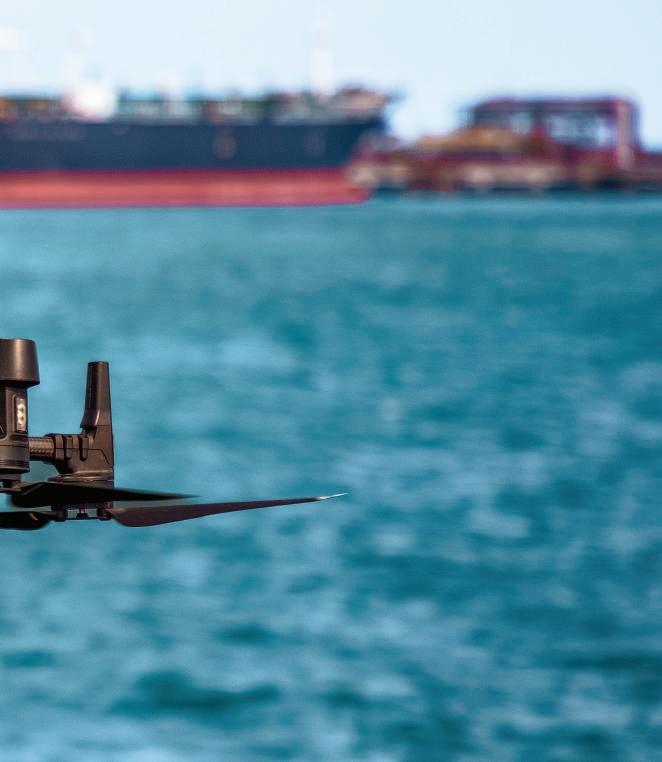
Born into a family that fished the sea for a living and brought up in the Suape region, Antônio Manoel da Hora is also one of the industrial port’s oldest members of staff. He has been working there since 1979, shortly after the complex was created, giving up fishing to train to work as a surveyor.
Antônio was already not much interested in the fishing industry. It was, however, in his community, the best option for securing a livelihood. He started out fishing on the open sea, but realized early on that he was not suited to this kind of work. With the experience he gained working at Suape, he managed to get other jobs in Rio de Janeiro, in the field of drilling and soil surveying.
Some years later, he returned from Rio to Pernambuco. Once again, he found a second home at Suape.
- My first job at Suape as a surveyor involved measuring the elevation of the land in the area that is now occupied by the refinery to identify sea level. The first major earthworks carried out were to provide access from the PE-60 highway to Petrobras.
With a 43-year history of working for Suape – and as an almost lifelong resident of the region - Antônio looks back with the nostalgia of someone who has seen many things change. But he also looks out to sea every day, knowing that the changes are designed to make things better.
- I can’t pretend that I don’t feel threatened by the advance of technology, but nowadays I understand that it makes life better. In the past, it took me two or three months to finish a job, now, with the help of a drone, I can finish in four hours. I have great admiration for Suape, as someone who works there and as a private individual. It is fair to say that it has changed my life.

Rumo ao futuro Looking to the future
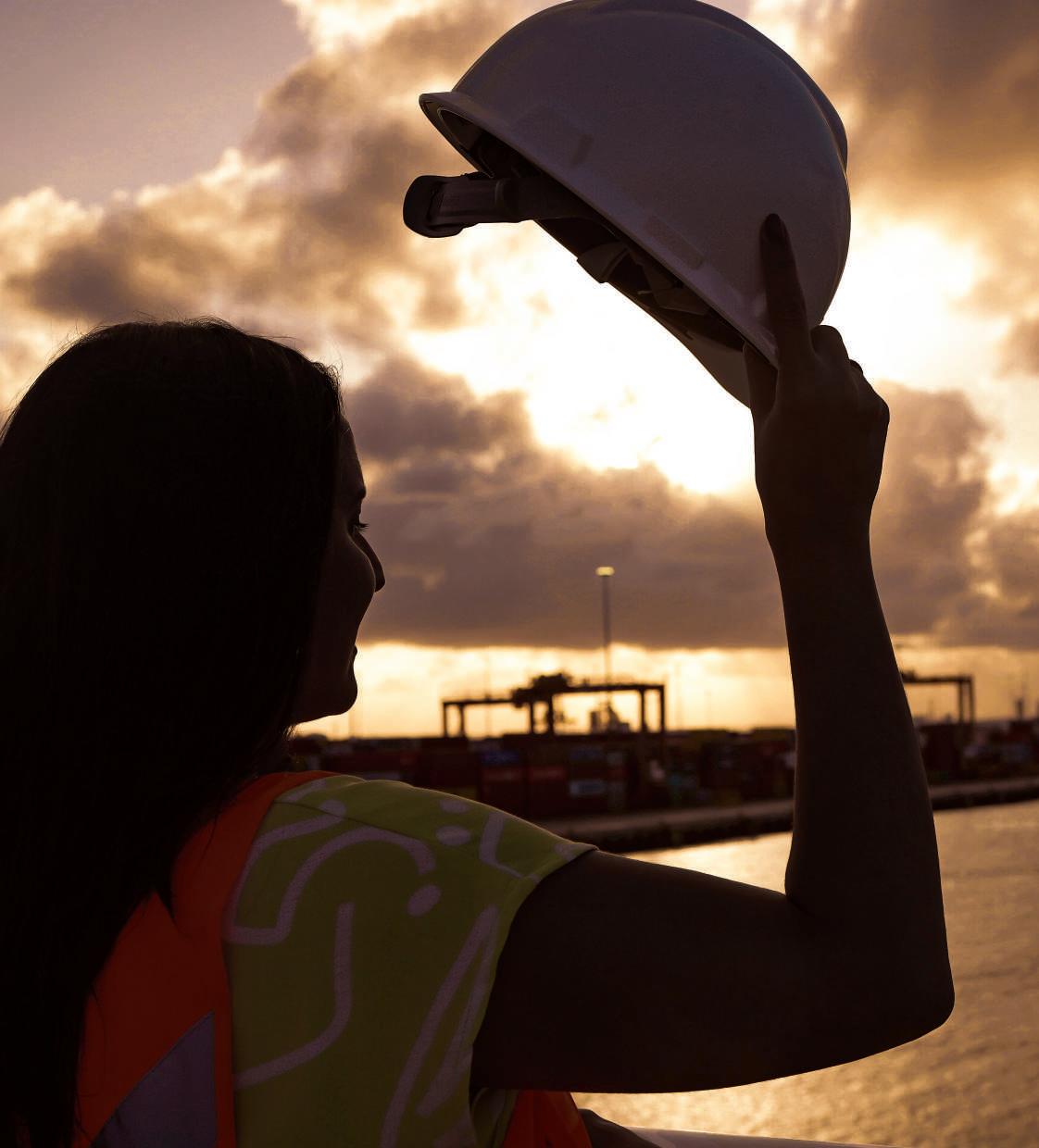
Quando olha para o futuro, Suape mira em 2035. Terá como guia nos próximos anos um novo Plano Diretor, com um planejamento estratégico inovador e uma série de desafios. Mas os cenários são otimistas e permeados de crescimento, sustentabilidade, investimentos estruturantes, desenvolvimento econômico e social. A movimentação total de cargas sinaliza tempos promissores. Até lá, pode ficar 64% maior.
Outro indicador importante é a previsão de aumento da área de cais. Suape conta, em 2023, com quase dois quilômetros de berços de atracação. O Plano Diretor projeta que o porto chegará, no futuro, a aproximadamente dez quilômetros de cais. Cinco vezes mais do que dispõe até o momento. Especialistas também trazem boas novas. Avaliam que o Complexo Industrial Portuário, em plena expansão, será o hub port da América do Sul.
Isso não é pouco. Significa enxergar Suape como um polo de atração de grandes linhas de mega carriers - importantes operadores e armadores de linhas regulares. Quem ficou perplexo com o navio gigante de 347,29 metros de comprimento que atracou no porto - ou com a dimensão atingida por Suape nessas quatro décadas e meia - pode se preparar para o que ainda vem a seguir. E por várias frentes.
O desenvolvimento também chegará pelos trilhos. Uma linha férrea foi reinserida nos planos de investimento do governo federal, contemplando o trecho de 548 quilômetros que vai conectar o ramal de Salgueiro, no Sertão pernambucano,
ao Complexo Industrial Portuário, na Região Metropolitana do Recife.
Quando estiver ativa e operando, a ferrovia vai redesenhar a logística da movimentação de cargas de toda a região. Uma dívida de décadas. Isso significa que o Nordeste deve impulsionar o desenvolvimento, começar a diversificar o modal de transportes e deixar de andar majoritariamente de caminhão, avançando também nas importantes conexões com o modal marítimo.
A ferrovia é um sonho de muito tempo, mas repleto de idas e vindas, altos e baixos. Depois de finalmente ser iniciada, em 2006, teve as obras interrompidas uma década depois. Foi redesenhada e excluiu o ramal que beneficiaria o porto-indústria do traçado original. Pernambuco uniu forças para reverter essa danosa decisão. O setor empresarial, o meio político e o Governo do Estado deram-se as mãos, mobilizaram-se e conseguiram virar o jogo.
O resultado é que o ramal Salgueiro-Suape foi contemplado em 2023 pelo Programa de Aceleração do Crescimento (PAC), do governo federal. O investimento previsto é de R$ 5 bilhões, o que exigirá uma eficiente engenharia financeira. Mas o que enche os olhos mesmo é um horizonte bem mais largo. Típico da dimensão de um projeto estruturador.
As projeções iniciais estão prontas. Com a ferrovia operando - e levando em consideração que Suape vai passar
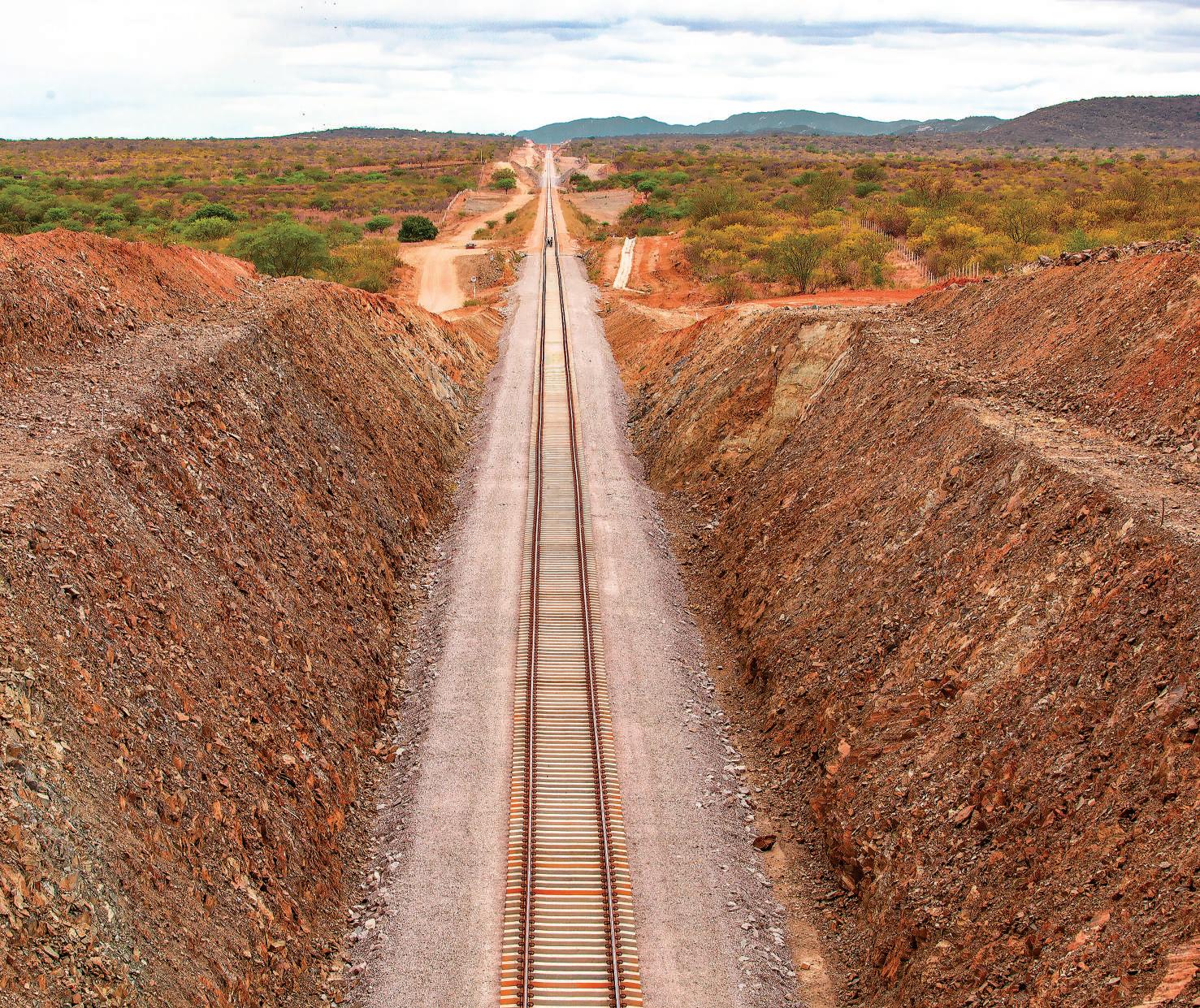
a contar com um terminal de minérios e a Refinaria Abreu e Lima (Rnest) turbinada pelo segundo trem de refino -, a movimentação do porto dará um salto extraordinário. Deve chegar a 48,6 milhões de toneladas em 2030.
Um estudo de demanda vai apontar potenciais mercados para o novo modal. No radar estão, por exemplo, as frutas cultivadas no Vale do São Francisco. O polo gesseiro do Sertão do Araripe tem tudo para se tornar outro potencial usuário dos trilhos, já que ainda transporta tudo de caminhão
para longas distâncias.
Outro mercado importante que deve ser atraído com a ferrovia é o do chamado Polígono MATOPIBA . A região - formada pelos estados do Maranhão, Tocantins, Piauí e Bahia - é forte na produção de grãos, como soja e milho. Nenhuma dessas cargas transita atualmente por Suape. A aposta é que isso tem tudo para começar a mudar. A locomotiva da ferrovia deve, afinal, dar efetivamente mais velocidade ao desenvolvimento econômico.
Looking to the future, Suape has set its sights on 2035. Our guide for the next years will be the new Master Plan, complete with innovative strategic planning and a series of challenges. The prospects for the future, however, are optimistic, and full of growth, sustainability, structural investment, and economic and social development. Cargo shipment operations suggest that even better times lie ahead. Up to 2035, we should see growth of 64%.
Another important indicator is the projected increase in the total surface area of the quay. In 2023, Suape had two kilometers of quayside. The Master Plan projects that the port will, in future, have around ten kilometers. This is five times the current figure. Specialists also bear good tidings. They estimate that the industrial port complex, when it has expanded to its full capacity, will be the main hub port in South America.
This is no small achievement. It means that we must imagine Suape in the future as being a hub with the capacity to attract ma -
jor lines of mega carriers – major shipping operators and regular lines. Anyone who is astounded by the 347.29-meter-long ships that currently unload their cargo at Suape – or by the size that the port has grown to in the past 45 years – should prepare themselves for what is to come. On various fronts.
Development also involves trains. A railroad has been reincluded on the Federal Government’s investment agenda, with a planned 548km stretch that will connect the Salgueiro branch line, in the Sertão region of Pernambuco, with the industrial port complex, in the Recife Metropolitan Region.
When it is up and running, this railroad will change the freight transport logistics of the whole region. This is something that has been needed for decades and it means that the Northeast region will now be able to drive its own development, begin to diversify modes of transportation and depend less on road haulage, also making major new connections with shipping routes.

The railroad has been a dream for a long time, but it has experienced a troubled history, full of ups and downs. The project finally got started in 2006 but was suspended one decade later. The original project was redesigned in such a way as to exclude the branch line that would have benefited the industrial port. Everyone in Pernambuco joined forces to ensure that this bad decision was reversed. Business, politicians, and the State government all got together to succeed in turning things round.
The result is that, now in 2023, the Salgueiro-Suape branch line has been included in the Federal Government’s Accelerated Growth Program (PAC). Projected investment of R$ 5 billion will require sound financial management. More exciting still are the much broader horizons this has opened. This is typical of a structural project of this size.
The initial projections are ready. With the railroad in operation – bearing in mind that Suape will now have a mineral ore terminal
and the Abreu e Lima Refinery (Rnest), with capacity increased by the installation of the second refinery train -, throughput at the port should now soar and is expected to reach 48.6 million tonnes in 2030.
One study of the demand has indicated potential markets for the new transport system. It will be possible, for example, to transport fruits grown in the São Francisco Valley region. The gypsum hub in Sertão do Araripe may well become another rail transport user, since it still transports all its goods long distances by truck.
Another important market that could be attracted by the railroad is that of the so-called MATOPIBA Polygon. This regionformed by the States of Maranhão, Tocantins, Piauí and Bahia – is a major producer of goods such as soya and corn. None of this produce currently comes through Suape. We fully expect, however, that this is soon set to change. Rail transport should speed up economic development.
Suape vai ganhar um novo e imponente Terminal de Contêineres. O investimento realizado por uma gigante mundial do setor é de R$ 1,6 bilhão, em uma área imensa, de 49,2 hectares, onde caberiam nada mais nada menos do que 50 campos de futebol.
O grupo tem vários braços comerciais e é um dos maiores do mundo no setor marítimo. Além de contêineres, o terminal vai movimentar cargas gerais e será erguido do zero, com início das operações previsto para 2026.
Nesse intervalo de tempo, serão realizadas várias obras e ações. Dragagem, adequação da estrutura de atracação, instalação de modernos equipamentos elétricos e do pátio de contêineres. Outra aliada estratégica do empreendimento será a tecnologia, além da política alinhada à Agenda ESG de Suape, que contempla diretrizes e compromissos ambientais no esforço para reduzir as emissões de CO2 nas operações.
A capacidade inicial de 400 mil TEUs já garante um incremento de 50% na capacidade total do complexo. Mas
isso é só o começo. A expectativa é que o terminal atinja a marca de 1,3 milhão de TEUs por ano, projetando Suape para um novo patamar. Em tempo: TEU é uma unidade medida que equivale a um contêiner de 20 pé s (6,1 metros de comprimento).
Se Suape já é líder no Nordeste na movimentação de contêineres, passará a competir com forç a por um lugar de mais destaque no ranking nacional com esse grande investimento. O terminal vai fomentar o mercado de trabalho, com a geração de 350 empregos diretos, impactar em diversas cadeias produtivas, baratear custos no porto e viabilizar a abertura de novas rotas comerciais.
Ao ampliar conexões com outros atracadouros, também alavanca as operações de cabotagem, segmento em que o porto pernambucano já é líder no país. Com preços competitivos e uma localização geográfica diferenciada, Suape surge com a estatura de um verdadeiro gigante no radar de clientes e investidores do mercado marítimo de vários países do mundo.
Suape will soon have a major new Container Terminal. An international giant in the sector is investing R$ 1.6 billion in a huge 49.2-hectare area, large enough to accommodate 50 full-size soccer fields.
The group has various commercial branches and is one of the largest shipping companies in the world. The terminal will ship containers and general cargo and will be built from scratch, with work expected to begin in 2026.
In the meantime, various other undertakings are underway. These include dredging, the improvement of quays, the installation of up-to-date electrical equipment and the creation of a container yard. This will also be helped by technology and by alignment to Suape’s ESG Agenda, involving environmental guidelines and commitments regarding attempts to reduce the CO2 emissions of operations.
The initial capacity of 400,000 twenty-foot equivalent units (TEUs) has already increased the total capacity of the complex by
50%. But this is just the beginning. The expectation is that the terminal will achieve a total of 1.3 million TEUs per year, taking Suape onto another level. A TEU is an inexact unit of measurement approximately equivalent to the length of a 20-foot container (6.1 meters).
While Suape is already a leading player in the Northeast region in transportation of container cargo, this great investment will now enable it to compete more effectively to attain a higher position in national rankings. The terminal will also boost employment, with the generation of 350 direct jobs, and have an impact on various chains of production, bringing down port costs and making it possible to open new commercial routes.
The broadening of ties with other ports also helps to leverage coastal shipping operations, a field in which Pernambuco is already the main player in Brazil. With competitive prices and a unique geographical location, Suape is emerging as a giant in the eyes of clients and investors in the shipping industry from various countries around the world.
Centro Administrativo de Suape


Entenda o mapa:
Terminais e cais existentes Existing quays and terminals
Terminais e cais privados (TUPs) Private quays and terminals (TUPs)
Terminais e cais propostos Proposed terminals and quays
Área de expansão para terminais e cais
Expansion area for terminals and quays
Área de expansão para terminais e cais privados (TUPs)
Expansion area for private terminals and quays
Molhe planejado Planned breakwater
Sistema viário proposto Proposed road system
Guaritas propostas Proposed guardhouses
Guaritas existentes Existing guardhouses
Canal navegável Ship canal


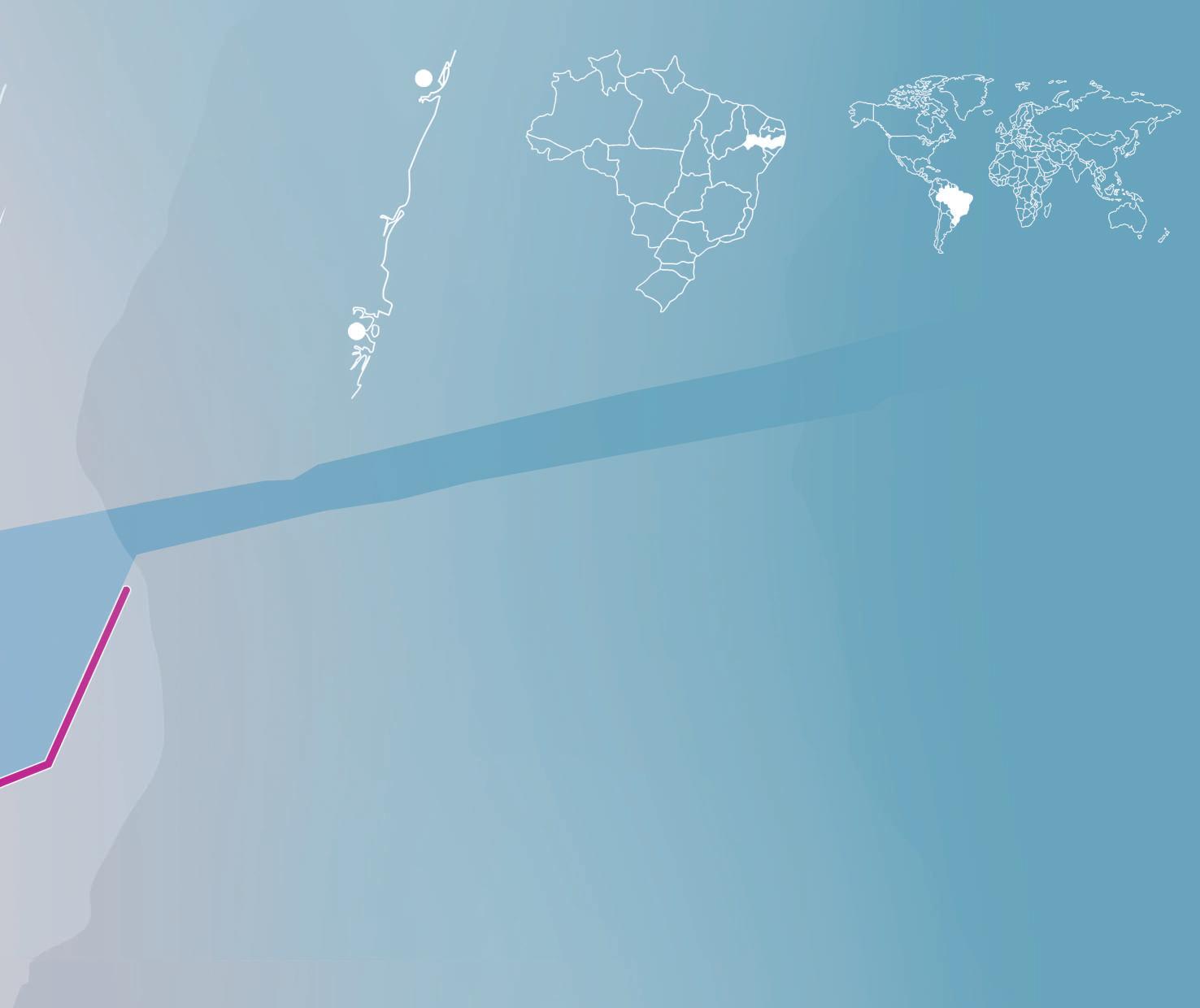
O tempo correu e Suape ficou grande. Uma trajetória ascendente, em 45 anos, que ganha mais impulso com um novo Terminal de Granéis Sólidos Minerais. Com investimento de R$ 1,5 bilhão, o empreendimento vai ocupar uma área de 51,8 hectares dentro dos limites da Zona Industrial Portuária do Complexo, na Ilha de Cocaia. A carga vai gerar uma receita de R$ 617,2 milhões em tarifas portuárias durante o período de 30 anos de operação do terminal.
A ferrovia é vital para fazer o empreendimento atingir o seu potencial máximo. O modal sobre trilhos vai permitir a conexão entre o porto e as jazidas de ferro do Piauí, viabilizando, dessa forma, o escoamento da carga para o porto pernambucano.
Com esse robusto empreendimento, projeções apontam que Suape terá um novo marco. A expectativa é que o atracadouro receba, diariamente, 50 mil toneladas de minério para embarque, resultando em uma movimentação de 13,5 milhões de toneladas por ano. Já a capacidade de estocagem no pátio será de 780 mil toneladas. Para o mercado de trabalho, as projeções são igualmente promissoras. No decorrer da obra, o terminal vai gerar 2,7 mil empregos diretos e indiretos. Em plena operação, serão consolidados 400 postos de trabalho. Esse é outro grande empreendimento que os visionários enxergaram no começo de Suape e que vai virar realidade nos próximos anos.
As time passes, Suape has just gotten larger and larger. Over the past 45 years, the curve has always been upwards and now the port has received further impetus with the installation of a new Solid Bulk Minerals Terminal. Investment totals R$ 1.5 billion and the undertaking will occupy a 51.8-hectare area within the Industrial Port Zone part of the Complex, on Cocaia Island. The new shipments will generate revenue of R$ 617.2 million in port fees over the 30 years of operation of the terminal.
The new railroad plays a vital role in enabling an undertaking to realize its maximum potential. The railroad will form a link between the port and iron ore deposits in the State of Piauí, which it will now
be possible to export through Pernambuco.
With the aid of this robust development project, it is projected that Suape will move onto a whole other level. It is expected that the port will receive 50,000 tons of minerals daily and see throughput of 13.5 million tons per year, with storage capacity of 780,000 tons.
Projections are equally promising for the employment market. During construction, the terminal is expected to generate 2,700 direct and indirect jobs. When fully operational, there will be 400 permanent jobs. This is yet one more great achievement of the kind the visionaries who created Suape imagined at the outset that will become a reality in the coming years.
Um navio imenso e diferente - dentre tantos outros que chegam e partem diariamente de Suape - simboliza mais um projeto estruturador para a economia de Pernambuco. O seu ponto de atracação é o Cais de Múltiplos Usos (CMU), no porto externo, onde será implantado um Terminal de Regaseificação de Gás Natural Liquefeito (GNL).
O empreendimento - de R$ 2 bilhões - significa um plus no mercado de gás natural no estado e no Nordeste. O player privado se encarrega de fazer a regaseificação em Suape e oferece o produto ao mercado. Com isso, a expectativa é de um aumento da oferta e, consequentemente, de uma redução dos custos na ponta.
Trata-se de um ativo estratégico para o desenvolvimento porque possibilita a expansão de indústrias, fomenta a cadeia produtiva e cria um ambiente atraente para o surgimento de novos negócios. A previsão é que o gás natural chegue até mesmo à região do Sertão do Araripe, beneficiando o maior polo gesseiro do país, pela rede da Companhia Pernambucana de Gás (Copergás).
Tudo vai começar no porto. O gás é importado em estado liquefeito. Navios gaseiros trarão o produto e, ao chegarem
em Suape, será feito o processo de regaseificação por meio da operação conhecida como ship-to-ship.
Quando o navio gaseiro carregado chegar a Suape, o produto será transferido para um navio-indústria, chamado de Unidade Flutuante de Armazenamento e Regaseificação de Gás Natural (FSRU, na sigla em inglês). É exatamente nele que ocorre a conversão do gás. Concluído o processo, o produto seguirá por dutos para a Estação de Transferência de Custódia (ETC). Na sequência, o gás será liberado para as redes de distribuição. Uma delas é exatamente a da Copergás.
Esse tipo de operação ocorre normalmente em alto-mar, com uma complexidade muito maior. As condições diferenciadas de Suape - com o píer localizado numa área com proteção natural e, portanto, em ambiente de águas abrigadas e tranquilas - permitem a regaseificação lá mesmo no cais. Um diferencial extraordinário em se tratando de uma zona portuária.
A área arrendada para uso do terminal é de 33,37 mil metros quadrados. O Complexo Industrial Portuário de Suape será remunerado pela cessão do CMU no valor global de R$ 6,2 milhões, para um período de 48 meses de contrato.
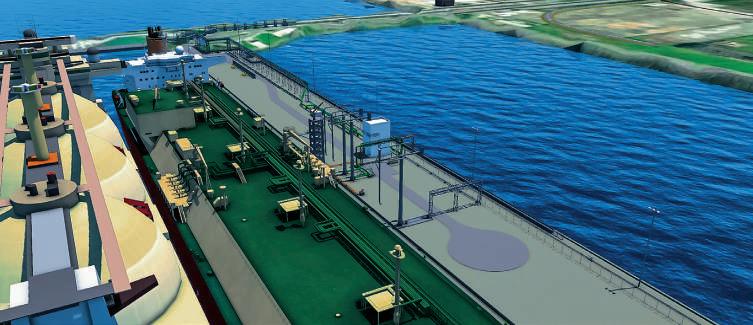

A huge ship, different from the many others that come and go daily at Suape, signals the arrival of yet another structural project that will boost the economy of the State of Pernambuco. The ship is currently berthed alongside the Multipurpose Quay (MPQ), in the outer port, where a Liquid Natural Gas Regasification Terminal is to be installed.
The undertaking - worth R$ 2 billion – represents a boon for the natural gas market in the State and in the Northeast region. This private player is responsible for regasification at Suape and subsequently sells the gas on the market. It is thus expected that there will be an increase in demand and, consequently, a reduction in costs at the point of delivery.
This is a strategic asset for development, because it helps to foster expansion of the industry and its chain of production and creates an environment conducive to the emergence of new businesses. It is projected that natural gas will be pumped as far as the Sertão do Araripe region, where it will benefit the largest gypsum hub in Brazil, through the Pernambuco Gas Company (Copergás) network.
Everything will begin at the port. The gas will be imported in a liquefied state. Gas tankers will bring the product to Suape and regasification will be carried out ship-to-ship.
When the gas tanker arrives in Suape with its load, the product will be transferred to an industrial ship, called the Floating Storage and Regasification Unit (FSRU) for LNG. It is here that it is converted back into gas. Once the process is completed, the product is pumped through ducts to the Custódia Transfer Station (ETC). Finally, the gas is released for the distribution companies, one of which is Copergás.
This kind of operation normally occurs at sea, a process that entails a much higher level of complexity. The special conditions at Suape – with the pier situated in a naturally protected area, in calm sheltered waters – enable regasification to be carried out at the quayside. This gives the port an extraordinary advantage.
The area leased for the terminal covers 33,370 square meters.
The Suape Port and Industrial Complex will be remunerated by the concession of the Multipurpose Quay at a total value of R$ 6.2 million, on a 48-month lease.
O tempo não para. Nem perdoa. Na corrida mundial pela descarbonização, cada minuto é precioso. Suape entrou nessa desafiadora maratona a passos largos. Prepara-se para ocupar uma posição importante no ranking da produção das energias renováveis. O carro-chefe é o TecHub Hidrogênio Verde (H2V). Mais do que um imponente cartão de visitas, nacional e internacional, é uma semente para o futuro.
No cenário de 2023, a obtenção do Hidrogênio Verde e a sua utilização ainda estão no começo. Os desafios são muitos. As regulamentações ainda estão sendo discutidas e estruturadas no Brasil. Mas não há como recuar. É uma tendência planetária.
E o que fazer até que o mercado esteja organizado e operando? Até que se saiba, também, quais serão os principais compradores e a que custo o produto será comercializado? A ordem é se adiantar. Mapear as oportunidades na cadeia produtiva de H2V e ficar pronto para o novo momento que se aproxima.
O TecHub, que tem como parceiros o Serviço Nacional de Aprendizagem Industrial (Senai-PE), o Departamento Nacional do Senai e o Governo de Pernambuco, e atrai potenciais investidores, entra em cena com uma pretensão ousada.
Quer se tornar um polo estratégico para pesquisa, inovação e desenvolvimento das tecnologias para produção, armazenamento, transporte e gestão do Hidrogênio Verde.
Com o H2V, é possível gerar energia sem a emissão de gás carbônico. Esse processo acontece em usinas por meio do processo da eletrólise, quando especialistas separam o oxigênio e o hidrogênio da água. As pesquisas nesse sentido avançam em várias partes do mundo para que o processo se
torne o menos complexo possível, o quanto antes.
Suape se propõe a sediar um cluster de transição energética em Pernambuco, envolvendo vários atores, como universidades, centros de pesquisa, escolas técnicas, o Porto Digital e, de forma mais ampla, agregando o chamado ecossistema de inovação. O que inclui parcerias com outros centros de pesquisas de energias renováveis internacionais, a exemplo dos instalados nas cidades de Aberdeen, na Escócia, e de Sheffield, na Inglaterra.
De projeto-piloto, o empreendimento quer evoluir para uma plataforma de usinas de produção do combustível do futuro em escala comercial. De forma que permita às empresas instaladas abrirem um vasto leque de oportunidades. Os investimentos podem chegar à cifra de bilhões de reais e gerar a criação de milhares de empregos.
Para começar, a CTG Brasil - uma das principais empresas de geração de energia sustentável do país - vai injetar cerca de R$ 45 milhões no TecHub. O combustível é considerado verde porque segue as normas de certificação e, ainda, pelo fato de que a usina funciona por meio de fontes de energia 100% renováveis.
O ambiente de Suape é absolutamente favorável. Tem condições naturais para a produção de H2V e de outras energias limpas, como a eólica. Na condição de porto-indústria, também deve se tornar um consumidor em potencial das fontes alternativas. As demandas externas, dentro e fora do país, são cada vez mais urgentes. Apontam para um horizonte altamente promissor e, o melhor de tudo, sustentável.
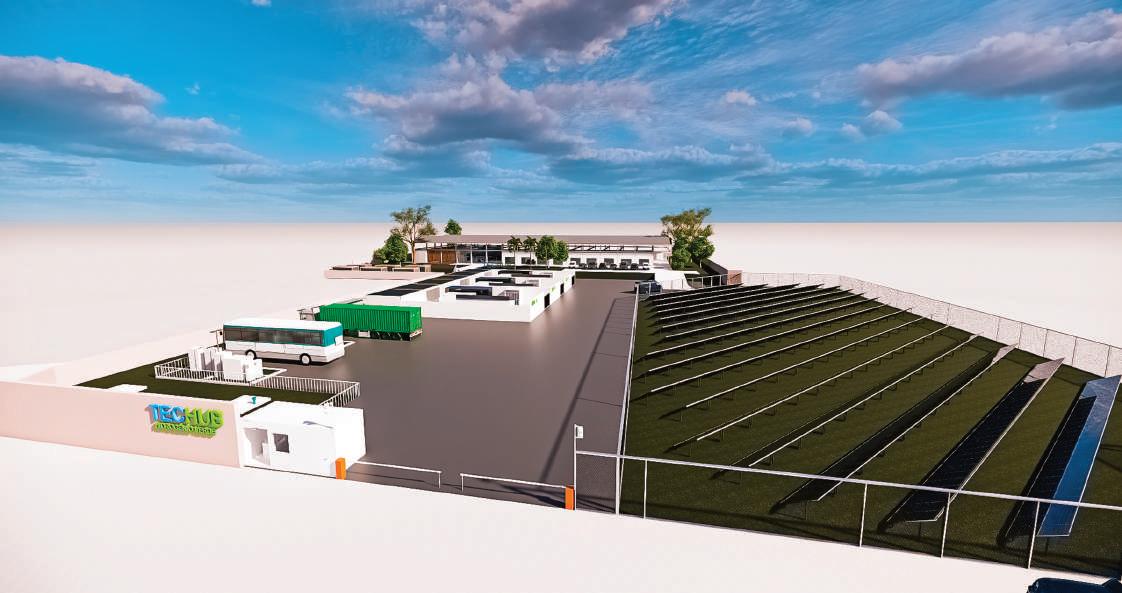

Time never stops. It is also always unforgiving. In the global race towards decarbonization, every moment counts. Suape has already made great leaps forward in this regard. It is preparing to rank highly among international renewable energy producers. The flagship project is the Green Hydrogen TecHub (H2V). Far from being designed merely to impress national and international visitors, this project is already sowing the seeds of future growth.
In 2023, the production and use of Green Hydrogen is still in its early stages and the challenges are many. Regulations are still being discussed and introduced in Brazil. But there is no going back. This is a worldwide trend.
What then can be done while the market is still not organized and up and running? We do not know who the main buyers will be and how much the product will cost, but the go-ahead has nevertheless already been given to map out H2V production line opportunities and be ready for the new world that is on the way.
TecHub, whose partners include the National Industrial Training Service (Senai-PE), the Senai National Department and the Government of the State of Pernambuco, and which is attracting potential investors, is starting out with a bold agenda. It aims to become a strategic hub for research, innovation, and development in relation to Green Hydrogen production, storage, transport and management technologies.
With H2V, it is possible to generate power without emitting CO2 gas. This is achieved using plants that employ electrolysis to sep-
arate the hydrogen and oxygen in water. International research in this field is making great progress towards making the process as simple as possible as soon as possible.
Suape aims to create a Pernambuco energy hub involving universities, research centers, technical schools, Porto Digital and, more broadly, the whole innovation ecosystem. This involves partnering with other renewable energy research centers around the world, such as those installed in the cities of Aberdeen, in Scotland, and Sheffield, in England.
The project aims to evolve from a pilot into a platform of plants for producing this fuel of the future on a commercially viable scale. This will enable the companies installed to access a wide range of opportunities. Investment could run into billions of Brazilian reais and generate thousands of jobs.
To get things started, CTG Brasil - one of Brazil’s main sustainable energy generation companies - will inject around R$ 45 million into TecHub. The fuel is considered green because it follows certain certification norms and also because uses 100% renewable sources of energy.
The Suape environment is very well suited to this. It is naturally endowed with the qualities needed to produce H2V and other clean energy sources, such as wind power. As an industrial port complex, it is also a potential consumer of alternative energy sources. External demand, within Brazil and abroad, is growing fast. This holds out good prospects for a future that will, better still, also be sustainable.

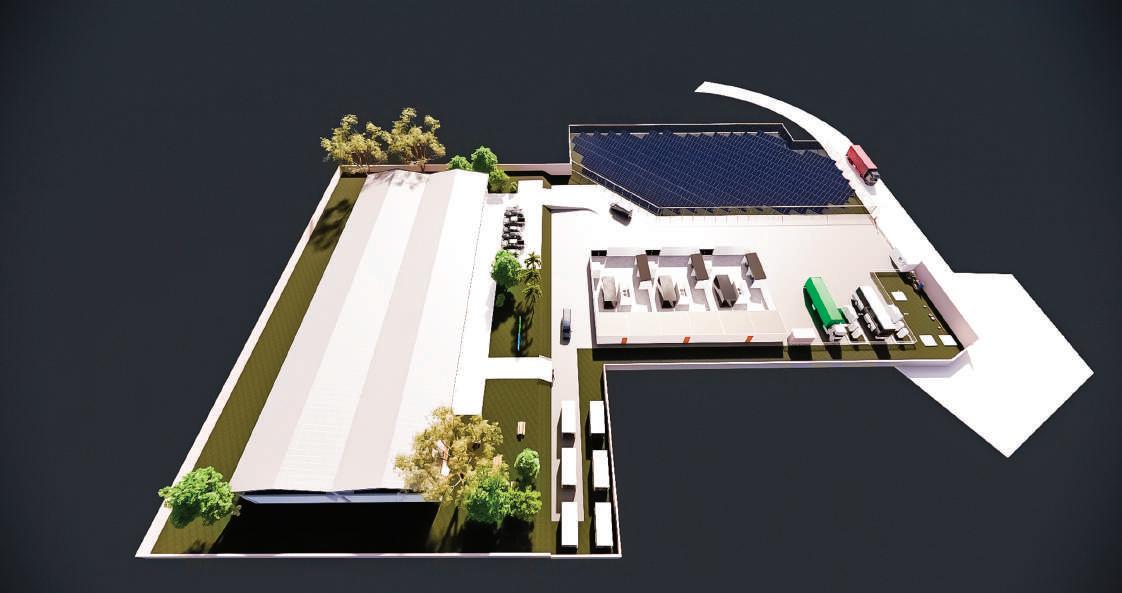
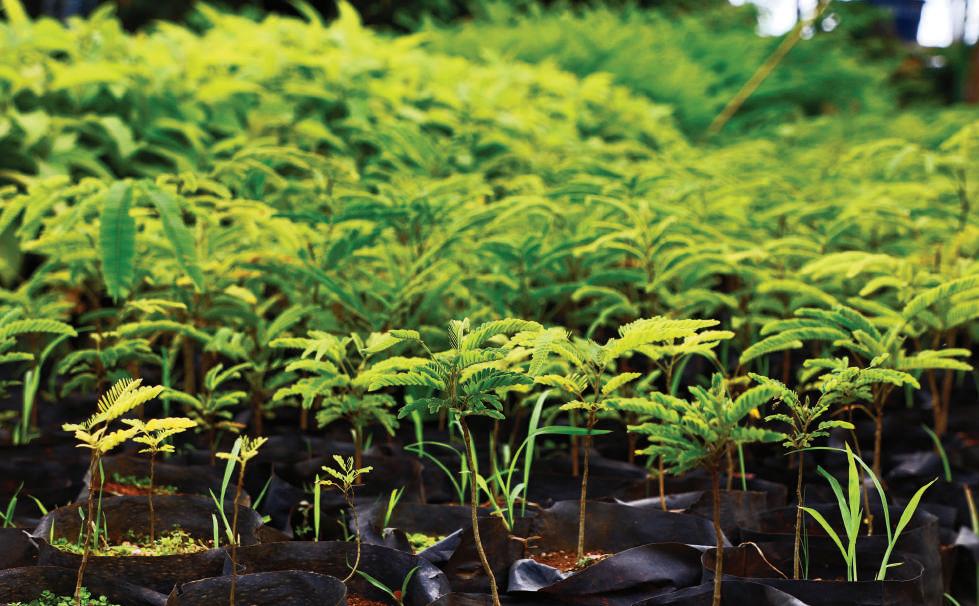

A mentalidade empresarial avançou e quebrou alguns antigos paradigmas. Os impactos que o mundo produtivo e dos negócios geram no meio ambiente passaram a ser encarados de forma mais cuidadosa. A compreensão atual é a de que o desenvolvimento e a sustentabilidade podem, sim, caminhar juntos. Suape aposta fichas nisso para agregar aliados, mitigar a emissão de gases de efeito estufa e fazer com que - no momento de neutralizar suas emissões - empresas instaladas no porto-indústria voltem o olhar para o seu próprio território.
Isso significa que, em vez de cruzar oceanos, as empresas possam adquirir esses créditos de carbono de projetos desenvolvidos no lugar onde estão estabelecidas. Uma relação de ganha-ganha, na qual todo mundo leva vantagem. A expectativa é construir um processo de engajamento empresarial para a neutralidade de carbono, dando mais capilaridade a ações e programas socioambientais que beneficiem as 17 mil pessoas que moram na área de Suape. A melhor face do desenvolvimento, afinal, é quando ele chega para todos.
O dever de casa para atingir essa meta está sendo feito. É uma jornada longa, que depende da ação concreta de cada empresa. Suape tem em mãos um plano de ações com propostas de mitigação e adaptação às mudanças climáticas
para o polo industrial, portuário e para o seu território estratégico. Além do Cabo de Santo Agostinho e de Ipojuca, o território engloba outros seis municípios: Jaboatão dos Guararapes, Escada, Moreno, Sirinhaém, Ribeirão e Rio Formoso. A Agenda Climática foi elaborada em parceria com a rede global ICLEI - Governos Locais pela Sustentabilidade e a WayCarbon.
Suape também conta com o inventário do estoque de carbono na Zona de Preservação Ecológica (ZPEC), realizado em parceria com a Associação Plantas do Nordeste (APNE). Iniciativa inédita no setor de um porto-indústria.
Só na área estudada, de 6,5 mil hectares, foi identificada a presença de 1,82 milhão de toneladas de carbono estocado, com destaque para os 35,2% desse total que estão na mata e os 32,2% no mangue. O monitoramento seguirá por mais dois anos em uma área ampliada, de 10 mil hectares.
O entendimento em Suape é o de que o sucesso da descarbonização e a implementação de uma agenda climática coerente e concreta depende do compromisso coletivo de enfrentar os desafios das mudanças do clima. A expectativa e o esforço é para que todos - poder público, empresas e sociedade - estejam envolvidos e de mãos dadas nessa urgentíssima e imperiosa missão planetária.
This business mindset is gaining ground and has broken some old norms. The impact that the world of production and business has on the environment is being examined with great care. It is currently believed that development and sustainability can be combined. Suape shares this belief and is putting together a group of allies to mitigate greenhouse gas emissions and to ensure that – once they have neutralized their emissions – companies installed in the industrial port complex look at the surrounding area.
This means that, instead of crossing the oceans, companies would be able to acquire project credits developed in the place where they are established. This is a win-win situation. The aim is to get more companies to commit to carbon neutrality, providing more capillarity for social and environmental action and programs to benefit the 17,000 people who live in the Suape area. Development is, after all, best when it is for all.
The preparatory work for achieving this goal has already been done. There is a long journey ahead and it depends on concrete action being taken by each company. Suape currently has a plan of action that proposes to help the industrial port complex and the surrounding strategic territory to both mitigate and adapt to climate
change. In addition to Cabo de Santo Agostinho and Ipojuca, this area covers six other municipalities: Jaboatão dos Guararapes, Escada, Moreno, Sirinhaém, Ribeirão, and Rio Formoso. The Climate Agenda has been drawn up in partnership with the ICLEI – Local Governments for Sustainability and global network and WayCarbon.
Suape has also developed a carbon stock inventory for the Ecological Preservation Zone (ZPEC) in partnership with the Plants of the Northeast Association (APNE). This initiative is the first of its kind in an industrial port complex. In the 6,500-hectare area that has already been studied, the presence of 1.82 million tons of stored carbon have already been identified, 35.2% of this in the forest and 32.2% in the mangrove. Monitoring will continue for a further two years and the area will be expanded to 10,000 hectares.
Suape realizes that the success of decarbonization and the implementation of a coherent concrete climate agenda depends on shared commitment to confronting the challenges posed by climate change. It is expected that these efforts involve everyone – the public authorities, private companies, and society at large –and that everyone will play an active role in this very urgent overriding global mission.

THACIA NASCIMENTO
Gestora Financeira - Financial Manager
A rotina de Thacia Nascimento não é fácil. Exige atenção, dedicação e verdadeiros olhos de lince na hora de analisar contratos, licitações, pagamentos e tantos outros processos que passam diariamente pelas mãos dela. A grande aliada nessa missão é a tecnologia. Todo o trabalho é feito 100% online, sem que a profissional precise tocar em absolutamente nenhum papel.
- Na pandemia, trabalhei em sistema híbrido, mas sem nenhuma dificuldade. Tudo transcorreu normal e remotamente.
Um mecanismo importante na engrenagem é o Sistema Eletrônico de Informações (SEI), implantado pelo governo federal em 2018. Na sequência, foi adotado pelos estados. Suape criou o seu protocolo e também aderiu à ferramenta.

“ É um dever aplicar o dinheiro público com eficiência para melhorar a qualidade de vida do cidadão.”


A empresa conta, ainda, com outros softwares desenvolvidos especificamente para o setor e que são fundamentais na compilação de dados.
O universo de Thacia nem sempre foi esse em Suape. Ao ser admitida por concurso público, em 2012, a função era a de auxiliar de topografia. Mas o roteiro profissional parece que já estava escrito por causa da determinação dela em se qualificar cada vez mais. Mesmo já tendo feito dois cursos técnicos - saneamento e segurança do trabalho -, prestou vestibular e foi aprovada na Universidade Federal de Pernambuco (UFPE), no curso de economia. Eis que surgiu uma paixão: o orçamento público.
Foi o encanto pelo tema que motivou Thacia a fazer a transição profissional em Suape. Sempre que havia uma brecha nas medições de terreno e outras missões especí-
ficas na topografia, ela se apresentava como voluntária na área administrativa. A estudante de economia, que termina o curso em 2024, decidiu mergulhar na dinâmica dos processos e colocar em prática o que estava aprendendo em sala de aula. Em agosto de 2019, passou a integrar oficialmente a equipe de orçamento da empresa. O passo seguinte foi assumir, dois anos depois, o cargo de gestora técnica de orçamento.
- Embora eu tente passar o menor tempo possível com um processo, sou minuciosa. É muita responsabilidade, mas presto atenção aos mínimos detalhes.
Thacia traz do curso de economia um ensinamento que vale muito para quem lida com recursos públicos.
- É um dever aplicar o dinheiro público com eficiência para melhorar a qualidade de vida do cidadão.
Thácia Nascimento’s daily routine is not easy. It requires attention to detail, dedication and great concentration when analyzing contracts, bids for tender, payments and other matters that pass through her hands. Her great ally in this mission is technology. The work is done 100% online, without anyone having to use a single sheet of paper.
- During the pandemic, I was a hybrid worker, and it was no problem. Everything was done remotely and ran perfectly smoothly.
One important mechanism in this machine is the Electronic Information System (SEI), introduced by the Federal Government in 2018 and subsequently adopted by the States. Suape has created its own protocol and also adopted the tool. The company also has other software developed specifically for the sector and this is fundamental for compiling data.
Thácia did not always work at Suape. She was first hired, in 2012, as a surveyor’s assistant. But her career seemed already to have been mapped out by her determination to gain further qualifications. Even though she had already completed two technical
courses, in Sanitation and Work Safety – she applied for the Federal University of Pernambuco (UFPE) and was offered a place on the Economics course. This is how she developed a passion for public accounts.
This passion motivated Thácia to make a career change at Suape. Whenever there was a break in her tasks as a member of the surveying team, she worked as a volunteer in the administrative sector. Although she will not graduate until 2024, she has decided to put what she is learning at university into practice. In August 2019, she officially joined the company’s accounting team. Her next step was, two years later, to take the post of technical accounts manager.
- Although I try to do things as quickly as possible, I am meticulous. It is a great responsibility, but I pay attention to the tiniest details.
Studying economics has taught Thácia a valuable lesson for anyone dealing with public funds.
- We have a duty to spend public money responsibly so as to improve the quality of people’s lives.
MANOEL CÍCERO RICARTE
Analista de Sistemas - Systems Analyst
Homem x máquina: “Não precisa ser uma disputa”
Apenas um ano depois do início oficial das operações no Porto de Suape, em 1984, a história do complexo se cruzou com a de Manoel Ricarte - ou apenas Ricarte, como é conhecido na empresa. Uma parceria que começou numa seleção simplificada para o setor de vigilância e que segue consolidada até os dias de hoje, agora, na Diretoria de Inovação e Transformação Digital.
Revisitando as memórias, como se falasse de um mês atrás, Ricarte relembra do seu início em Suape, há 38 anos.
- Trabalhava em regime de rodízio, com três horários diferentes durante o mês, passando pela guarita principal, no centro administrativo, e em outras sete guaritas. Todas as
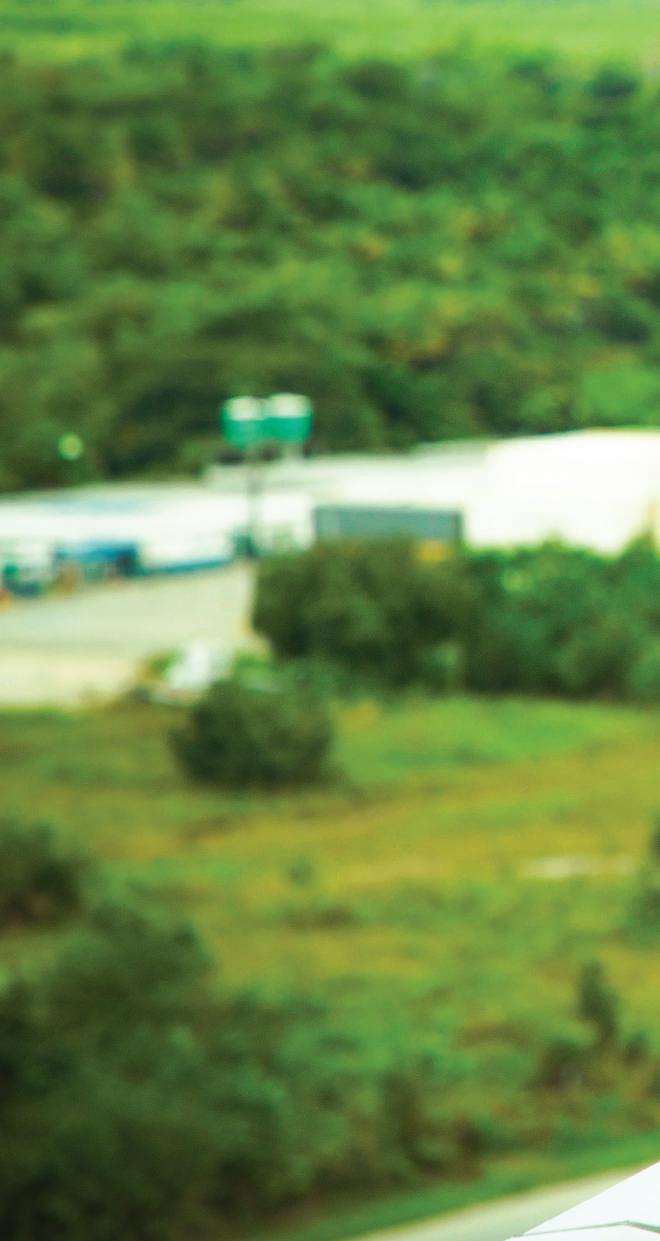
“ O impacto da internet, para mim
e para Suape, foi muito bom. E a inteligência artificial é usada de forma a facilitar os processos.”

estradas de acesso a Suape eram de terra. O acesso era feito muito mais a cavalo do que com carro ou moto.
Foi observando as práticas da época, e sempre se mostrando interessado, que Ricarte teve a chance de se inserir em um outro setor. E não apenas estar lá, mas fazer parte ativamente do processo de transformação digital de Suape. Depois de três anos na vigilância, com o aumento do porte da empresa, ele foi realocado para a área administrativa.
À época, Ricarte estava com 22 anos. Tinha um curso técnico em desenho de instalações hidráulicas e um curso de marketing incompleto - o qual precisou interromper para trabalhar. Foi parar na equipe da folha de pagamento, que ainda contava com um processo 100% manual. Como sempre gostou de matemática, isso acabou sendo um diferencial. Com quase 300 funcionários em Suape, a organização era feita por setor. No período do pagamento, um contracheque de papel era emitido para, então, o dinheiro ser depositado nas contas bancárias.
Ainda em 1989, a empresa adquiriu um sistema de contabilidade. Ricarte, que continuava se capacitando, foi convidado para fazer a implementação. Nesse processo, de -
senvolveu uma fórmula que levava em consideração hora extra, periculosidade e adicional noturno, tendo como base o salário e a gratificação do colaborador. Ricarte foi promovido a chefe da Divisão de Informática, criada concomitantemente.
- Comecei a fazer os testes e fui ajustando, sempre fazendo na máquina e de forma manual, para comparar. Até que foi dando certo e a gente deixou o manual de lado. Os avanços foram chegando.
De sistema em sistema, até a implantação da rede - funcionando de forma simultânea em todos os computadores de Suape -, contar com a tecnologia no dia a dia tornou-se um trunfo. E a transformação digital não para. Com a implementação de um novo sistema desenvolvido pela Universidade Federal de Pernambuco (UFPE), em parceria com o Centro de Estudos e Sistemas Avançados do Recife (CESAR), tudo promete ficar ainda mais dinâmico. Ricarte segue atento e acompanhando tudo bem de perto.
- O impacto da internet, para mim e para Suape, foi muito bom. E a inteligência artificial é usada de forma a facilitar os processos. Não precisa ser uma disputa entre máquina e homem.
machine: “Does not need to be a competition”
Just one year after the official opening of operations at Suape Port, in 1984, the history of the complex crossed paths with that of Manoel Ricarte – known as Ricarte within the company. The successful partnership began with a simple selection process for the security sector and has continued to grow to this day. Ricarte now works in the Department of Innovation and Digital Transformation.
Ricarte looks back over his lifetime of work at Suape as if he were talking about something that happened just a few weeks ago, and remembers how he started out, 38 years ago.
- I was working three different shifts each month, moving from the main gate to the administrative center, to seven other gates. All the access roads leading to Suape were dirt tracks. People were more likely to get there on horseback than in a car or on a motorbike.
Paying careful attention to the way things were done at the time and always showing an interest, Ricarte was given the chance to move to another sector. Not only did he move there; he became a major player in the digital transformation of Suape. The company grew in size and, after three years working in security, Ricarte was re-allocated to an administrative post.
At the time, Ricarte was 22 years old. He had completed a technical course in the design of plumbing installations and had partially completed a marketing course – although he had been forced to interrupt the latter because of commitments at work. He then joined the payroll team, where work was still 100% manual. His lifelong love
of mathematics ended up making a difference. Suape’s staff of 300 was divided into sectors. On pay day, a pay slip was issued so that money could subsequently be deposited in bank accounts.
In 1989, the company also acquired an accounting system. Ricarte, who was still in training, was invited to implement it. As part of this process, he developed a formula that calculated overtime, danger money, and night shifts, based on the salary and bonus payments of each employee. Ricarte was promoted to head of the IT Division, which was created at the same time.
- I began to try things out and make adjustments, doing things both by hand and on the machine, to compare the two. When doing things on the machine worked out well, we stopped doing things manually. We were making progress.
From system to system, until the installation of the network –working simultaneously on all the Suape computers – using technology on a daily basis was a great success. The digital transformation continues apace. The installation of a new system developed by the Federal University of Pernambuco (UFPE), in partnership with the Recife Center for Advanced Studies and Systems (CESAR), promises to make everything even more dynamic. Ricarte is closely following all these developments.
- The impact of the Internet was very good, both for me personally and for Suape. And artificial intelligence is now being used to facilitate the process. There is no need for there to be competition between humans and machines.
LUIZ HENRIQUE DA SILVA
Estivador - Docker
“Suape era um bebê que ficou gigante”
Quando Luiz Henrique da Silva começou a vida profissional como estivador, em 1983, aos 20 e poucos anos, era tudo muito diferente. Ele assistiu, ao longo do tempo, as transformações e a tecnologia avançando na beira do cais, deixando para trás, pouco a pouco, o pesadíssimo trabalho braçal de sua atividade. Essa mudança ele viveu de forma mais clara e intensa quando passou a atuar em Suape.
- Eu me considero um dos patriarcas deste porto. Suape era um bebê que ficou gigante.
Seu Luiz, como é conhecido pelos companheiros do Órgão
Gestor de Mão de Obra de Suape (OGMO), fala com propriedade. Quando migrou do Porto do Recife para Suape, existia ape-



nas o Cais de Múltiplos Usos (CMU). Era lá que ele via chegar e partir cargas como açúcar e contêineres, mas ainda de forma incipiente. Desde aquela época, acreditava que o futuro traria uma movimentação maior e mais diversificada de produtos.
- A expectativa sempre foi de melhoria, como está sendo. De mais carga para o porto. Cargas internacionais, cabotagem. E não é que chegou muito mais?
Suape é líder no Nordeste na movimentação de veículos e Luiz também participa dessa atividade no porto. Uma das suas responsabilidades é sinalizar a entrada e a saída dos
carros nos navios.
Sempre de olho no futuro, ele fez questão de se preparar para as mudanças. Tem oito cursos no currículo, entre eles o de guindaste de bordo, operador de veículos, vigia portuário, sinaleiro e contramestre-geral. Para quem viveu a época de carregar pesados sacos de cimento e de açúcar nas costas, a profissão e Suape também apontaram o caminho da modernidade.
- A estiva é a minha vida. Eu amo o meu trabalho. Aqui em Suape, o futuro é grande e promissor.
“Suape was a baby that has grown up to be a giant”
When Luiz Henrique da Silva first started working as a docker, in 1983, at the age of twenty something, it was all very different. Over time, he has seen changes and new technology being introduced at the quayside, gradually relieving him of heavy manual labor. These changes made a deep impression upon him when he came to work at Suape.
- I consider myself one of the patriarchs of this port. Suape was a baby that has grown up to be a giant.
Seu Luiz, as he is known by his workmates at Suape Workforce Management Organization (OGMO), knows what he is talking about. When he first moved from the Port of Recife to Suape, there was only one Multipurpose Quay (MPQ). It was there that he saw cargoes of sugar and containers coming and going, but things were still in their early stages. Since then, he believed that the future would bring even more business and a greater diversity of
products.
- We always expected things to get better, and they have. More cargo for the port. International cargo, cabotage. And a lot more came, didn’t it?
Suape leads the Northeast region in the shipment of vehicles and Luiz also plays a part in this. One of his responsibilities is to signal cars onto and off of ships.
Always looking to the future, Luiz makes a point of preparing for change. He has attended eight courses in total, including training as onboard crane operator, vehicle operator, port security guard, signaler, and general foreman. For someone who once carried sacks of sugar and cement on his back, his work, and Suape as a whole, have since moved much further into the modern world.
- The docks are my life. I love my work. Suape has a great future, full of promise.
Ficha Técnica / Credits
Governo do Estado de Pernambuco/ Government of the State of Pernambuco
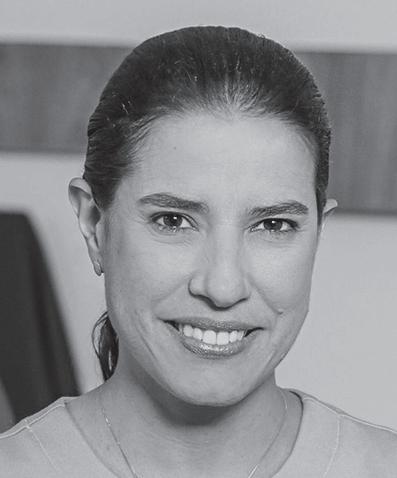
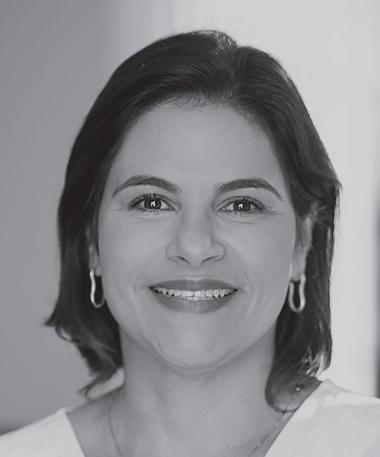

Raquel Lyra Governadora/ Governor
Empresa Suape/ The Suape Company

Paulo Sales Presidente do Conselho de Administração de Suape (Consad)/ Chairman of the Board of Directors
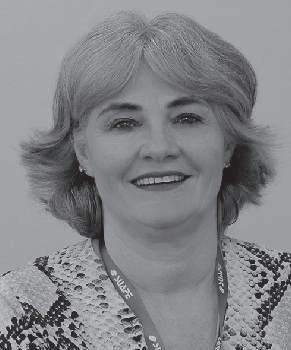
Adriana Martin Diretora de Inovação e Transformação Digital/Director of Innovation and Digital Transformation
Priscila Krause Vice-Governadora/ Lieutenant Governor

Marcio Guiot Diretor-presidente/ President-Director
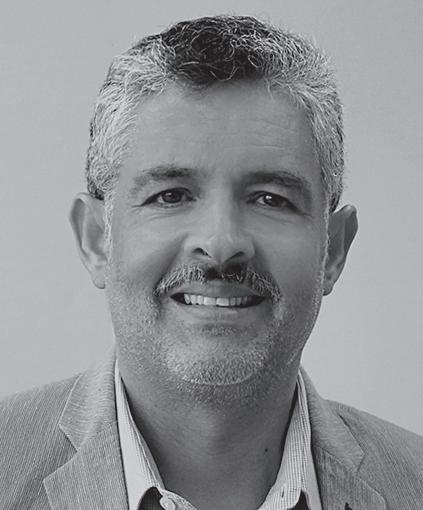
Carlos Cavalcanti Diretor de Sustentabilidade/ Director of Sustainability
Guilherme Cavalcanti Secretário de Desenvolvimento Econômico/ Secretary of Economic Development
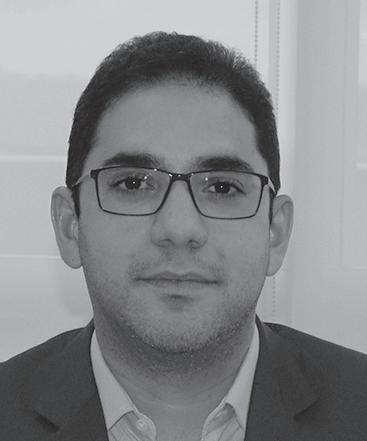
Arthur Neves Diretor de Desenvolvimento e Gestão Industrial/ Director of Development and Industrial Management
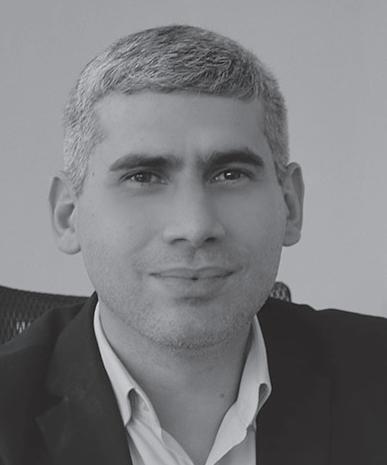
Hugo Santiago Diretor de Administração e Finanças/Director of Administration and Finance


Rinaldo Lira Diretor de Desenvolvimento e Gestão Portuária/ Director of Development and Port Management
Coordenadoria de ComunicaçãoSuape/ Coordinator of Communications - Suape

Renata Loyo Diretora de Infraestrutura/ Director of Infrastructure
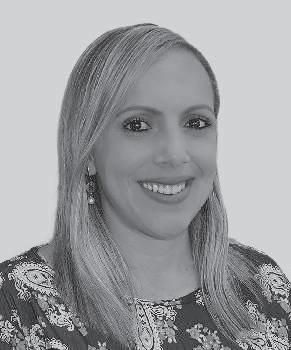
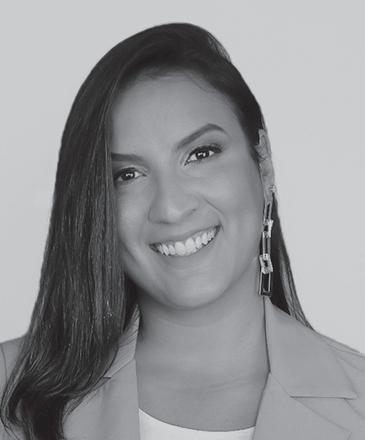
André Malagueta Coordenador de Comunicação/ Coordinator of Communications
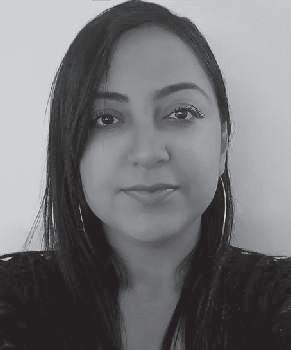
Grace Souza CoordenadoraExecutiva de Comunicação/ Executive Coordinator of Communications
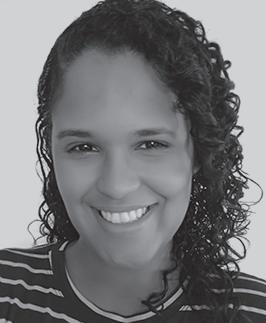
Alessandra Nogueira Assessora de Comunicação/ Communications Advisor

Danielle Coutinho Assessora Técnica de Design e Fotografia/Design technician advisor and photography
Heloíse Oliveira Assistente de Design e Fotografia/Design and Photography Assistant
Cristiana Paula Assistente Técnica Administrativo/ Technical Administrative Assistant
IMAGEM/IMAGE :
Andrea Rêgo Barros
Página/Page: 8
Banco de Imagens/Image Bank Empresa Suape/Suape Company
Páginas/Pages: 16, 17
Daniela Nader
Páginas/Pages: 55, 59, 78, 79, 81, 106, 107, 117, 119, 122, 123, 164, 165, 169, 190, 191, 192, 193, 194, 195
Danielle Coutinho/CCOM Suape
Páginas/Pages: 9, 40, 71, 92, 93, 124, 125, 126, 127, 135, 144, 147, 148, 149
Divulgação Suape
Páginas/Pages: 64, 65, 75 e 205
Érik Farias
Página/Page: 96
Heloise Oliveira/CCOM Suape
Páginas/Pages: 51, 146, 150, 151
Hugo Coutinho/Cena 2
Páginas/Pages: 86, 87, 102, 103,
141, 142, 167, 166, 167, 198, 199
Imagem Internet/ Internet
Página/Page: 34
Janaína Pepeu/Secom
Página/Page: 8
Junior Guajiro
Páginas/Pages: 46, 47
Lucas Medeiros
Páginas/Pages: 128, 129, 184 (foto 1)
Nilton Cavalcanti
Páginas/Pages: 100, 101
Priscilla D’arc
Página/Page: 138
Rafael Medeiros
Páginas/Pages: 4, 5, 12, 13, 57, 77, 80, 88, 94, 95
Rafael Reines/Cena 2
Páginas/Pages: 35, 56, 61, 62, 63, 66, 67, 68, 69, 70, 76, 84, 85, 89, 90, 91, 97, 98, 99, 109, 113, 118, 132, 133, 171, 200, 206, 207
Saulo Gregório
Páginas/Pages: 6, 7
Simone Medeiros/CCOM Suape
Página/Page: 38
Thiago Gusmão
Página/Page: 171
Thiago Neuenschwander
Páginas/Pages: 72, 73, 74, 82, 83
Víctor Giovanni/Cena 2
Páginas/Pages: 44, 45, 48, 49, 52, 53, 110, 111, 114, 115, 134, 154, 155, 158, 159, 162, 163, 184 (Foto 2), 187
Acervo Fundação
Joaquim Nabuco Coleção
Personalidades/ Joaquim Nabuco Foundation Archive/ Personalities Collection
Página/Page: 36
Coleção Secretaria de Imprensa/ Press Office Collection
Páginas/Pages: 19, 21, 24, 27, 28, 29, 31, 32, 33
Agradecimentos
Agradecemos a todos que contribuíram para a produção do livro Suape 45 anos, direta ou indiretamente. Seja por meio de entrevistas, seja com resgate de dados históricos, fotografias, revisitando experiências pessoais ou com análises e informações sobre o passado, o presente e o futuro de Suape.
Foram utilizados como fontes de referência os livros Suape, muito mais que um porto, de autoria de Carlos Garcia (in memorian) e Josué Mussalém (in memorian), e Do sonho à realidade, de autoria de Paulo Gustavo Cunha (in memorian) e Vinícius Guerreiro de Lucena.
We are thankful to all those who contributed, directly or indirectly, to this book, Suape 45 Years, through interviews, collecting historical data, providing photographs or personal memoirs, and analyzing information on the past, present, and future of Suape.
The following sources were consulted: Suape, Muito Mais Que Um Porto [Suape, Much More than a Port], by Carlos Garcia and Josué Mussalém (both in memoriam); Do Sonho à Realidade [From Dream to Reality], by Paulo Gustavo Cunha (in memoriam) and Vinícius Guerreiro de Lucena.
Capibaribe Conteúdo
Catarina Lucrécia Araújo e Daniela Nader
Projeto Editorial e Pesquisa/Editorial Project and Research
Christiano Mascaro
Projeto Gráfico e Diagramação/Graphic Design and Layout
Catarina Lucrécia Araújo e Tatiana Nascimento
Textos/Texts
Catarina Lucrécia Araújo/Capibaribe Conteúdo
Edição/Editing
Gabriela Araújo e Rostand Tiago
Colaboração e Apoio Técnico/Technical Support
Daniela Nader/Capibaribe Conteúdo
Edição de Fotografia/Photo Editing
Tatiana Nascimento
Revisão/Copyediting
Peter Ratcliffe
Tradução para o inglês/Translation into English
Nathália Matos
Tratamento de imagem/Image Treatment
Laerte Silvino
Infografia/infographic
